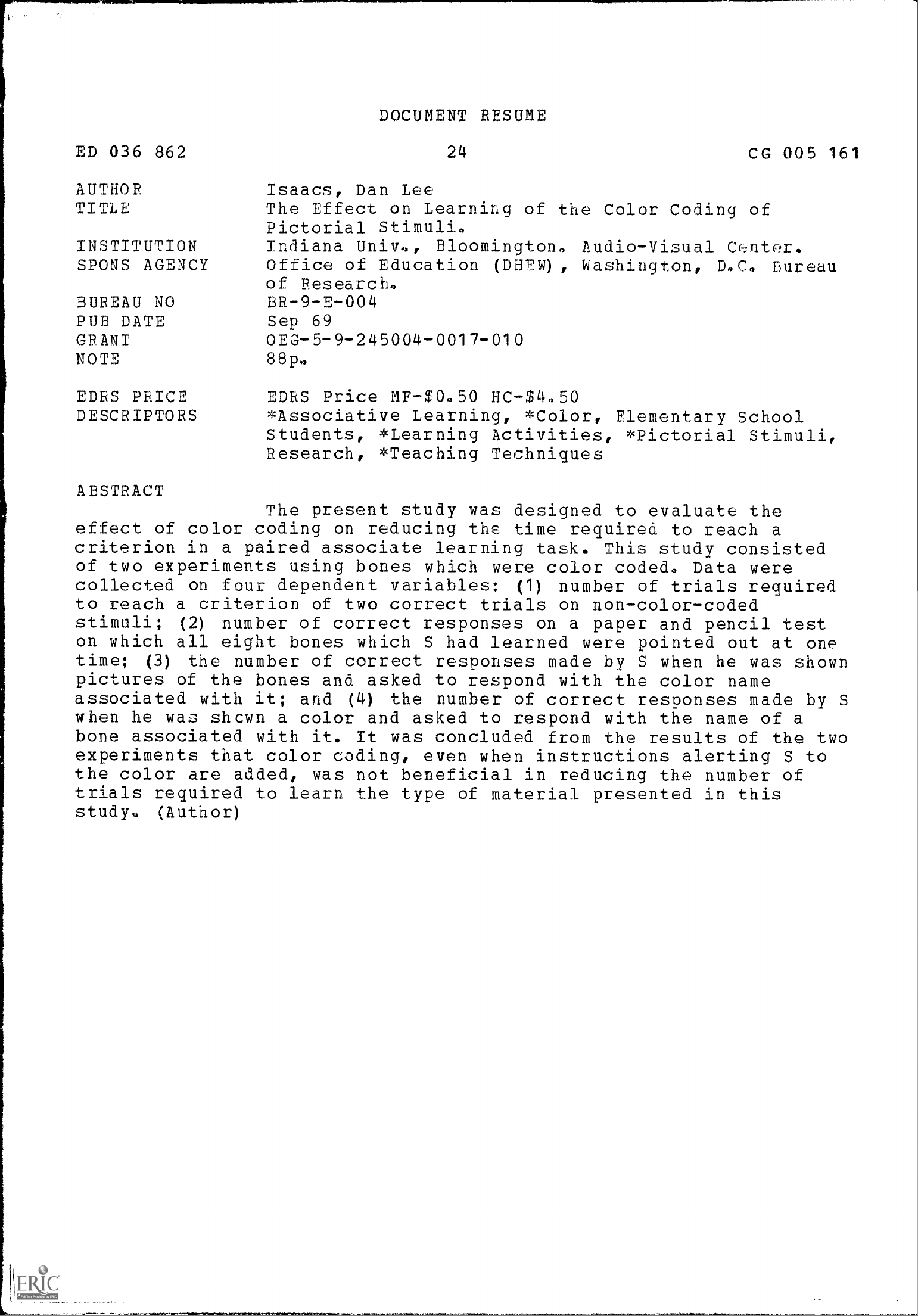
ED 036 862
AUTHOR
TITLE
INSTITUTION
SPONS AGENCY
BUREAU NO
PUB DATE
GRANT
NOTE
EMS PRICE
DESCRIPTORS
ABSTRACT
DOCUMENT RESUME
24
CG 005 161
Isaacs, Dan Lee
The Effect on Learning of the Color Coding of
Pictorial Stimuli.
Indiana Univ., Bloomington. Audio-Visual Center.
Office of Education (DHEW)
,
Washington, D.C. Bureau
of Research.
BR-9-E-004
Sep 69
OEG-5-9-245004-0017-010
88p.,
EDRS Price MF-$0.50 HC-$4.50
*Associative Learning, *Color, Elementary School
Students, *Learning Activities, *Pictorial Stimuli,
Research, *Teaching Techniques
The present study was designed to evaluate the
effect of color coding on reducing the time required to reach a
criterion in a paired associate learning task. This study consisted
of two experiments using bones which were color coded. Data were
collected on four dependent variables:
(1)
number of trials required
to reach a criterion of two correct trials on non-color-coded
stimuli;
(2)
number of correct responses on a paper and pencil test
on which all eight bones which S had learned were pointed out at one
time; (3)
the number of correct responses made by S when he was shown
pictures of the bones and asked to respond with the color
name
associated with it; and (4)
the number of correct responses made by S
when he was shcwn a color and asked to respond with the name of a
bone associated with it. It was concluded from the results of the two
experiments that color coding, even when instructions alerting S to
the color are added, was not beneficial in reducing the number of
trials required to learn the type of material presented in this
study. (Author)
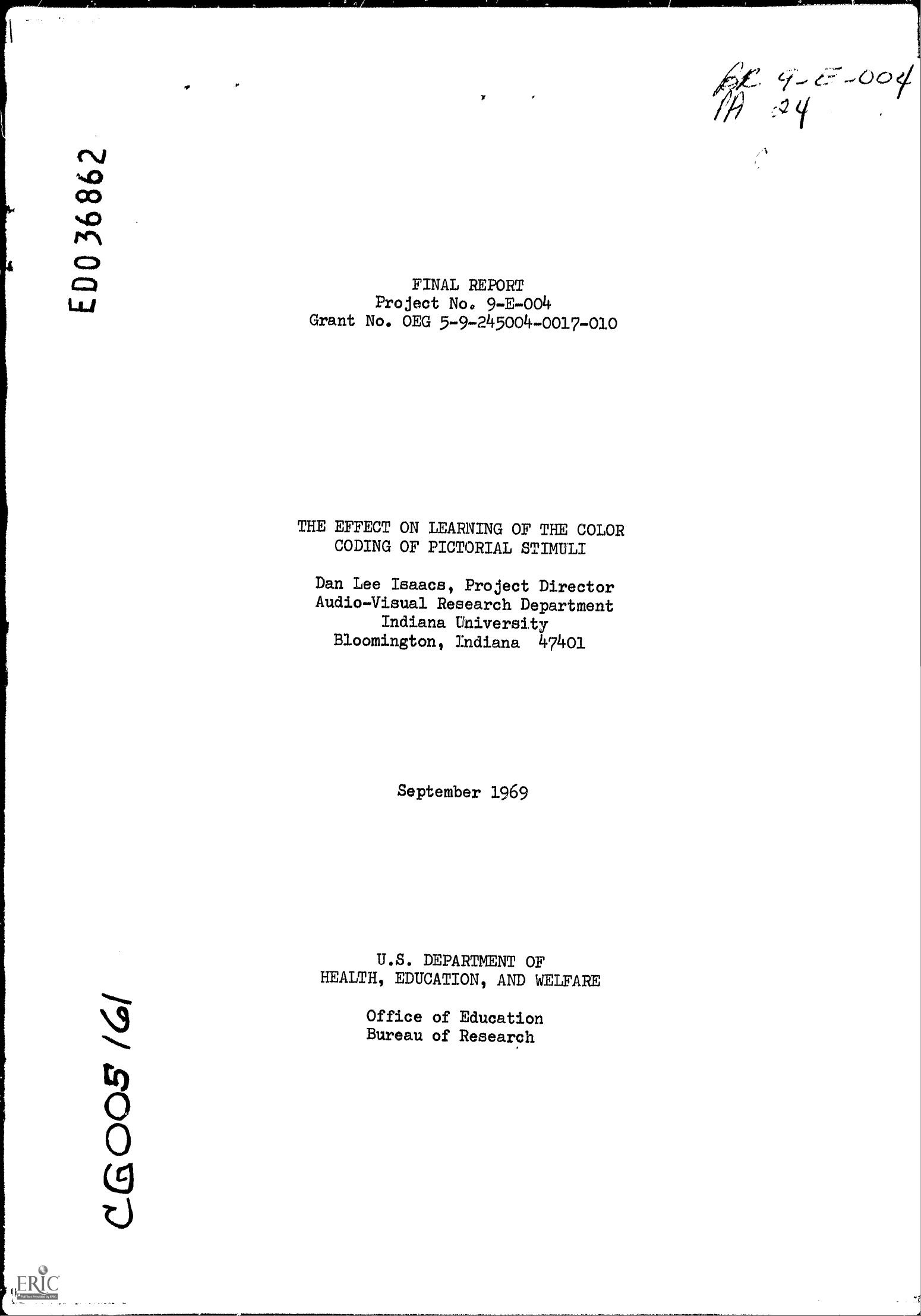
FINAL REPORT
Project No
9-E-004
Grant No. OEG 5-9-245004-0017-010
THE EFFECT ON LEARNING OF THE
COLOR
CODING OF PICTORIAL STIMULI
Dan Lee Isaacs, Project
Director
Audio-Visual Research Department
Indiana University
Bloomington, Indiana
47401
September 1969
U.S. DEPARTMENT OF
HEALTH, EDUCATION, AND WELFARE
Office of Education
Bureau of Research
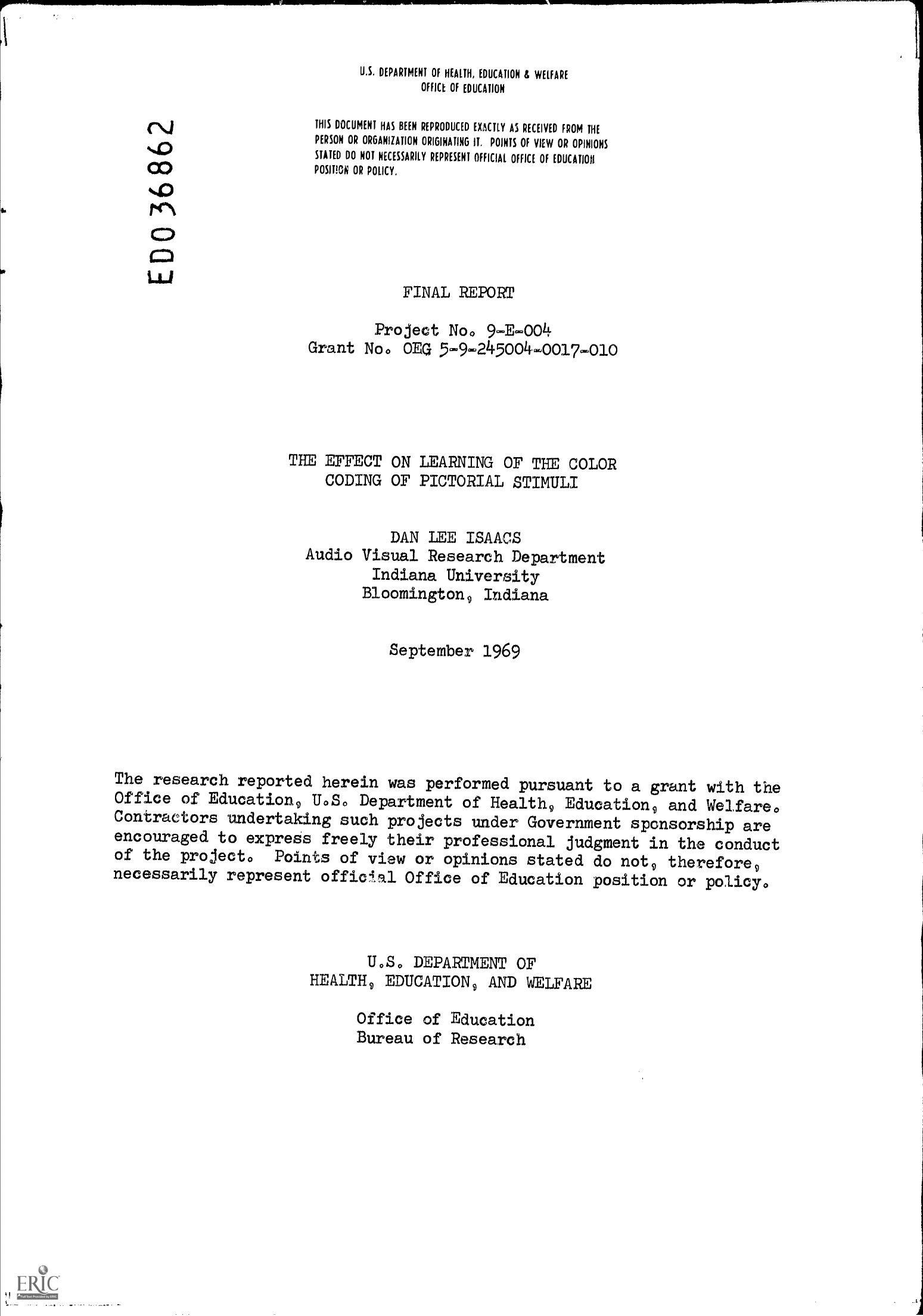
U.S. DEPARTMENT Of HEALTH, EDUCATION
& WELFARE
OFFICE OF EDUCATION
(NJ
THIS DOCUMENT HAS BEEN REPRODUCED EXACTLY
AS RECEIVED FROM THE
PERSON OR ORGANIZATION ORIGINATING IT,
POINTS OF VIEW OR OPINIONS
STATED DO NOT NECESSARILY REPRESENT OFFICIAL
OFFICE OF EDUCATION
(,E)
POSITION OR POLICY.
4%0
re1
C2)
CD
w
FINAL REPORT
Project No. 9-E-004
Grant No, OEG 5-9-245004-0017.010
THE EFFECT ON LEARNING OF THE
COLOR
CODING OF PICTORIAL STIMULI
DAN LEE ISAACS
Audio Visual Research Department
Indiana University
Bloomington9 Indiana
September 1969
The research reported herein
was performed pursuant to
a grant with the
Office of Education9 U.S.
Department of Health9 Education9
and Welfare.
Contractors undertaking such
projects under Government sponsorship
are
encouraged to express freely their
professional judgment in the conduct
of the project.
Points of view or opinions
stated do note therefore9
necessarily represent ()Meal
Office of Education position
or policy,
U.S. DEPARTMENT OF
HEALTH9 EDUCATIONS AND WELFARE
Office of Education
Bureau of Research
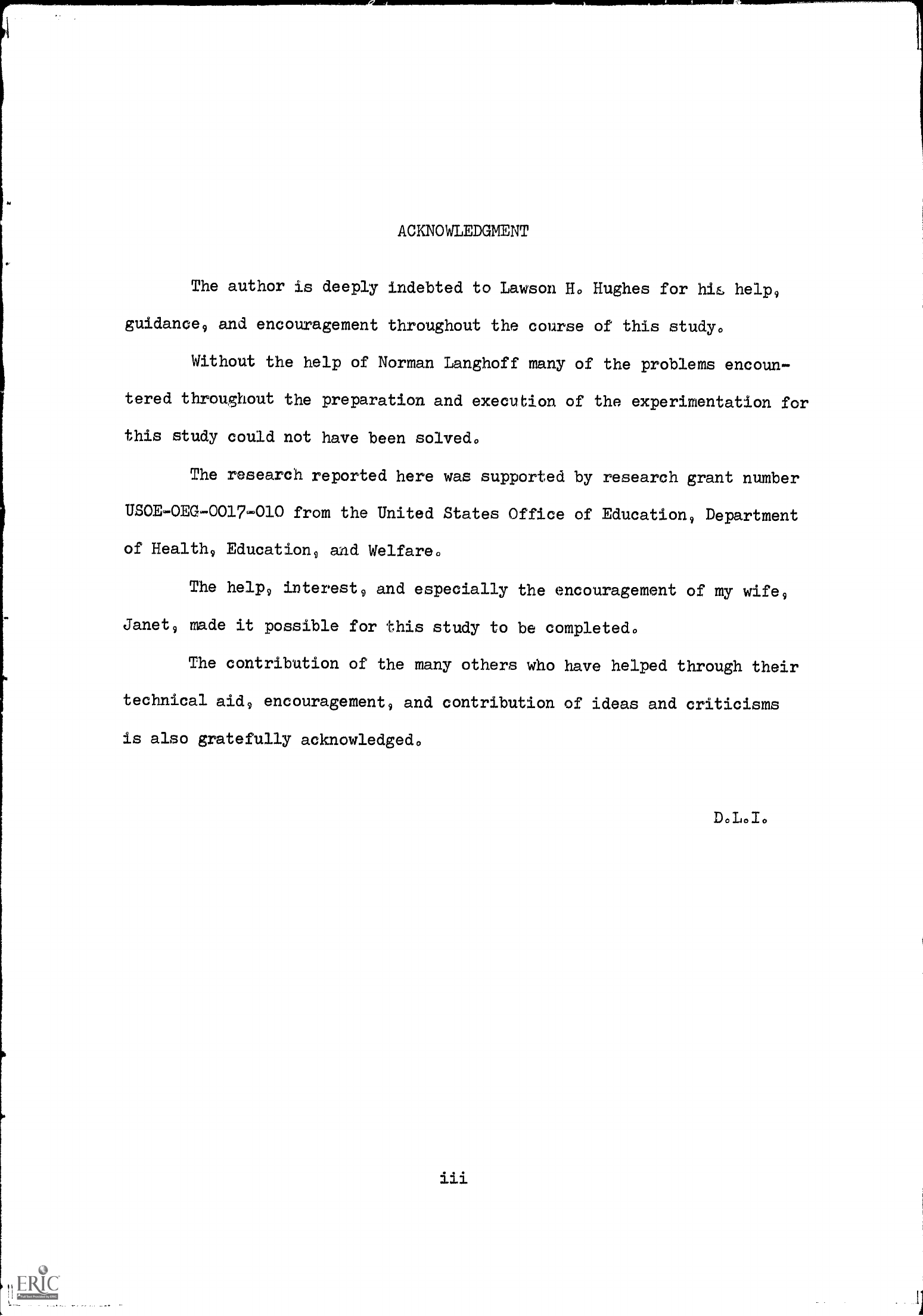
ACKNOWLEDGMENT
The author is deeply indebted to Lawson H. Hughes for hiL help9
guidance9 and encouragement throughout the
course of this study.
Without the help of Norman Langhoff
many of the problems encoun-
tered throughout the preparation and execution of the experimentation
for
this study could not have been solved.
The research reported here was supported by research grant
number
USOE-OEG-0017-010 from the United States Office of Education9
Department
of Health9 Education9 and Welfare.
The help9 interest9 and especially the encouragement
of my wife9
Janet9 made it possible for this study to be completed.
The contribution of the many others who have helped
through their
technical aid9 encouragement9 and contribution of ideas
and criticisms
is also gratefully acknowledged.
DOLOIO
iii
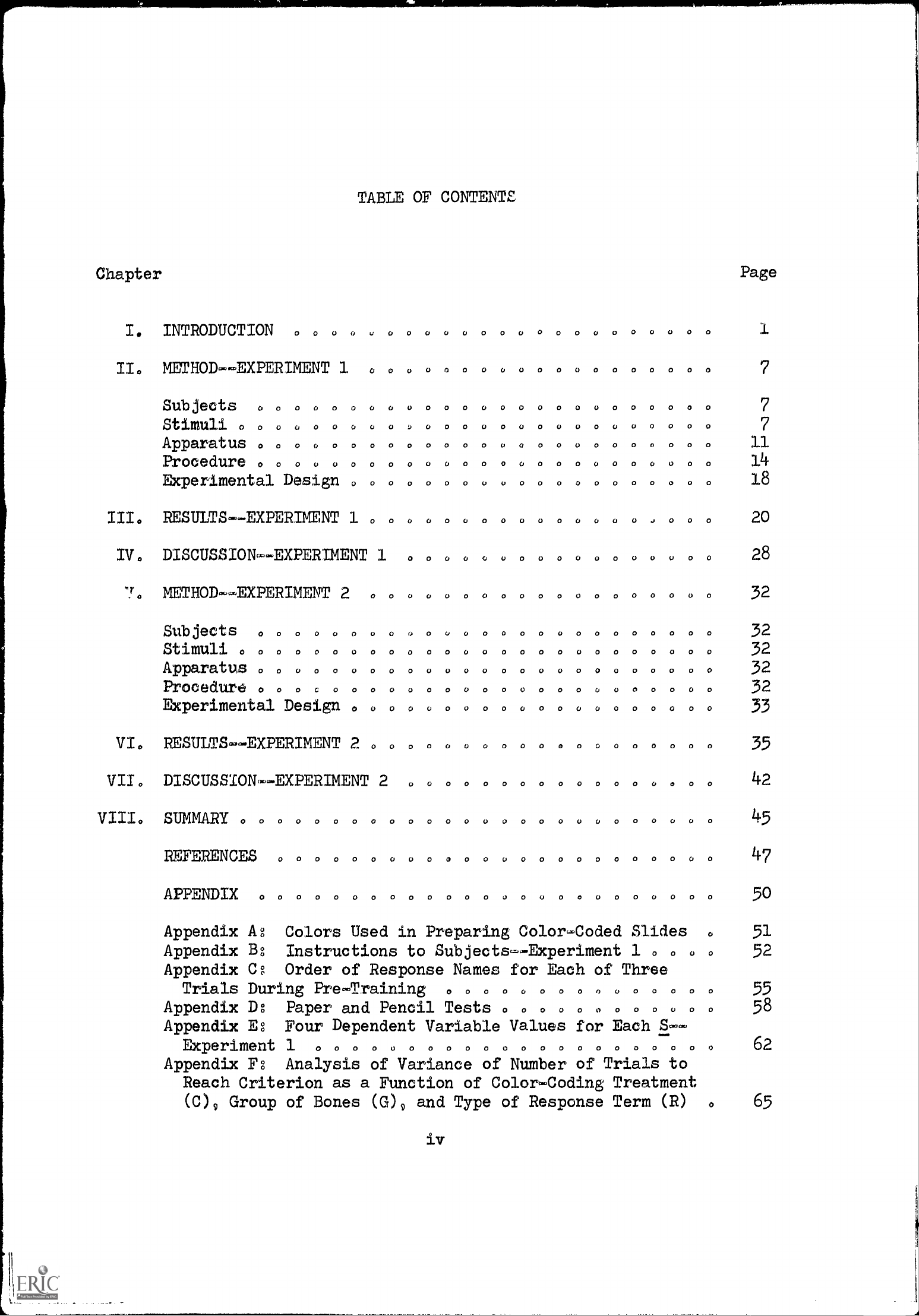
TABLE OF CONTENTE,
Chapter
I. INTRODUCTION
0
0
0 G
.
O
0 O
. .0 0 .0 0
0 .
0 0
0 0 0 0
11,,
MET HOD -- EXPERIMENT 1 0
0
0 0 0 0
0 0 0 0 0
0 0 0 0
0 0 0
Subjects
0
0 0 O
0 oo. 0
0 0 0
. 0 O 0
0 0 0 0 0
0 0 0 0
Stimuli
0 0
0 ,, 0 0 .
0 0 0 . 0
0 Cl 0 0 0
0 0 0 0 0
0 0 0 0
Apparatus
0
0
0 0 0
0 0 0
0 0 0 0 0 Cl 0 0 0 0 0
0 0 0 0 0 0
Procedure 0
0 00 0
0 0 0 0 0
. 0 0 0. 0
0 0. 0
0 . 0 0
Experimental Design
0
0 0
0 0 0 0 . . 0 0 0 0 0
0 0 0 0 0 0
III.
RESULTS--EXPERIMENT 1
0 0 0. 0
. 0 0 0 0 00 0
0 0 0 0
0
IV.
DISCUSSION--EXPERIMENT 1
00. O
o 0000000000
00
7.
METHOD--EXPERIMENT 2
0
0 0 o 0 O 0
0
o
O
O
0
0
0 0 0
0 0 (3
Subjects
C
0
0 0. 0 0 O 0 0
0 . 0 0 0 0 0
0 0 0 0 0 0 0 0
Stimuli 0
0 0 0 0 0
0
0 0 0 0 0 0 0 0 0 0 0 0
0 0 0 0 0 0 0
Apparatus
0 0 .
0
0 0 0 0 0 0 0 0 0 0 0 0 0 0
0 0 0 0 0 0 ,
Procedure
0
0 0 c 0 0 0 0 0 0 0 0 0 0 . 0 0 0 . 0
0 0 0
0 0
Experimental Design°
0 0
0 . 0 . 0 0 .
0 0 . . 0 0
0 . 0 0
VI, RESULTS--EXPERIMENT 2
0 0 0 0 . 0 0
0 0 0 0 0
0 0 0 o 0 0 0
VII. DISCUSSION--EXPERIMENT 2 0 0 0 0
0 0 0 0 0 0 0 0 0 0
0 0 0
VIII.
SUMMARY
0
0 0 0 0 0 0 0
0 0 0 0 0 0 0 0 0 0 0
0
0 0 0 .
. 0
REFERENCES0 0
0 0 0 0 . 0 0 0 0 0 . 0 0 0 0 0 0
0 0
0 . 0
APPENDIX
0
0 0 0 0 0 0 0 0 0 0 0 0 () 0
0
0 0 0
0 0 0 0 0 0
Appendix As
Colors Used in Preparing Color-Coded Slides
0
Appendix Bo
Instructions to Subjects--Experiment 1 0
0 0 0
Appendix Cg Order of Response Names for Each of Three
Trials During Pre-Training 0 0 0
0 .
0 0
0
o
.
0
0
0 0 0
Appendix D:
Paper and Pencil Tests
0
0
0 0 0 0
0 0 0
0 0 0
Appendix E:
Four Dependent Variable Values for Each 1--
Experiment
0 0 0
0
0 0 0 0 0 0 0 0
0 0 0 0
0 0 0 0 0
Appendix FO
Analysis of Variance of Number of Trials to
Reach Criterion as a Function of Color-Coding Treatment
(C)9 Group of Bones (G)9 and Type of Response Term (R)
iv
Page
7
7
7
11
14
18
20
28
32
32
32
32
32
33
35
1,45
47
50
51
52
55
58
62
65

Chapter
Page
Appendix Gs
Analysis of Variance of Number of Correct
Responses on Paper and Pencil Test as a Function of
Color-Coding Treatment (C)9 Group of Bones
(G)
9 and
Type of Response Term (R)00.00........ 0
0 0
66
Appendix Hs
Analysis of Variance of the Number
Correct Responses on the Bone-Color Test as a
of Color-Coding Treatment (C)9 Group of Bones
Type of Response Term (R)00.....000
Appendix 18
Analysis of Variance of the Number of Correct
Responses on the Color-Name Test as a Function of Color-
Coding Treatment (C)9 Group of Bones (G)9 and Type of
Response Term (R)00.0.0.000.000.00.00
Appendix dg
Instructions to Subjects--Experiment 2s
Color-Coded Conditions 000 000 00 00 0 000 00 0
Appendix Ks
Instructions to Subjects--Experiment 2g
Non-Color-Coded Conditions
Appendix Ls
Four Dependent Variable Values for Each S--
Experiment 2 00000 00 00 0 0000 00 0000 0
Appendix Mg
Analysis of Variance of Number of Trials to
Reach Criterion as a Function of Color-Coding Treatment
(C)9 and Group of Bones (G)000.0000.00.00.
Appendix Ns
Analysis of Variance of Number of Errors on
the Paper and Pencil Test as a Function of Color-Coding
Treatment (C)9 and Group of Bones (G)0000.0.00.
Appendix Os
Analysis of the Number of Correct Responses
on the Bone-Color Test as a Function of
Color-Coding
Treatment (C)9 and Group of Bones (G)00.0.0....
Appendix Ps
Analysis of Variance of the Number of Correct
Responses on the Color-Name Test as a Function of Color-
Coding Treatment (C) and Group of Bones (G) 00 0 0000
of
Function
(G)9 and
0 0
0 0
0 0
67
68
69
72
75
78
79
80
81
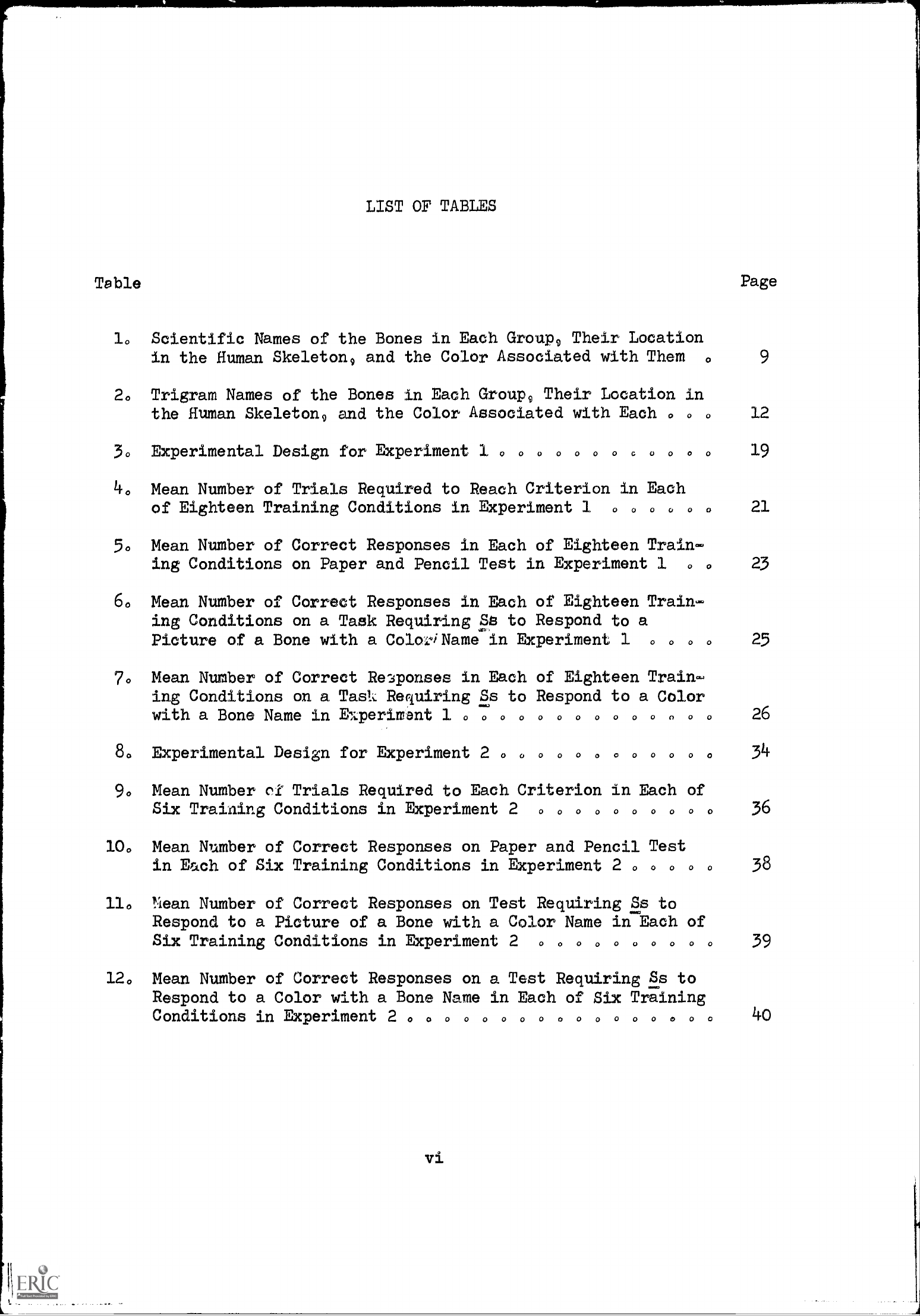
LIST OF TABLES
Table
Page
10
Scientific Names of the Bones in Each Group9 Their Location
in the Human Skeleton9 and the Color Associated with Them
0
9
20
Trigram Names of the Bones in Each Group9 Their Location in
the Human Skeleton9 and the Color Associated with Each 0
0 o
12
30
Experimental Design for Experiment 1 0 0. 0. 0 0 .. 0
. 0
19
40 Mean Number of Trials Required to Reach Criterion in Each
of Eighteen Training Conditions in Experiment 1 0
0 0 ...
21
50
Mean Number of Correct Responses in Each of Eighteen Train-
ing Conditions on Paper and Pencil Test in Experiment 1 0 0
23
60 Mean Number of Correct Responses in Each of Eighteen Train-
ing Conditions on a Task Requiring Ss to Respond to a
Picture of a Bone with a Coloi-iName in Experiment 1
0
0 0 0
25
70
Mean Number of Correct Responses in Each of Eighteen Train-
ing Conditions on a Task Requiring Ss to Respond to a Color
with a Bone Name in E%perimant 1 0 0. 0
0 0. 0
0 0 0 0 0
0
26
80
Experimental Design for Experiment 20 0
0 0 0 0 . 0 0 0 0 0
34
90
Mean Number e1 Trials Required to Each Criterion in Each of
Six Training Conditions in Experiment 2 0 . 0 . 0 0 0 0 0 0
36
100 Mean Number of Correct Responses on Paper and Pencil Test
in Each of Six Training Conditions in Experiment 2 0
0 0
0
0
38
110
!lean Number of Correct Responses on Test Requiring Ss to
Respond to a Picture of a Bone with a Color Name in Each of
Six Training Conditions in Experiment 2
0
0 00 0 0
0 0 0 0
120 Mean Number of Correct Responses on a Test Requiring Ss to
Respond to a Color with a Bone Name in Each of Six Training
Conditions in Experiment 2
0 0 0 0 0
0 0 0 0 0 0
0 0 0 0 ..
vi
39
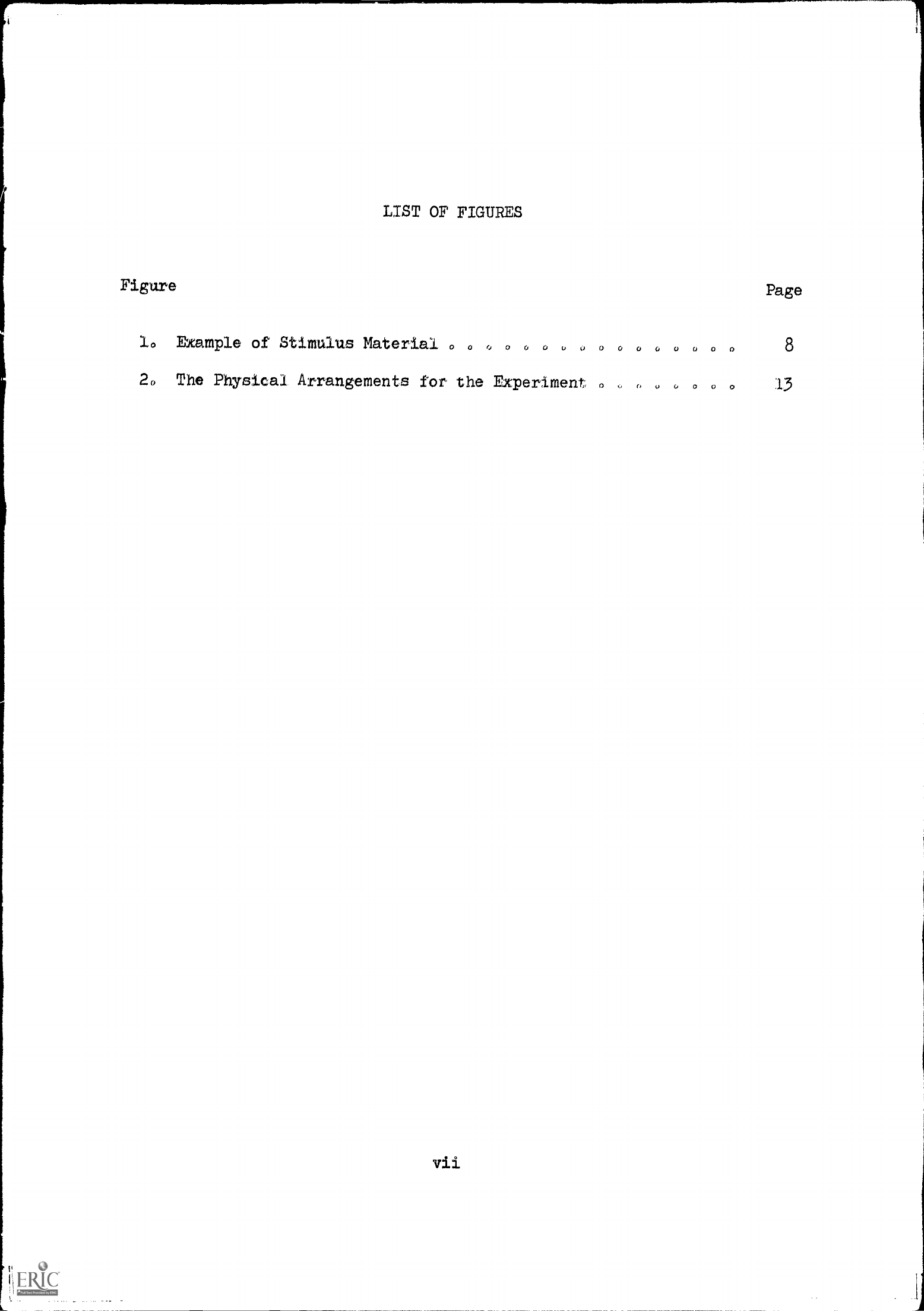
LIST OF FIGURES
Figure
Page
Example of Stimulus Material
.0.4 00 00 woo....
8
2.
The Physical Arrangements for the Experiment
0.0 0 0.
13
vii

1
CHAPTER I
INTRODUCTION
The behavioral effects of the use of color in visual displays has
been a much discussed topic in the audio-visual field,
However9 studies
in which the instructional effectiveness of materials having color cues
has been compared with the effectiveness of materials having only black
and white cues have generally produced inconsistent results,
Several
reviewers of the literature (Hoban and Van Ormer9 1950; Hoban9 1960; and
Travers9 1964) have concluded that the results of many studies are
difficult to interpret because of a failure by investigators to analyze
the role of color in 'uhe learning process.
Therefore9 in spite of con-
siderable research concerning color; the present situation seems adequately
summed up dy Dalegs (1955) observation that the educator "has precious
little to draw on" in guiding his utilization of color in the design of
edmational messages.
Although people generally express a preference
for color when both a black and white version and a color version of a
message are available to them9 there is little evidence to support the
generalization that more learning occurs when color cues are available to
them,
However9 several authors have suggested some situations in which
color might be useful,
Miller (1957) conjectured that the use of color
should be advantageous if it is one of the most relevant cues or if it can
be used to emphasize relevant cues; it should be disadvantageous if it
distracts or complicates.
McGeoch and Irion (1952) found that color can9
indeed; be useful in helping one to discriminate between relevant cues9
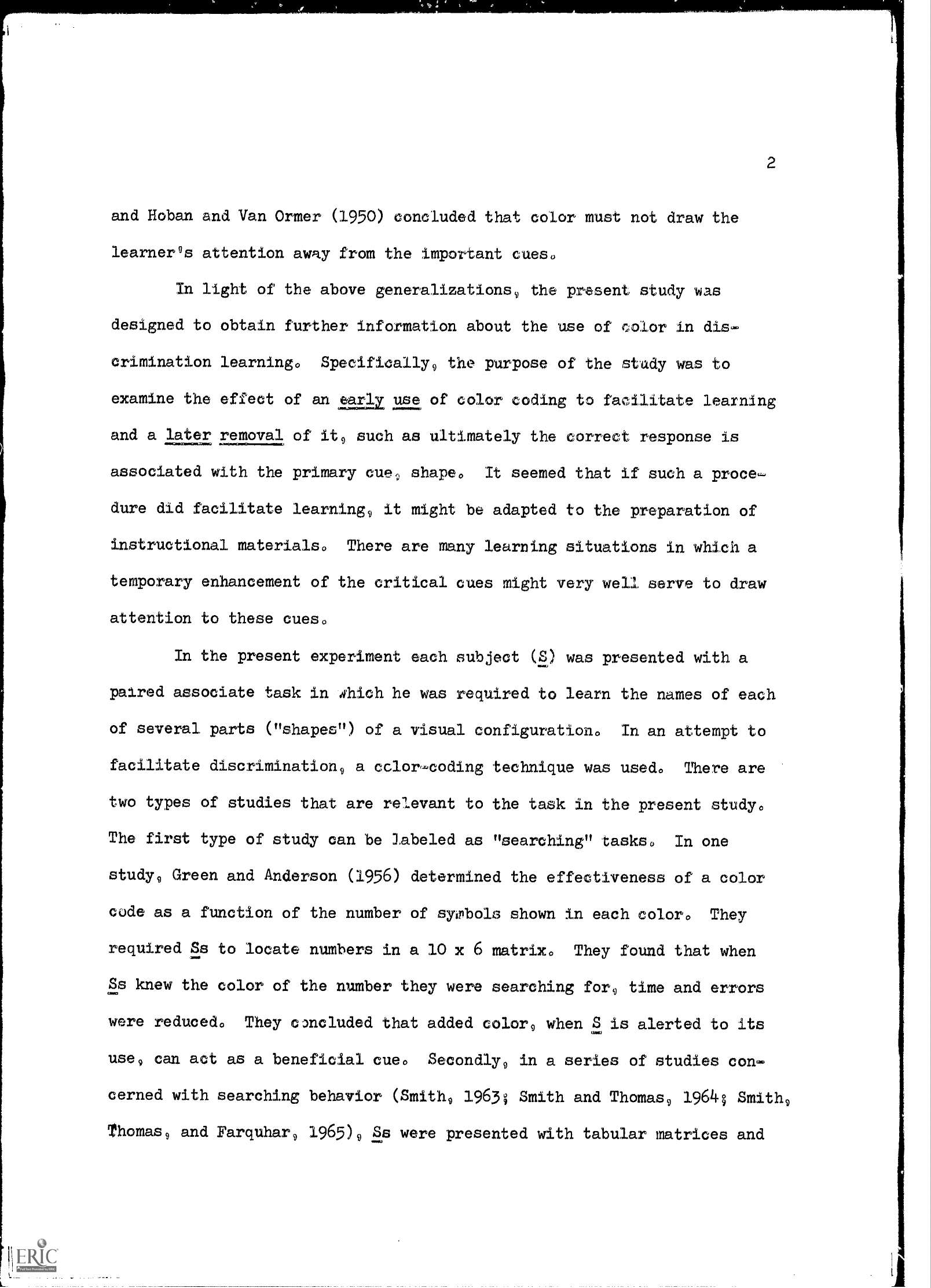
2
and Hoban and Van Ormer (1950) concluded that color must not draw the
learner's attention away from the important cues.
In light of the above generalizations9 the present study was
designed to obtain further information about the use of color in dis-
crimination learning.
Specifically9 the purpose of the study was to
examine the effect of an early use of color coding to facilitate learning
and a later removal of it9 such as ultimately the correct response is
associated with the primary cues shape.
It seemed that if such a proce-
dure did facilitate learning9 it might be adapted to the preparation of
instructional materials.
There are many learning situations in which a
temporary enhancement of the critical cues might very well serve to draw
attention to these cues.
In the present experiment each subject (S) was presented with
a
paired associate task in ihich he was required to learn the
names of each
of several parts ("shapes") of a visual configuration.
In an attempt to
facilitate discrimination9 a cclor-coding technique
was used.
There are
two types of studies that are relevant to the task in the present study.
The first type of study
can be labeled as "searching" tasks.
In one
study9 Green and Anderson (1956) determined the effectiveness of
a color
cede as a function of the number of symbols shown in each color.
They
required Ss to locate numbers in a 10 x 6 matrix.
They found that when
Ss knew the color of the number they
were searching for9 time and errors
were reduced.
They concluded that added color9 when S is alerted to its
use9 can act as a beneficial cue.
Secondly9 in a series of studies con-
cerned with searching behavior (Smith9 1963; Smith and Thomas9 1964; Smith9
Thomas9 and Farquhar9 1965)9 Ss were presented with tabular
matrices and
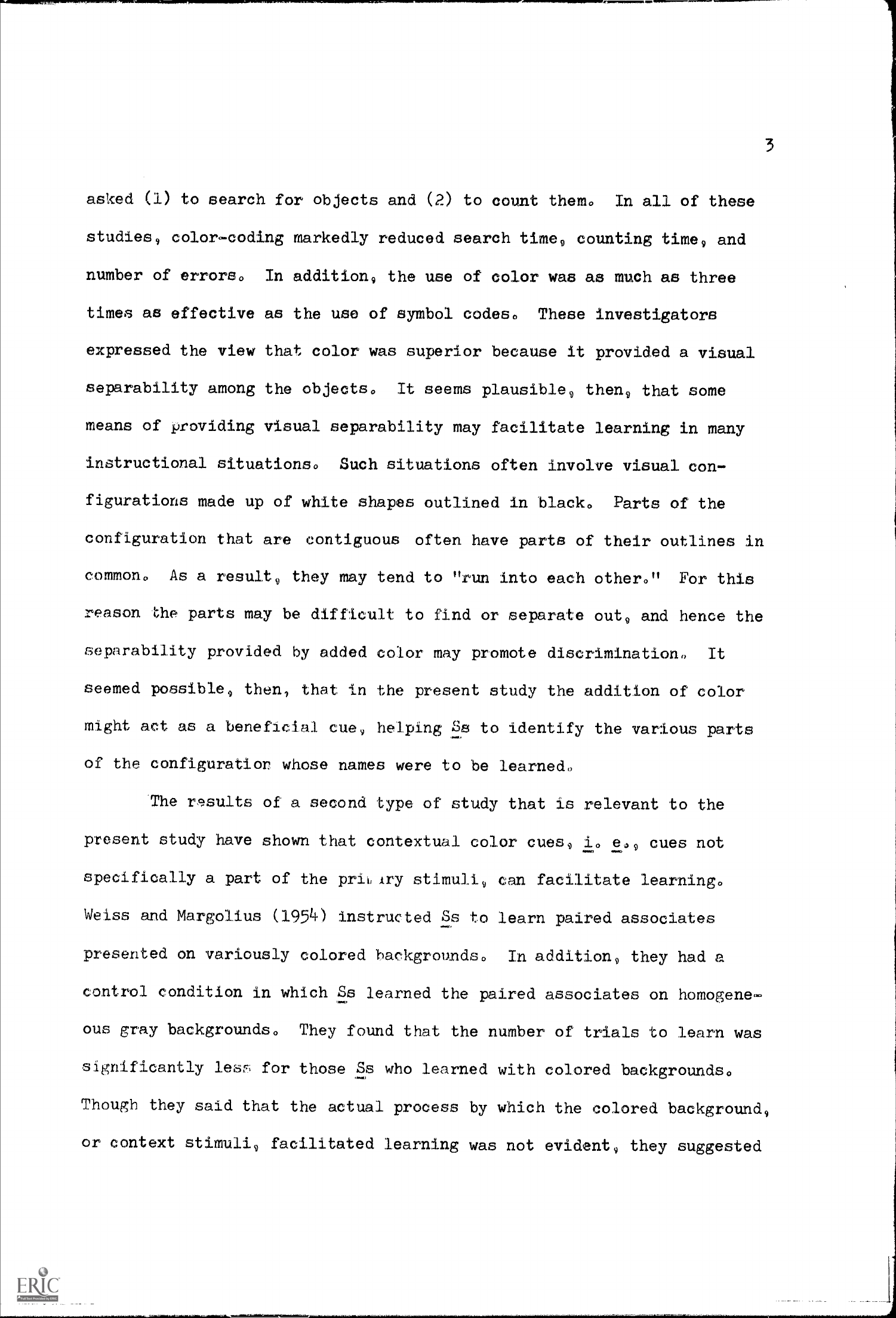
3
asked (1) to search for objects and (2) to count them.
In all of these
studies, color-coding markedly reduced search time, counting time, and
number of errors.
In addition, the use of color was as much as three
times as effective as the use of symbol codes.
These investigators
expressed the view that color was superior because it provided
a visual
separability among the objects.
It seems plausible, then, that some
means of providing visual separability may facilitate learning in many
instructional situations.
Such situations often involve visual
con-
figurations made up of white shapes outlined in black.
Parts of the
configuration that are contiguous often have parts of their outlines in
common.
As a result, they may tend to "run into each other."
For this
reason the parts may be difficult to find or separate out, and hence the
separability provided by added color
may promote discrimination.
It
seemed possible, then, that; in the present study the addition of color
might act as a beneficial cue, helping Ss to identify the various
parts
of the configuratior whose names were to be learned.
The results of a second type of study that is relevant to the
present study have shown that contextual color
cues, 1. e4, cues not
specifically a part of the
prIAAry stimuli, can facilitate learning.
Weiss and Margolius (1954) instructed Ss to learn paired
associates
presented on variously colored backgrounds.
In addition, they had a
control condition in which Ss learned the paired associates
on homogene-
ous gray backgrounds.
They found that the number of trials to learn
was
significantly lesr, for those Ss who learned with colored
backgrounds.
Though they said that the actual
process by which the colored background,
or context stimuli, facilitated learning was not evident, they suggested
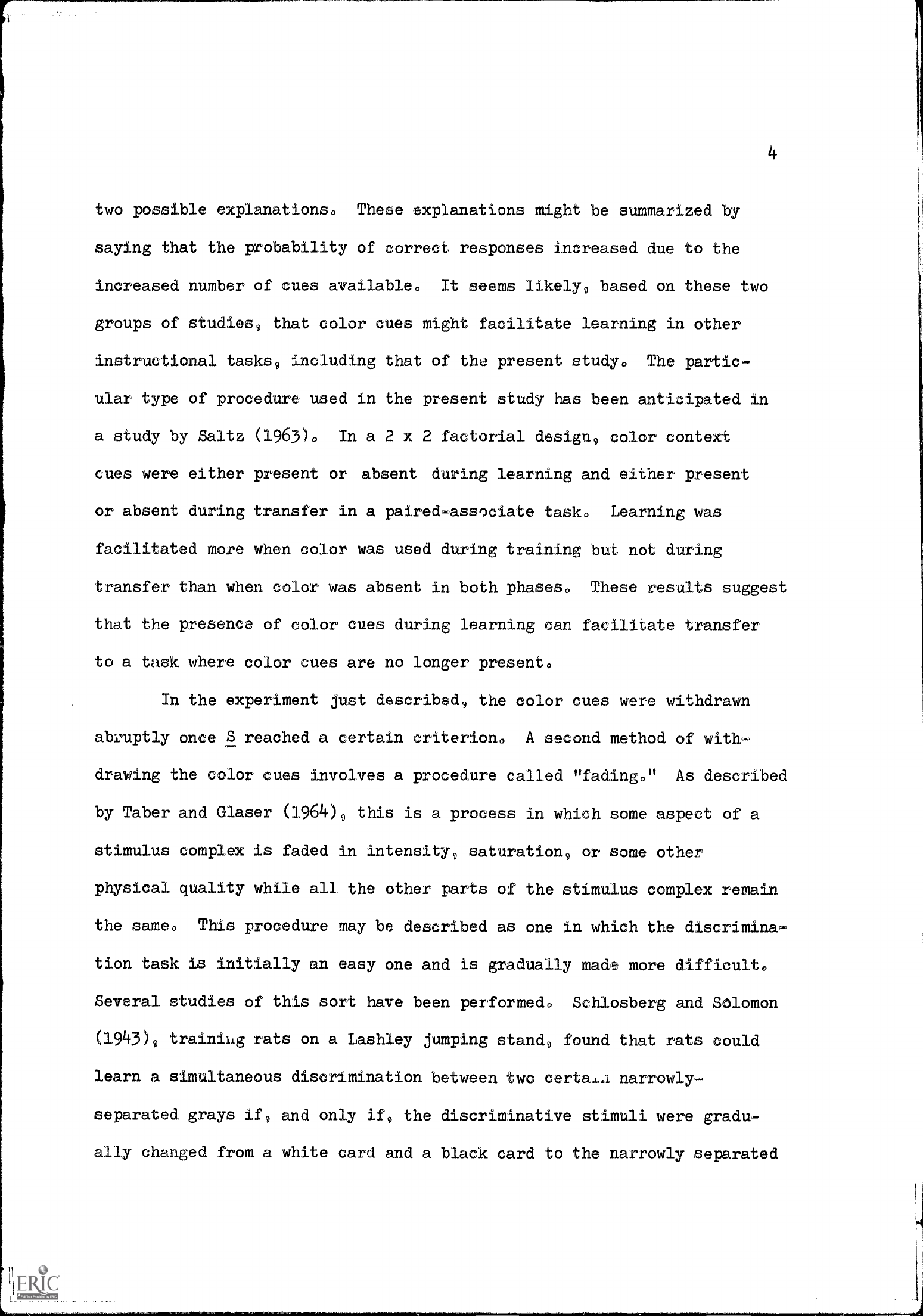
4
two possible explanations.
These explanations might be summarized by
saying that the probability of correct responses increased due to the
increased number of cues available.
It seems likely, based on these two
groups of studies, that color cues might facilitate learning in other
instructional tasks, including that of the present study.
The partic-
ular type of procedure used in the present study has been anticipated in
a study by Saltz (1963).
In a 2 x 2 factorial design, color context
cues were either present or absent during learning and either present
or absent during transfer in a paired-associate task.
Learning was
facilitated more when color was used during training but not during
transfer than when color was absent in both phases.
These results suggest
that the presence of color cues during learning can facilitate transfer
to a task where color cues are no longer present.
In the experiment just described, the color cues were withdrawn
abruptly once S reached a certain criterion.
A second method of with-
drawing the color cues involves a procedure called "fading."
As described
by Taber and Glaser (1964)9 this is a process in which some aspect of
a
stimulus complex is faded in intensity, saturation, or some other
physical quality while all the other parts of the stimulus complex remain
the same.
This procedure may be described as one in which the discrimina-
tion task is initially an easy one and is gradually made more difficult.
Several studies of this sort have been performed.
Schlosberg and Solomon
(1943)9 training rats on a Lashley jumping stand, found that rats could
learn a simultaneous discrimination between two certa.1-1 narrowly-
separated grays if
and only if
the discriminative stimuli were gradu-
ally changed from a white card and a black card to the narrowly separated
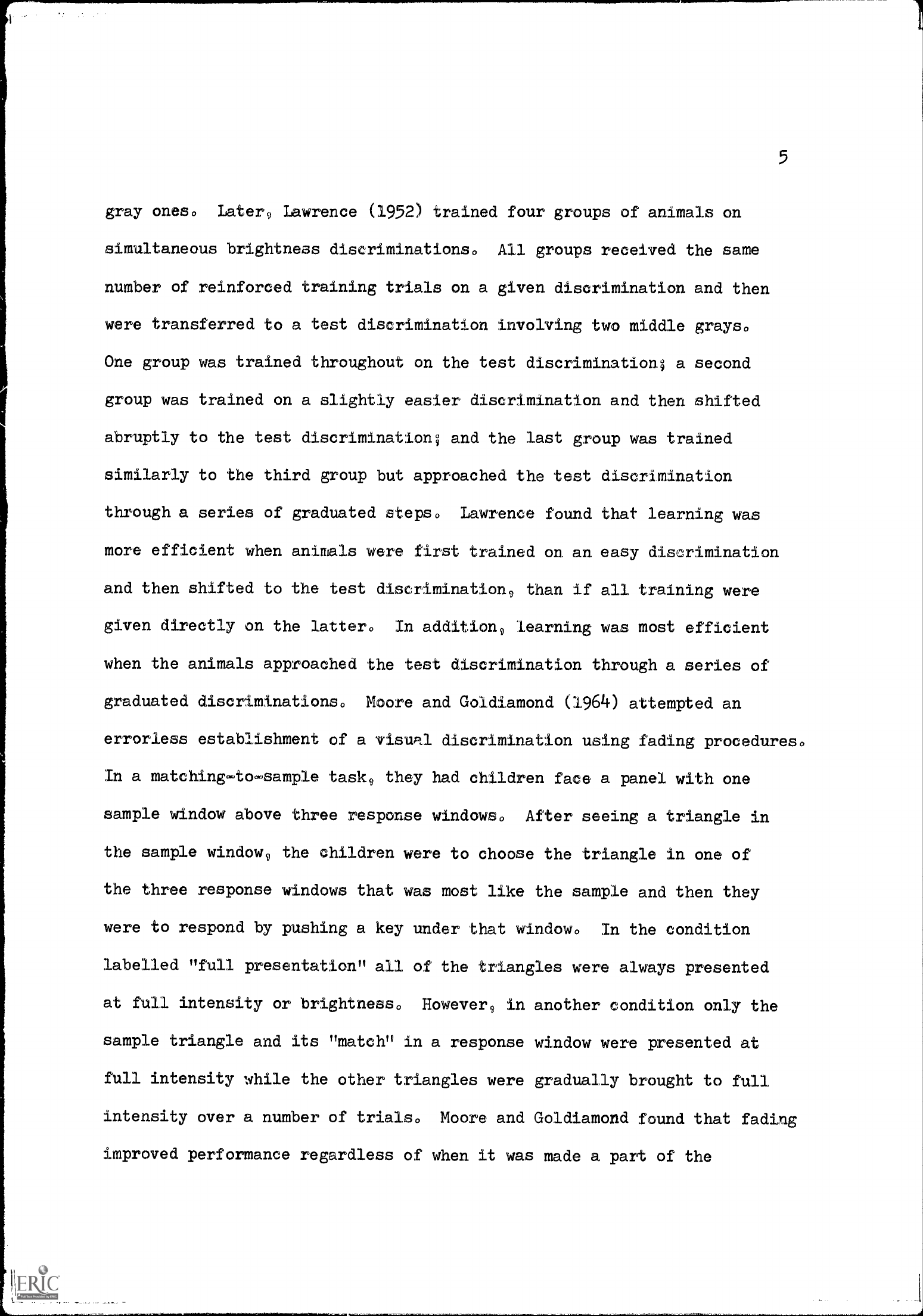
5
gray ones.
Later9 Lawrence (1952) trained four groups of animals on
simultaneous brightness discriminations.
All groups received the same
number of reinforced training trials on a given discrimination and then
were transferred to a test discrimination involving two middle grays.
One group was trained throughout on the test discrimination
a second
group was trained on a slightly easier discrimination and then shifted
abruptly to the test discrimination
and the last group was trained
similarly to the third group but approached the test discrimination
through a series of graduated steps.
Lawrence found that learning was
more efficient when animals were first trained on an easy discrimination
and then shifted to the test discrimination9 than if all training
were
given directly on the latter.
In addition
learning was most efficient
when the animals approached the test discrimination through a series of
graduated discriminations.
Moore and Goldiamond (1964) attempted an
errorless establishment of a visual discrimination using fading procedures.
In a matching-to-sample tasks, they had children face
a panel with one
sample window above three response windows.
After seeing a triangle in
the sample window9 the children were to choose the triangle in
one of
the three response windows that was most like the sample and then they
were to respond by pushing a key under that window.
In the condition
labelled "full presentation" all of the triangles were always presented
at full intensity or brightness.
However9 in another condition only the
sample triangle and its "match" in a response window
were presented at
full intensity while the other triangles were gradually brought to full
intensity over a number of trials.
Moore and Goldiamond found that fading
improved performance regardless of when it was made
a part of the

6
procedure, but that it was most effective when introduced on the first
trial.
It seemed likely, then, on the basis of the results of prior
studies that color coding, especially when color cues were "faded" over
trials, would result in Ss° learning the required task in less time than
would its similar, uncoded counterpart.
In addition, in view of the
results of Weiss and Margolius (1954) and those of Saltz (1963)i, it
appeared likely that the removal of color would result in little or no
decrement in the probability of correct responses.
However, for a coding
system to be valuable it must result in a reduced learning time.
In
other words, the duration of initial training (with color coding) added
to the duration of final training (without color coding) must be less
than for similar training that does not include a coding system.
In the
present study 1,t appeared that the procedure that would be most likely to
accomplish this would be one including color-coded stimuli in which color
was gradually faded away.
It seemed that this should not only help Ss to
discriminate the shapes but also decrease the probability of their
becoming dependent upon the color cues rather than upon the shape cues.
The present study consisted of two successive experiments.
The
second experiment was designed following the outcome of the first experi-
ment, and its purpose will be described later. The purpose of the first
experiment was to obtain answers to the following questionss
1. Does the temporary addition of color cues reduce the learning
time in a paired-associate task requiring Ss to discriminate
on the basis of shape alone?
20 Does the gradual elimination of color cues reduce learning
time mere than an abrupt elimination of them?
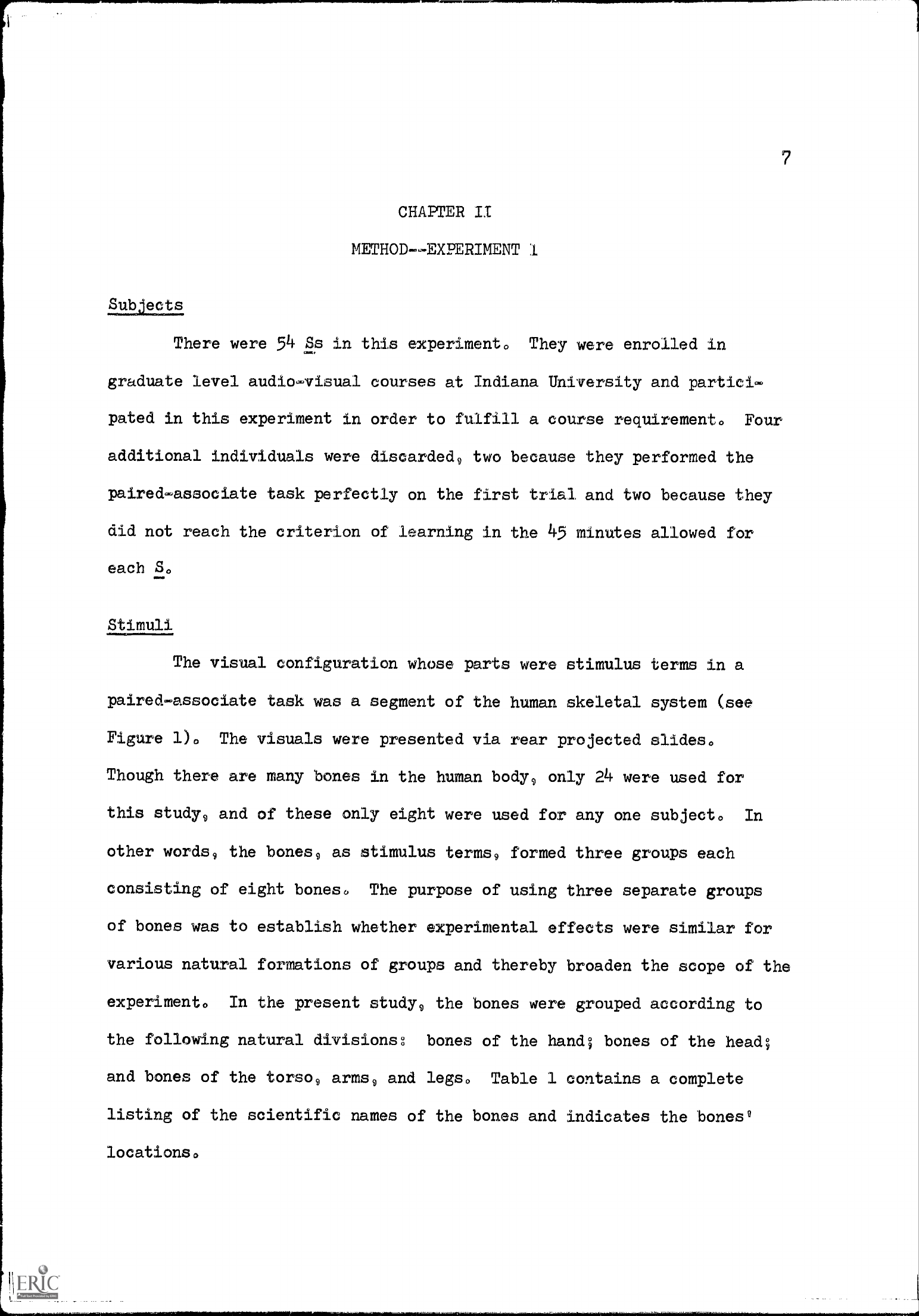
7
CHAPTER II
METHOD--EXPERIMENT 1
Sub
tPts
There were 54 Ss in this experiment.
They were enrolled in
graduate level audio-visual courses at Indiana University and partici-
pated in this experiment in order to fulfill a course requirement.
Four
additional individuals were discarded, two because they performed the
paired-associate task perfectly on the first trial and two because they
did not reach the criterion of learning in the 45 minutes allowed for
each S.
Stimuli
The visual configuration whose parts
were stimulus terms in a
paired associate task was a segment of the human skeletal system (see
Figure 1).
The visuals were presented via rear projected slides.
Though there are many bones in the human body, only 24
were used for
this study9 and of these only eight were used for any one subject.
In
other words, the bones, as stimulus terms, formed three groups each
consisting of eight bones.
The purpose of using three separate groups
of bones was to establish whether experimental effects
were similar for
various natural formations of groups and thereby broaden the
scope of the
experiment.
In the present study9 the bones were grouped according to
the following natural divisionsg
bones of the hand; bones of the head;
and bones of the torso, arms, and legs.
Table 1 contains a complete
listing of the scientific names of the bones and indicates the bone&
locations.
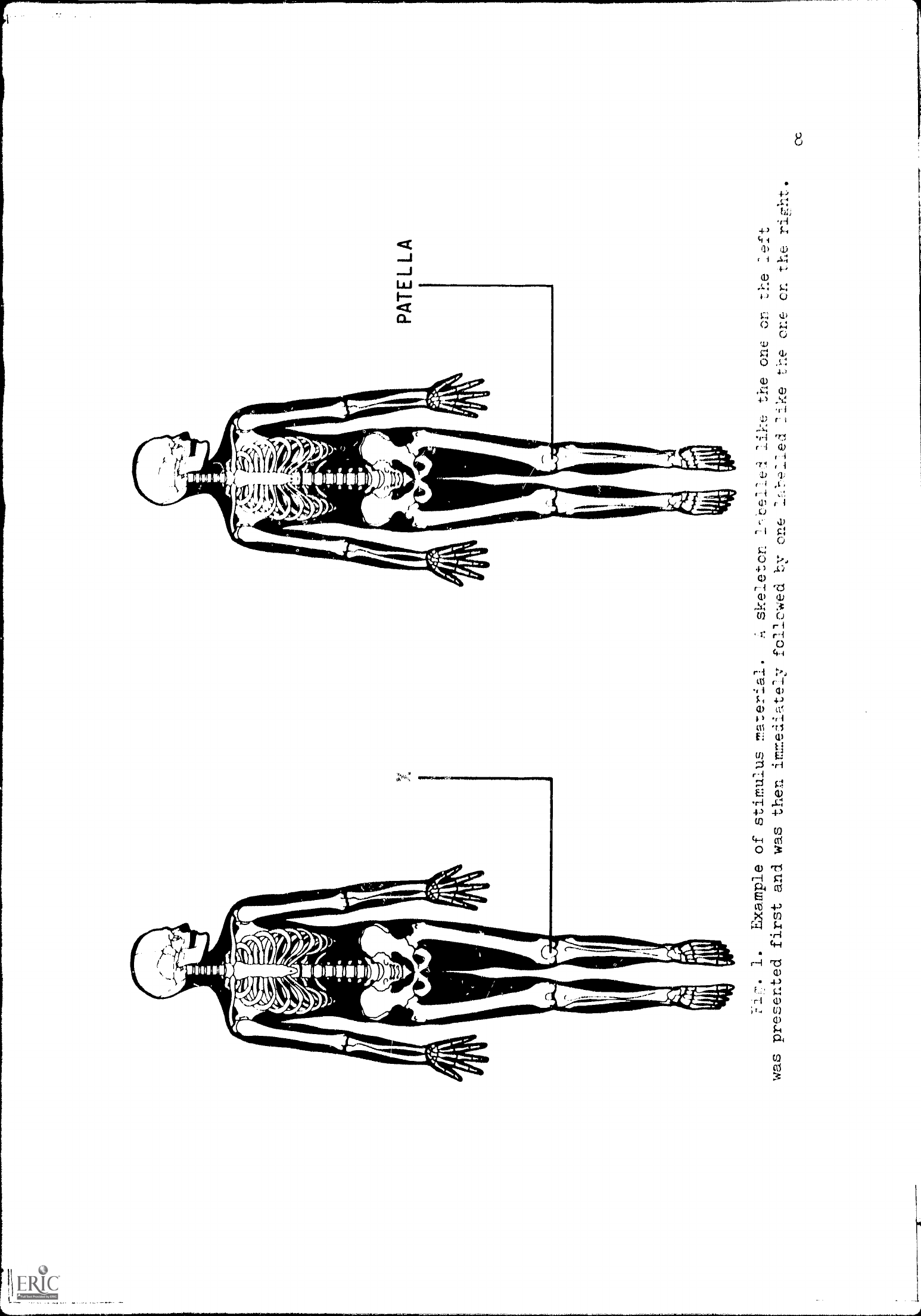
LU
0.)
a)
4-1
i-
r-
ri
(1)
ai
1,
-1
r
,L)
r- 1
g
0
4
4)
a)
r-
d)
S; ,t
CO
()
ri
1:
4,4
r-1
gl r -1
4 i
ci
4,1
(1)
)
.r I
UI
r
a)
(1)
.ri
..L44
4->
4-3
U)
(4-1
al
0
43)
Prl
r--I
ctl
UI
4-)
X
ti)
1:1:1
$.4
I-1
r-1
al
4J
ri
a)
Qa
U)
8
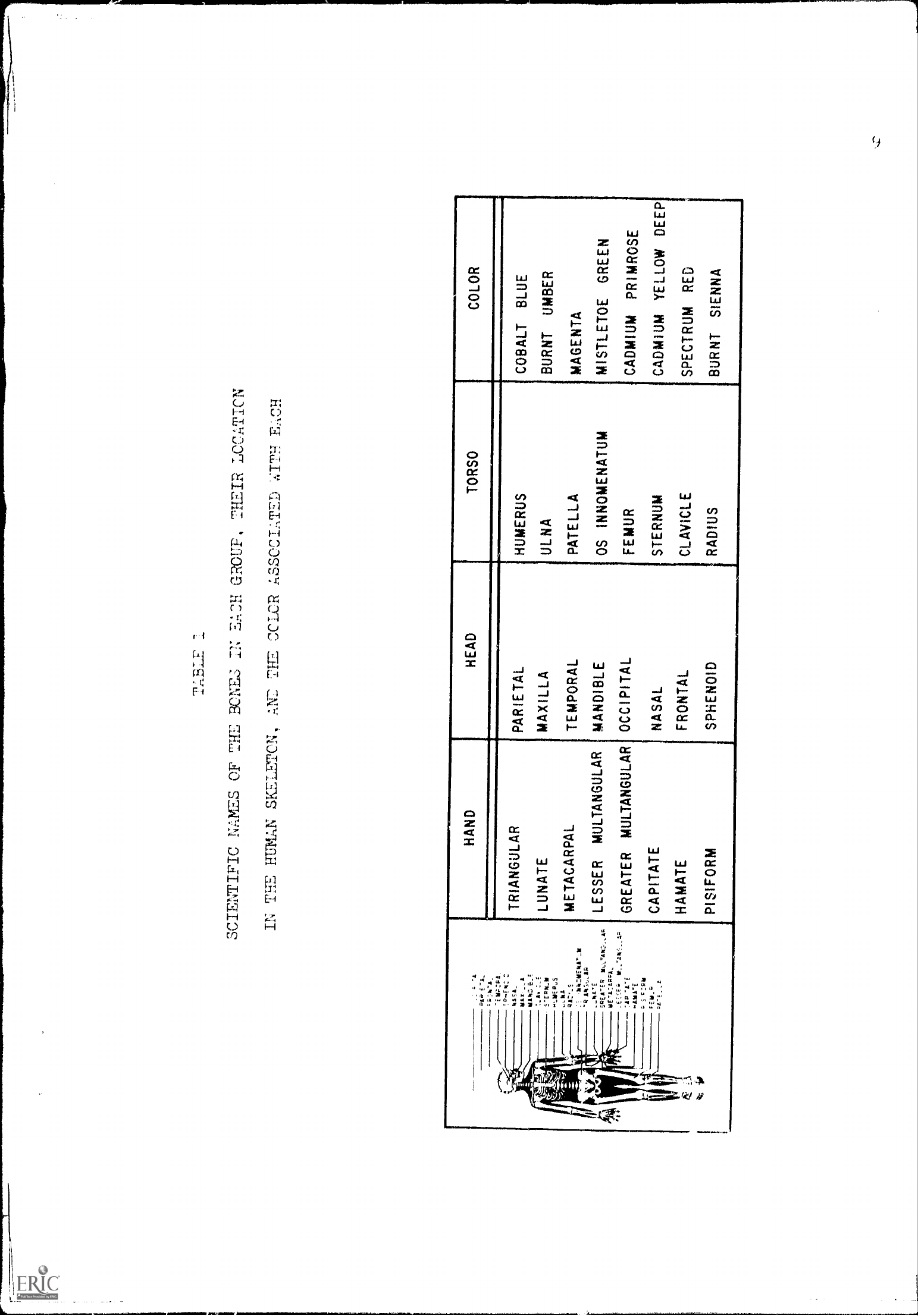
SCIENTIFIC NAMES OF THE BONES IN -1-22H
GROUP, THEIR LCCATICN
IN THE HUMAN SKELETCN, ANT 7HE CCLCR
ASSOCIi,TED
EACH
HAND
HEAD
TORSO
COLOR
.=,
4AE,
E
"I.
11_
-:41
TRIANGULAR
LUNATE
METACARPAL
LESSER
MULTANGULAR
GREATER MULTANGULAR
CAPITATE
HAMATE
PISIFORM
PARIETAL
MAXILLA
TEMPORAL
MANDIBLE
OCCIPITAL
NASAL
FRONTAL
SPHENOID
HUMERUS
ULNA
PATELLA
OS INNOMENATUM
FEMUR
STERNUM
CLAVICLE
RADIUS
COBALT BLUE
BURNT
UMBER
MAGENTA
MISTLETOE GREEN
CADMIUM PRIMROSE
CADMIUM YELLOW DEEP
SPECTRUM RED
BURNT SIENNA
il :2
..= .
I
1411C
:^._
........44;
:...Ph111
:.
-..
:-:
.
.4.0.5
.
s-
=,=,:.E.,..-.....
'4 116,,J1G
$4
w E
"L: &az-4,
,
..c..
=,-
"L':
.2
&I ;3
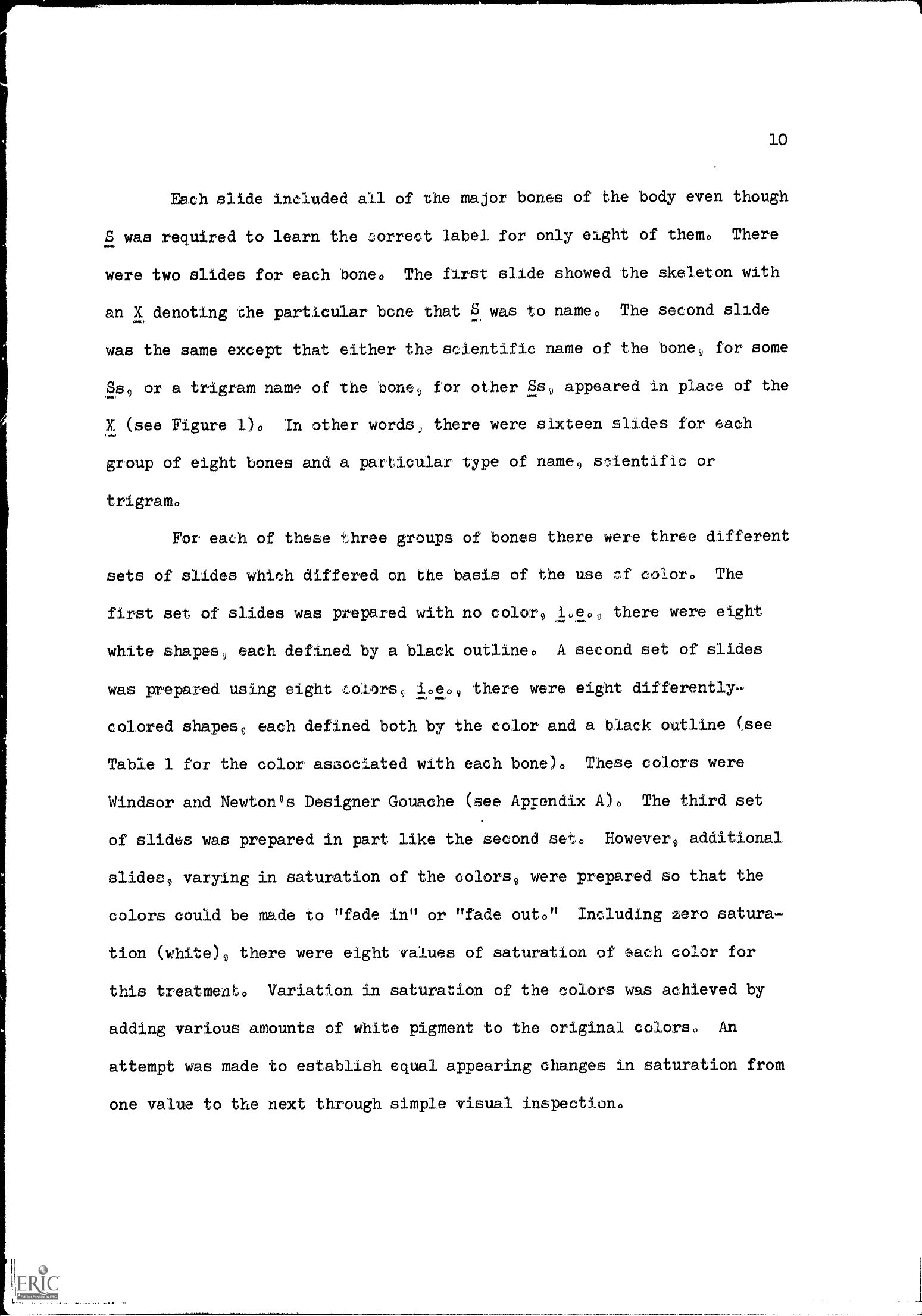
10
Each slide included all of the major bones of the body even though
S was required to learn the correct label for only eight of them.
There
were two slides for each bone.
The first slide showed the skeleton with
an X denoting the particular bone that
S was to name.
The second slide
was the same except that either the scientific name of the
bone, for some
Ss, or a trigram name of the bone, for other Ss, appeared in place of the
X (see Figure 1).
In other words, there were sixteen slides for each
group of eight bones and a particular type of name, sientific or
trigram.
For each of these three groups of bones there were three different
sets of slides which differed on the basis of the use of color.
The
first set of slides was prepared with no color, :i.e., there were eight
white shapes, each defined by a black outline.
A second set of slides
was prepared using eight colors, i.e.9 there were eight differently-
colored shapes, each defined both by the color and a black outline (see
Table 1 for the color as3ociated with each bone).
These colors were
Windsor and Newton's Designer Gouache (see Appendix A).
The third set
of slides was prepared in part like the second set.
However, additional
slides, varying in saturation of the colors, were prepared so that the
colors could be made to "fade in" or "fade out."
Including zero satura-
tion (white), there were eight values of saturation of each color for
this treatment.
Variation in saturation of the colors was achieved by
adding various amounts of white pigment to the original colors.
An
attempt was made to establish equal appearing changes in saturation from
one value to the next through simple visual inspection.
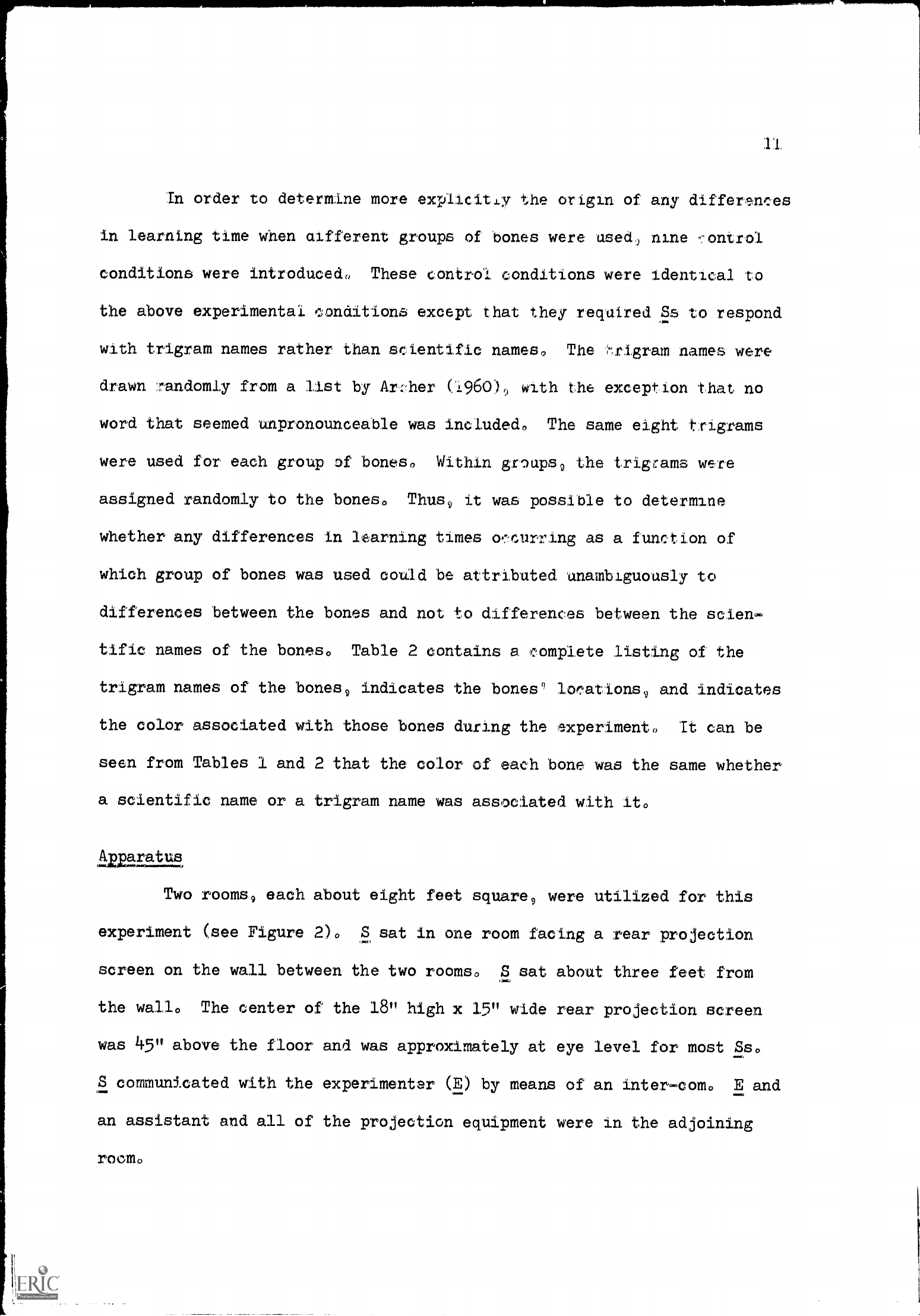
In order to determine more explicit y the origin of any differences
in learning time when aifferent groups of bones were used
nine ,:ontrol
conditions were introduced.
These control conditions were identical. to
the above experimental conditions except that they required Ss to respond
with trigram names rather than scientific names,
The 'rigram names were
drawn :randomly from a list by Anther (1960)9 with the exception that
no
word that seemed unpronounceable was included,
The same eight trigrams
were used for each group of bones,
Within groups9 the trivams were
assigned randomly to the bones,
Thus9 it was possible to determine
whether any differences in learning times cKourring as a function of
which group of bones was used could be attributed unambiguously to
differences between the bones and not to differences between the scien-
tific names of the bones,
Table 2 contains a complete listing of the
trigram names of the bones9 indicates the bones' 1oations9 and indicates
the color associated with those bones during the experiment.
It can be
seen from Tables 1 and 2 that the color of each bone was the same whether
a scientific name or a trigram name was associated with it,
Imaratus
Two rooms9 each about eight feet
square9 were utilized for this
experiment (see Figure 2)
0
S sat in one room facing a rear projection
screen on the wall between the two rooms,
S sat about three feet from
the wall.
The center of the 18" high x 15" wide
rear projection screen
was 45" above the floor and was approximately at eye level for most Ss,
S communicated with the experimenter (E) by
means of an intercom,
E and
an assistant and all of the projection equipment were in the adjoining
room,
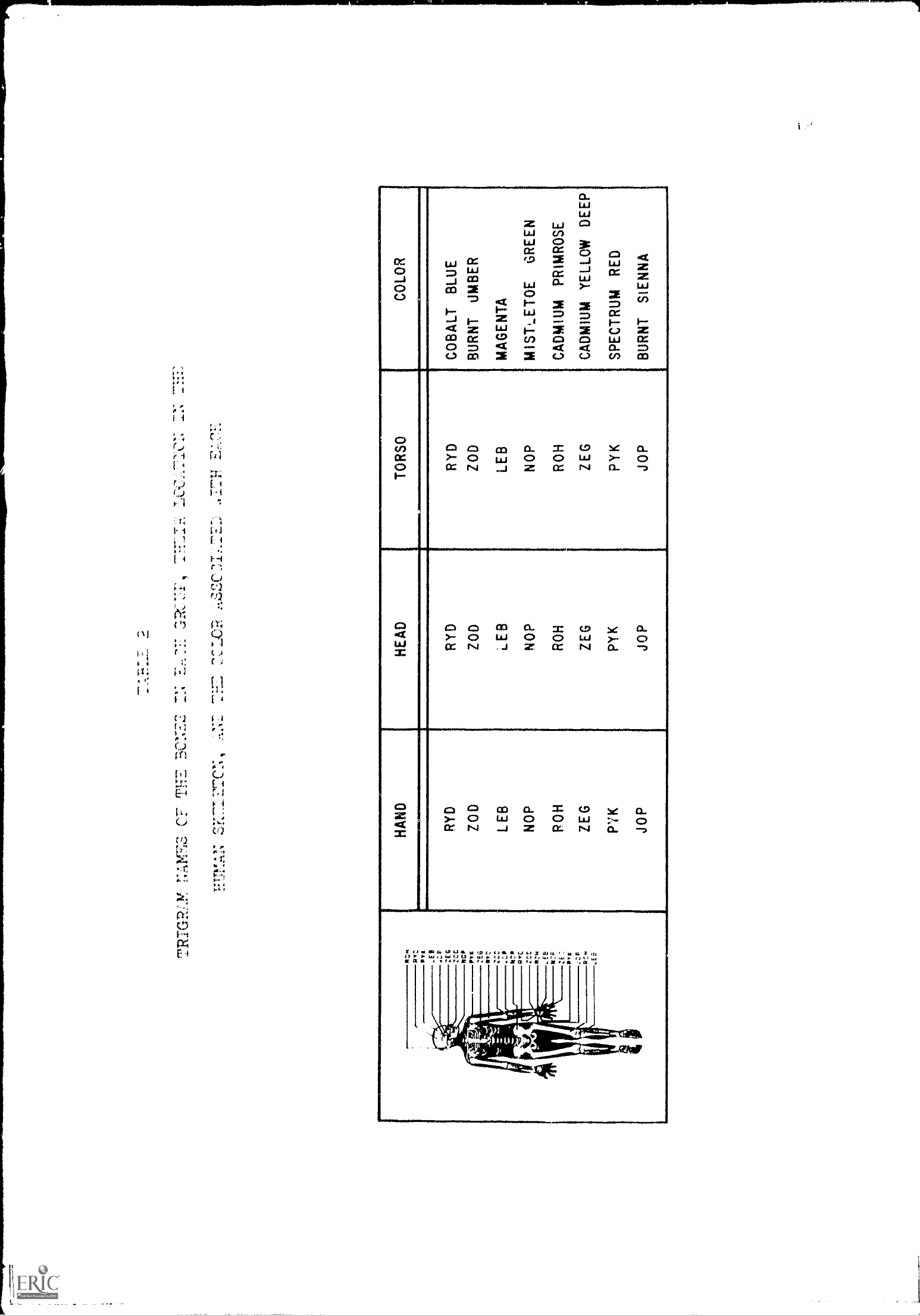
TRIGPiY
Le:"R
-
."""'
7"-s
HAND
HEAD
TORSO
COLOR
R:.
Rv:
PYR
E B
RYD
ZOO
LEB
NOP
ROH
ZEG
riK
JO P
RYD
ZOO
LEB
NOP
ROH
ZEG
PYK
JO?
RYD
Z OD
LEB
NOP
ROH
ZEG
PYK
J OP
COBALT BLUE
BURNT UMBER
MAGENTA
M I STi-ETOE
GREEN
CADMIUM PRIMROSE
CADMIUM YELLOW DEEP
SPECTRUM RED
BURNT SIENNA
.
C P
ZEG
Z. C C
NCR
.
:EG
,..
,...
Z:
..
- _
-
C
`:t
rt..:14
E...
112-
ZE
-
,
:
R:.
a:
t'
t
s.
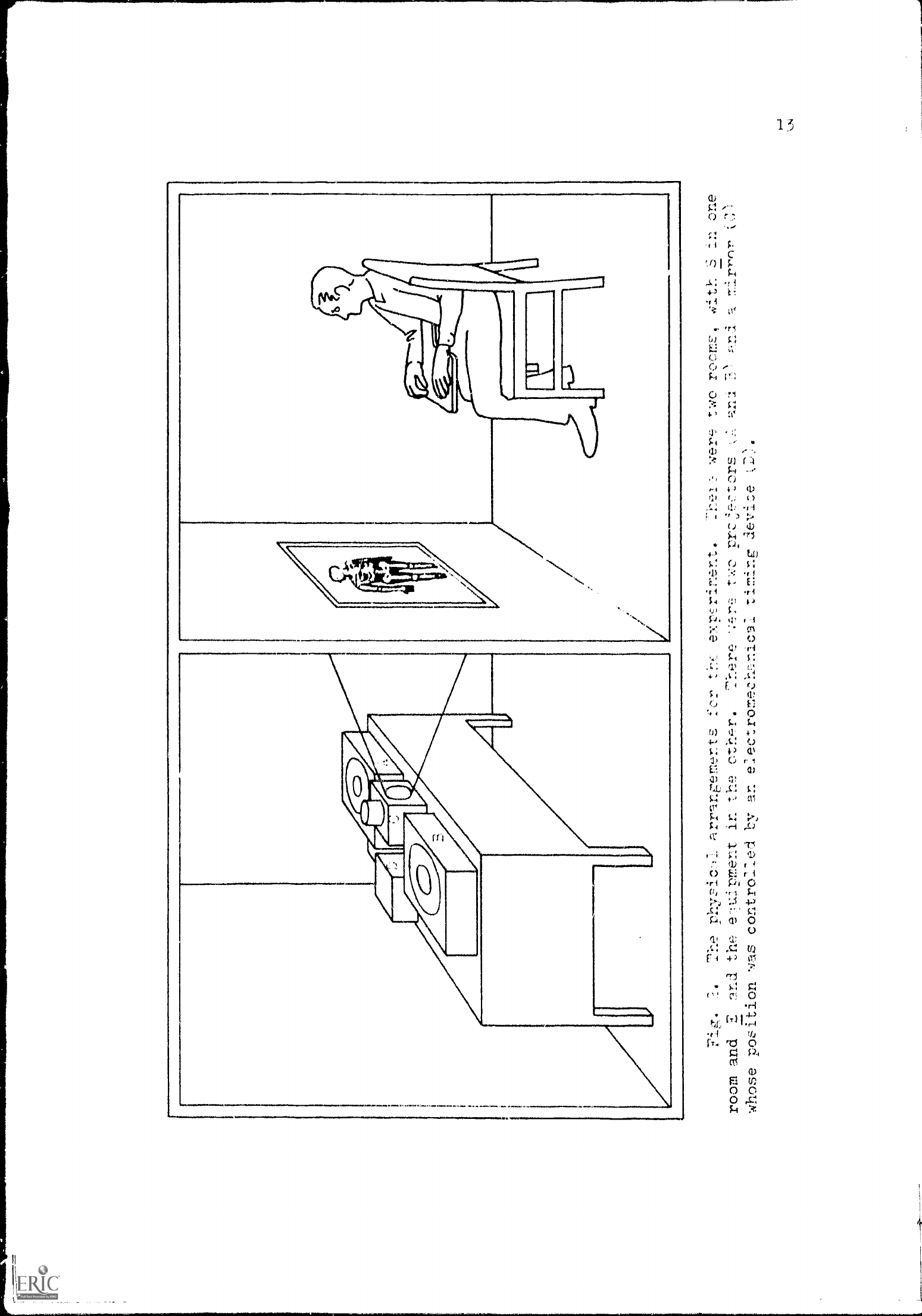
:14
:-*t (J.)
( :1
4())
(J II)
5.".44
tat)
S.!
(.)
.1)
r
4, Ei
144
to
T.4
ij,
1.
tl, f-4
1.1.? -ri
(1,)
E 4 r
I
41,
4 0
;
s.; (1.%
()
4) I!
r:
"1,i:
er;
(V
17.5
')')r
0 r 1
r1
c;i
C)
(f
4-)
.Ci
Li
(.1) 0
IH 4)
11
41
C'; 0
vr-1
1T1
uf
th
rr. TS 0
O PA
(1)
lw
V',
O CI
0
1>
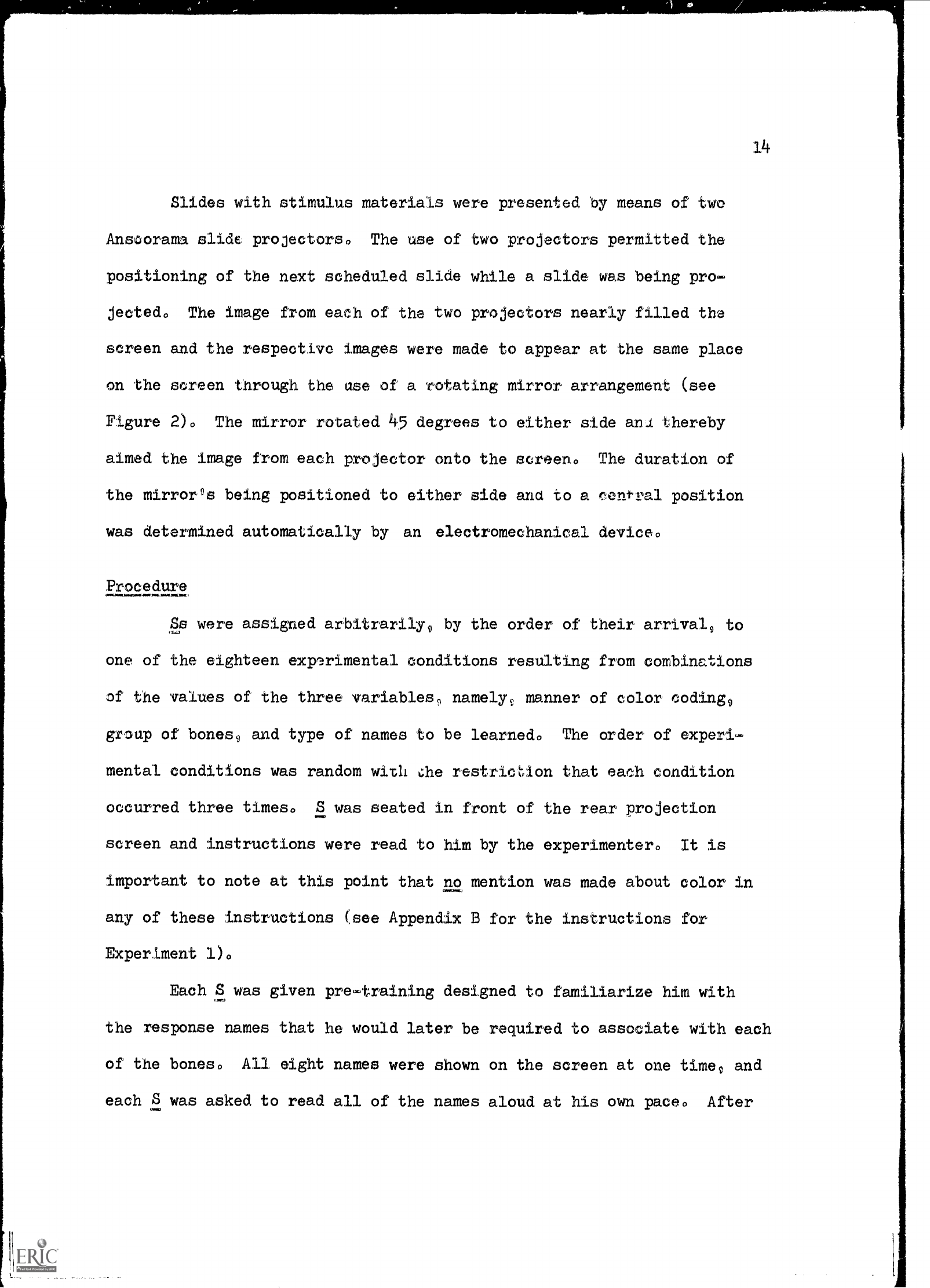
Slides with stimulus materials were presented by means of two
Anscorama slide projectors.
The use of two projectors permitted the
positioning of the next scheduled slide while a slide was 'being pro-
jected.
The image from each of the two projectors nearly filled the
screen and the respective images were made to appear at the same place
on the screen through the use of a rotating mirror arrangement (see
Figure 2).
The mirror rotated 45 degrees to either side anA thereby
aimed the image from each projector onto the screen.
The duration of
the mirrors being positioned to either side and to a c.enfral position
was determined automatically by an electromechanical device.
Procedure,
Ss were assigned arbitrarily9 by the order of their arrival9 to
one of the eighteen exinrimental conditions resulting from combinations
of the values of the three variables, namely9 manner of color coding9
group of bones9 and type of names to be learned.
The order of experi-
mental conditions was random with
he restriction that each condition
occurred three times.
S was seated in front of the rear projection
screen and instructions were read to him by the experimenter.
It is
important to note at this point that no, mention was made about color in
any of these instructions (see Appendix B for the instructions for
Exper!ment 1)
.
Each S was given pre-training designed to familiarize him with
the response names that he would later be required to associate with each
of the bones.
All eight names were shown on the screen at one time9 and
each S was asked to read all of the names aloud at his own pace.
After
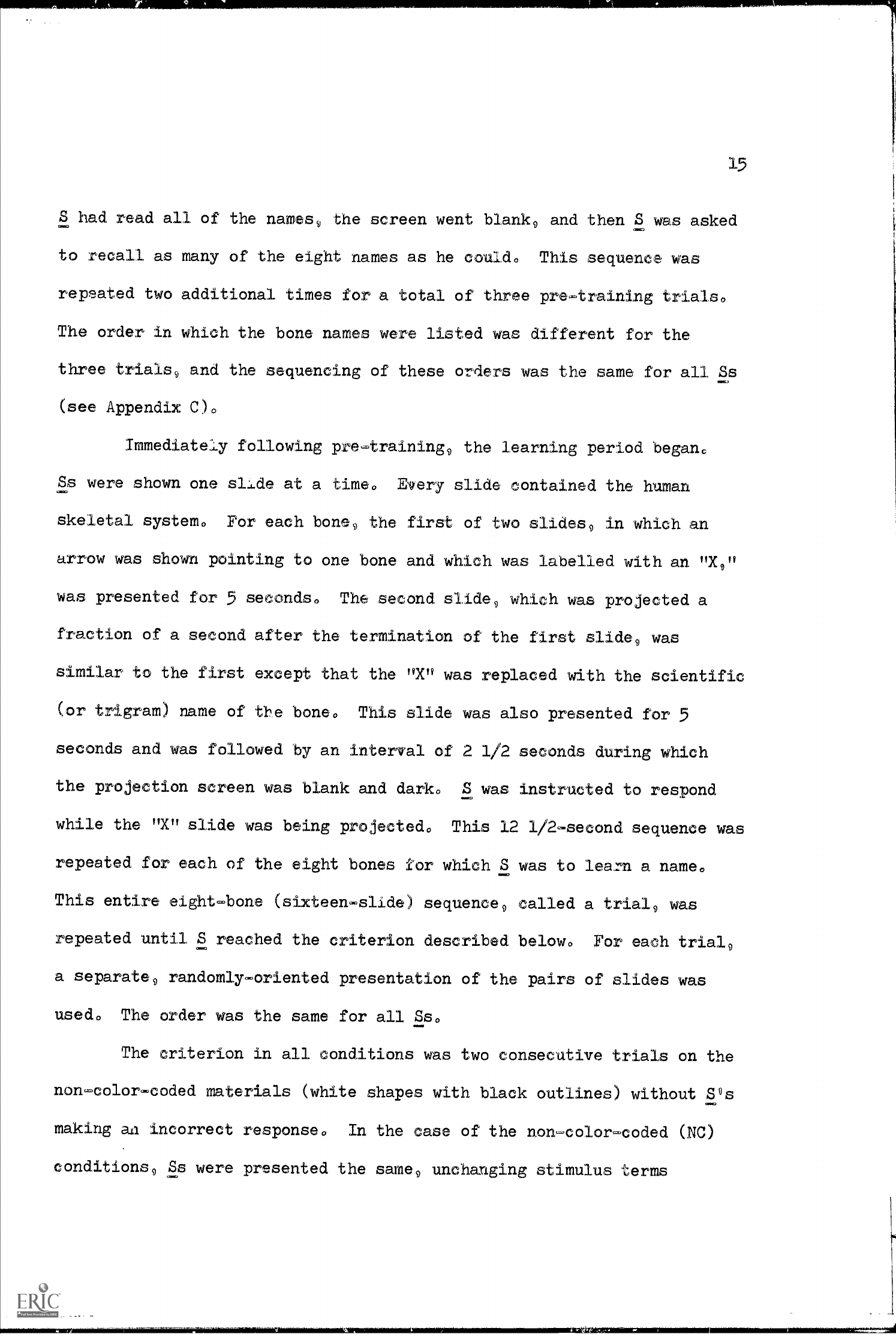
15
S had read all of the names, the
screen went blank, and then S was asked
to recall as many of the eight names as he could.
This sequence was
repeated two additional times for a total of three pre-training trials.
The order in which the bone names were listed
was different for the
three trials, and the sequencing of these orders
was the same for all Ss
(see Appendix C)
.
Immediately following pre-training, the learning period began.
Ss were shown one slide at
a time.
Every slide contained the human
skeletal system.
For each bone, the first of two slides, in which
an
arrow was shown pointing to one bone and which was labelled with
an "X,"
was presented for 5 seconds.
The second slide, which was projected a
fraction of a second after the termination of the first slide,
was
similar to the first except that the "X"
was replaced with the scientific
(or trigram) name of the bone.
This slide was also presented for 5
seconds and was followed by
an interval of 2 1/2 seconds during which
the projection screen was blank and dark.
S was instructed to respond
while the "X" slide was being projected.
This 12 1/2-second sequence was
repeated for each of the eight bones for which S
was to learn a name.
This entire eight-bone (sixteen-slide)
sequence, called a trial, was
repeated until S reached the criterion described below.
For each trial,
a separate, randomly-oriented presentation of the pairs of slides
was
used.
The order was the same for all Ss.
The criterion in all conditions
was two consecutive trials on the
non-color-coded materials (white shapes with black outlines) without
S °s
making ai incorrect response.
In the case of the non-color-coded (NC)
conditions, Ss were presented the
same, unchanging stimulus terms

16
throughout the learning period.
In the case of the two color-coded
conditions, however, Ss were initially presented color-coded shapes;
but eventually the color was withdrawn so that they were required to
respond to non-color-coded stimuli and to reach a criterion of two
consecutive correct trials on the non-color-coded material.
In one of
the color-coded conditions (CC), S was presented color-coded materials
until he could correctly name all eight bones on a single trial before
he was shifted to the black and white shapes.
In the second color-coded
treatment (CCF)9 the colors of all of the bones "faded in" or "faded out"
on each new trial, depending on the total number of errors the subject
had made on the preceding trial.
It was expected, however, that, over
trials, the colors would fade out completely.
In fact, this was the
case for all Ss under this treatment.
On the trial following each
trial on which S made n more correct responses than on the previous trial,
the color faded n steps; while on the trial following er.ch trial
on which
S made n less correct responses than on the previous trial, the satura-
tion increased n steps.
The color-coding disappeared completely begin-
ning with the trial following the one on which S made
no more than one
error.
At that point the stimuli became identical with those in the NC
treatment.
However, if S again made more than one error, the coding would
return and would fade in or out as it had previously.
As in the other
conditions, the criterion was two correct consecutive trials
on black and
white shapes.
It seemed of interest to test for transfer of what had been
learned to a situation similar to common academic tests.
Therefore,
after reaching the criterion, each S was asked to perform a paper and
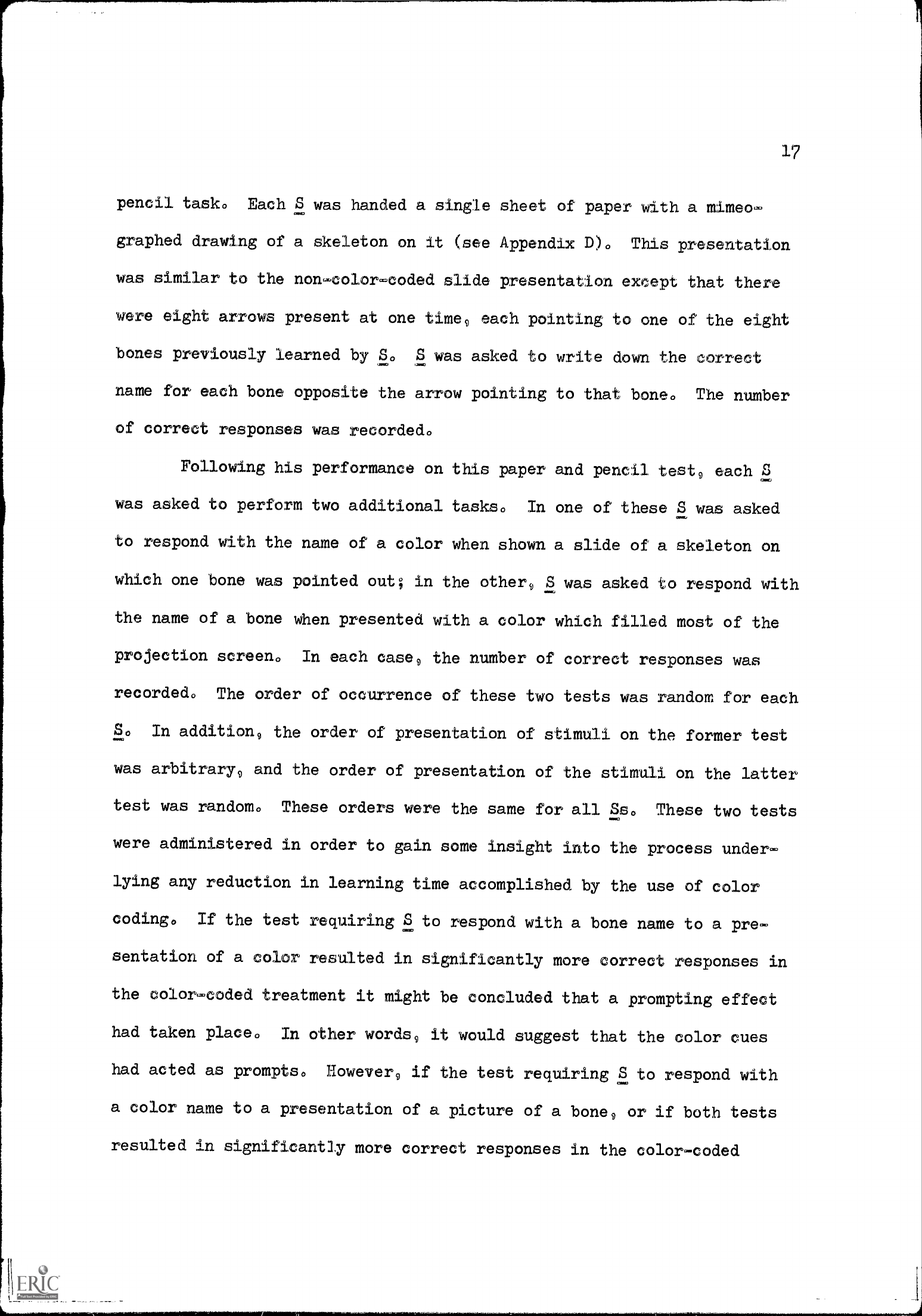
1
7
pencil task.
Each S was handed a single sheet of
paper with a mimeo-
graphed drawing of a skeleton
on it (see Appendix D).
This presentation
was similar to the non-color-coded slide presentation
except that there
were eight arrows present at one times each pointing to
one of the eight
bones previously learned by S.
S was asked to write down the correct
name for each bone opposite the arrow pointing to that bone.
The number
of correct responses
was recorded.
Following his performance on this
paper and pencil tests each S
was asked to perform two additional tasks.
In one of these S was asked
to respond with the name of
a color when shown a slide of a skeleton on
which one bone was pointed out; in the other9 S
was asked to respond with
the name of a bone when presented with
a color which filled most of the
projection screen.
In each cases the number of correct
responses was
recorded.
The order of occurrence of these two tests
was random for each
S.
In additions the order of presentation
of stimuli on the former test
was arbitrary9 and the order of presentation of the stimuli
on the latter
test was random.
These orders were the same for all Ss.
These two tests
were administered in order to gain some insight into the
process under-
lying any reduction in learning time accomplished
by the use of color
coding.
If the test requiring S to respond with
a bone name to a pre-
sentation of a color resulted in significantly
more correct responses in
the color-coded treatment it might be concluded
that a prompting effect
had taken place.
In other wordss it would suggest that the
color cues
had acted as prompts.
However's if the test requiring S to respond with
a color name to a presentation of a picture of
a bones or if both tests
resulted in significantly
more correct responses in the color-coded
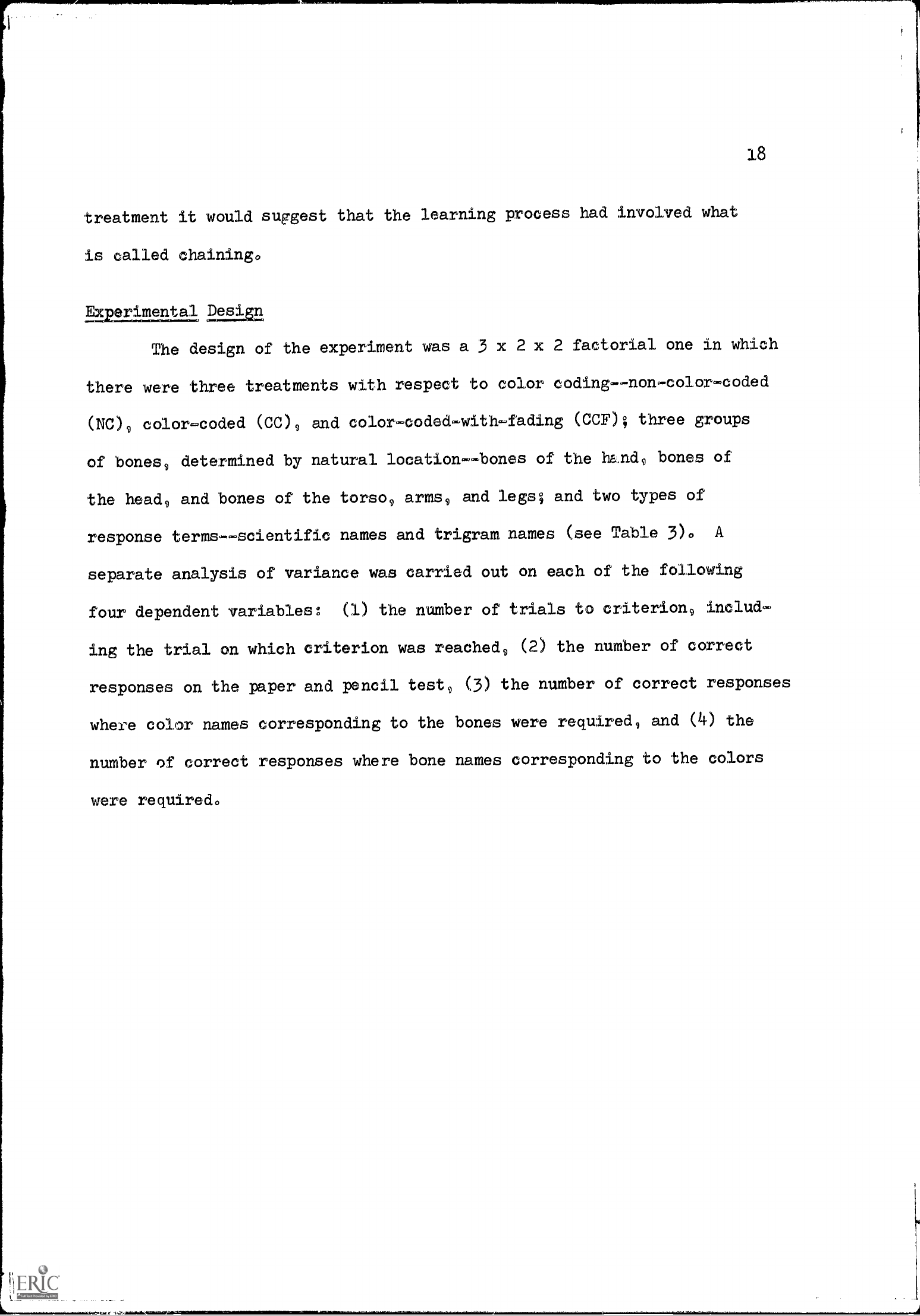
treatment it would suggest that the learning process
had involved what
is called chaining.
Experimental Deign
The design of the experiment was a
3 x 2 x 2 factorial one in which
there were three treatments with respect to
color coding--non-color-coded
(NC)s color-coded (CC)9 and color-coded-with-fading
(CCF); three groups
of bones; determined by natural location--bones
of the hamds bones of
the heads and bones of the torsos armies and
legs; and two types of
response terms--scientific names
and trigram names (see Table 3).
A
separate analysis of variance was carried out on each
of the following
four dependent variables:
(1) the number of trials to criterions includ-
ing the trial on which criterion was reached;
(2) the number of correct
responses on the paper and
pencil tests (3) the number of correct responses
where color names corresponding to the bones were
required, and (4) the
number of correct responses where bone names
corresponding to the colors
were required°
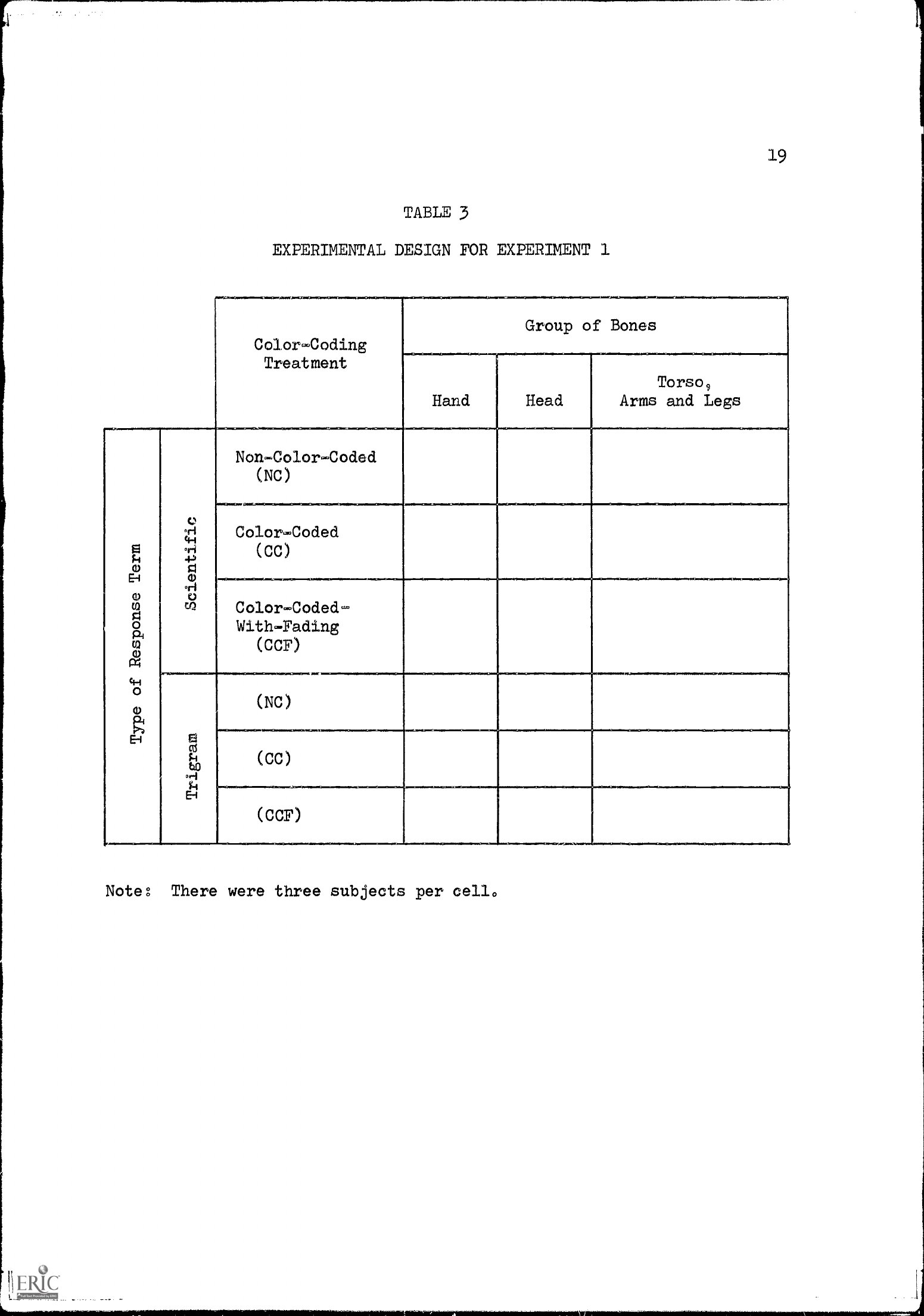
19
TABLE 3
EXPERIMENTAL DESIGN FOR EXPERIMENT 1
Color-Coding
Treatment
Group of Bones
Hand Head
..
Torso9
Arms and Legs
0
k
a)
EI
M
m
g
o
P4
M
m
Pg
CH
a)
EI
e
v..'
CH
ori
+5
g
a)
ori
r13
Non-Color-Coded
(NC)
. .
. .
Color-Coded
(CC)
Color -Coded -
With-Fading
(CCF)
. .
5
cd
FA
tal)
oH
El
(NC)
(CC)
(CCF)
... .. ..
Notes There were three subjects per cell,

20
CHAPTER III
RESULTSEXPERIMENT 1
It will be recalled that the independent variables in this experi-
ment consisted of (1) which group of bones9 names were learned (3 levels)9
(2) kind of color coding (3 levels)9 and (3) type of names learned (2
levels).
There were four dependent variables9 as described at the con-
clusion of Chapter II.
The dependent variable values for each S are
presented in Appendix E.
Table 4 shows the mean number of trials required to reach criterion
by Ss in each of the eighteen experimental conditions.
The statistical
significance of the experimental effects was determined via a three-way
analysis of variance.
The results of this analysis appear in Appendix F.
The critical region adopted for statistical significance corresponded to
5% level.
The mean numbers of trials to criterion for the color-coding con-
ditions were 10.279 10.449 and 10.00 for the non-color-coded, color-
coded9 and color-coded-with-fading conditions9 respectively.
The
analysis of variance showed that the differences between these means
were not significant. Thus9 there was no evidence that the manner of
color coding affected learning. The mean numbera of trials required by
Ss to learn the names of the bones of the hand9 head9 and torso9 arms9
and I. zs were 15.949 8.389 and 6.38 trials9 respectively.
The differences
between these means was significant9 F (29 36) = 58.69.
The mean numbers
of trials required by Ss who learned nonsense syllable names and those
who learned scientific names were 11.70 and 8.779 respectively.
The
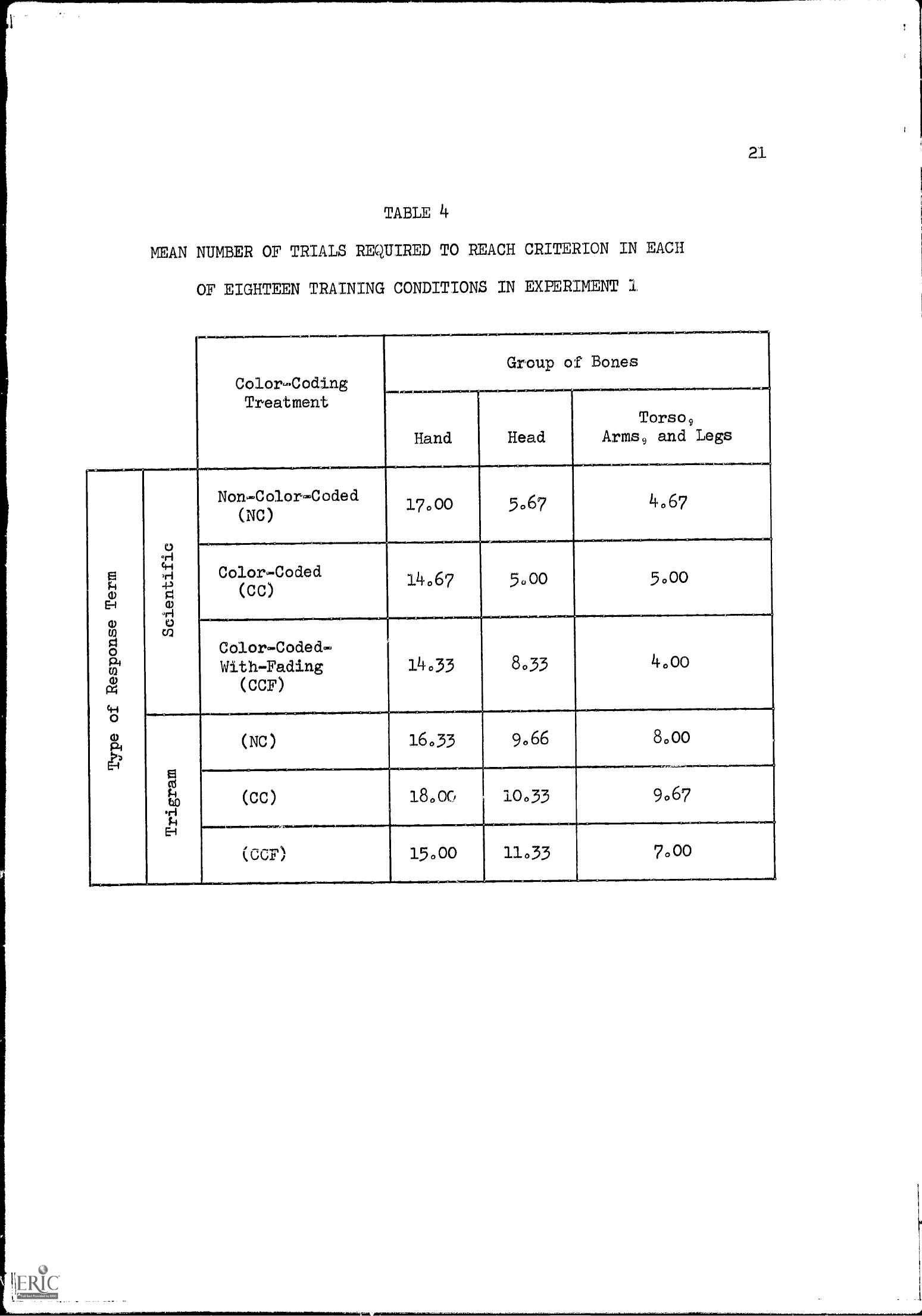
21
TABLE 4
MEAN NUMBER OF TRIALS REQUIRED TO REACH
CRITERION IN EACH
OF EIGHTEEN TRAINING CONDITIONS IN
EXPERIMENT 1
Color-Coding
Treatment
Group of Bones
0111NONTIARM
.
Hand
Head
Torso9
Arms9 and Legs
e
w
E-I
W
(fl
rl
o
P4
m
w
a
(4-4
0
0
pi
0
4-1
(4-4
1-I
o
w
0
u)
Non-Color-Coded
(NC)
17.00
5.67
4.67
Color-Coded
(CC)
14067
5000
5.00
Color-Coded-
With-Fading
(ccF)
---
14.33
8.33
4000
cd
P
to
.ri
P
E-1
(NC)
16033
9.66
8.00
(cc)
18000
10033
9 67
(CCF)
15.00
1133
7.00
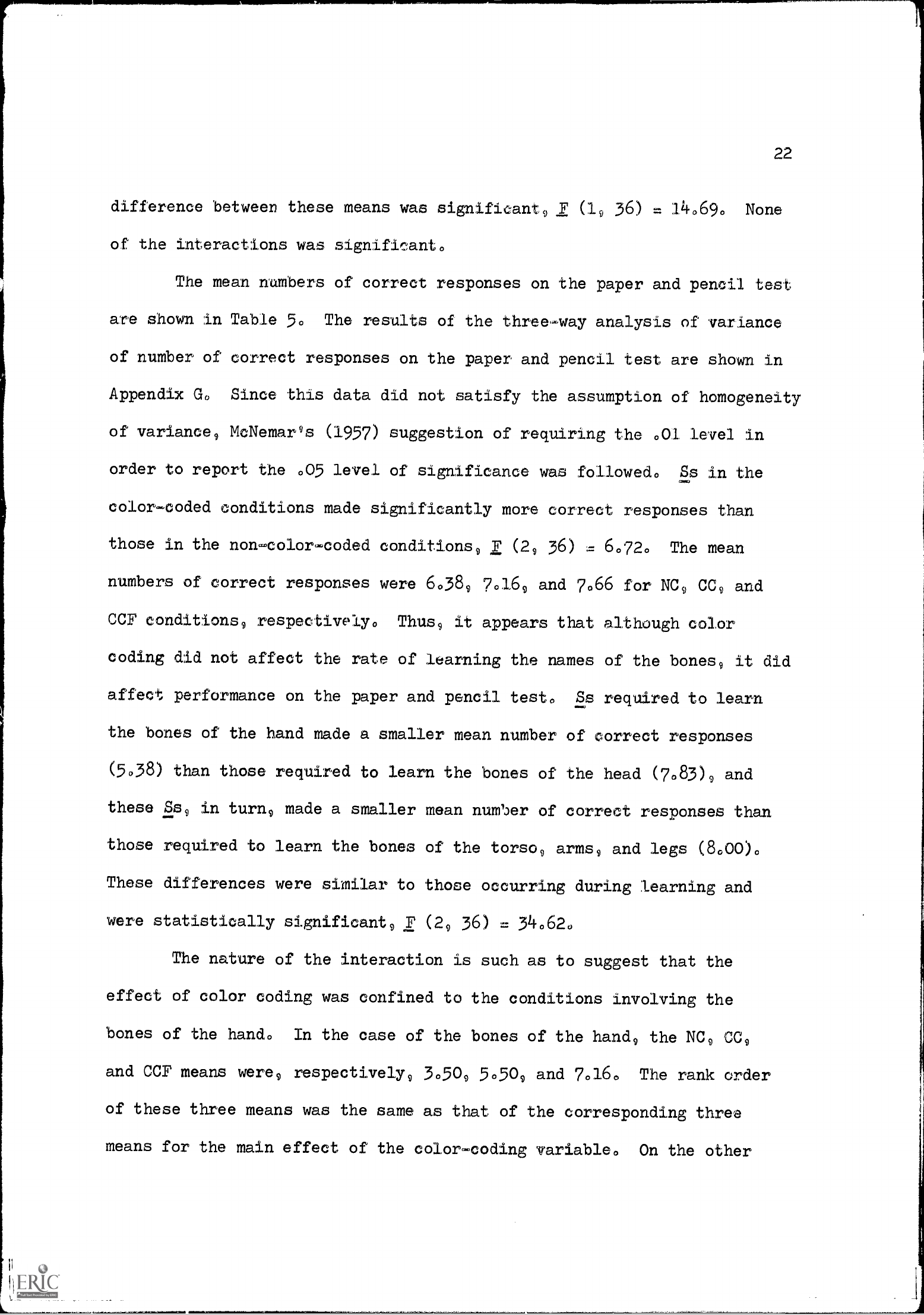
22
difference 'between these means was significant9 F (19 36)
=
14069.
None
of the interactions was significant.
The mean numbers of correct responses
on the paper and pencil test
are shown in Table 5.
The results of the three-way analysis of variance
of number of correct responses on the paper and pencil test
are shown in
Appendix G.
Since this data did not satisfy the assumption of homogeneity
of variances McNemar's (1957) suggestion of requiring the .01 level in
order to report the 005 level of significance
was followed.
Ss in the
color-coded conditions made significantly
more correct responses than
those in the non-color-coded conditions
,E (29 36) = 6.72.
The mean
numbers of correct responses were 6.389 70169 and 7.66
for NC9 CC9 and
CCF conditions9 respectively.
Thus9 it appears that although color
coding did not affect the rate of learning the
names of the bones9 it did
affect performance on the paper and pencil test.
Ss required to learn
the bones of the hand made a smaller mean number of
correct responses
(5.38) than those required to learn
the bones of the head (7.83)9 and
these Ss9 in turn9 made a smaller
mean number of correct responses than
those required to learn the bones of the torsos
arms9 and legs (8000).
These differences were similar to those occurring
during learning and
were statistically significant9 F (29 36)
= 34.620
The nature of the interaction is such
as to suggest that the
effect of color coding was confined to the conditions
involving the
bones of the hand.
In the case of the bones of the hand9 the NC9 CCs
and CCF means were9 respectively9 3.509 5.509 and 7.16.
The rank order
of these three means was the same
as that of the corresponding three
means for the main effect of the color-coding variable.
On the other
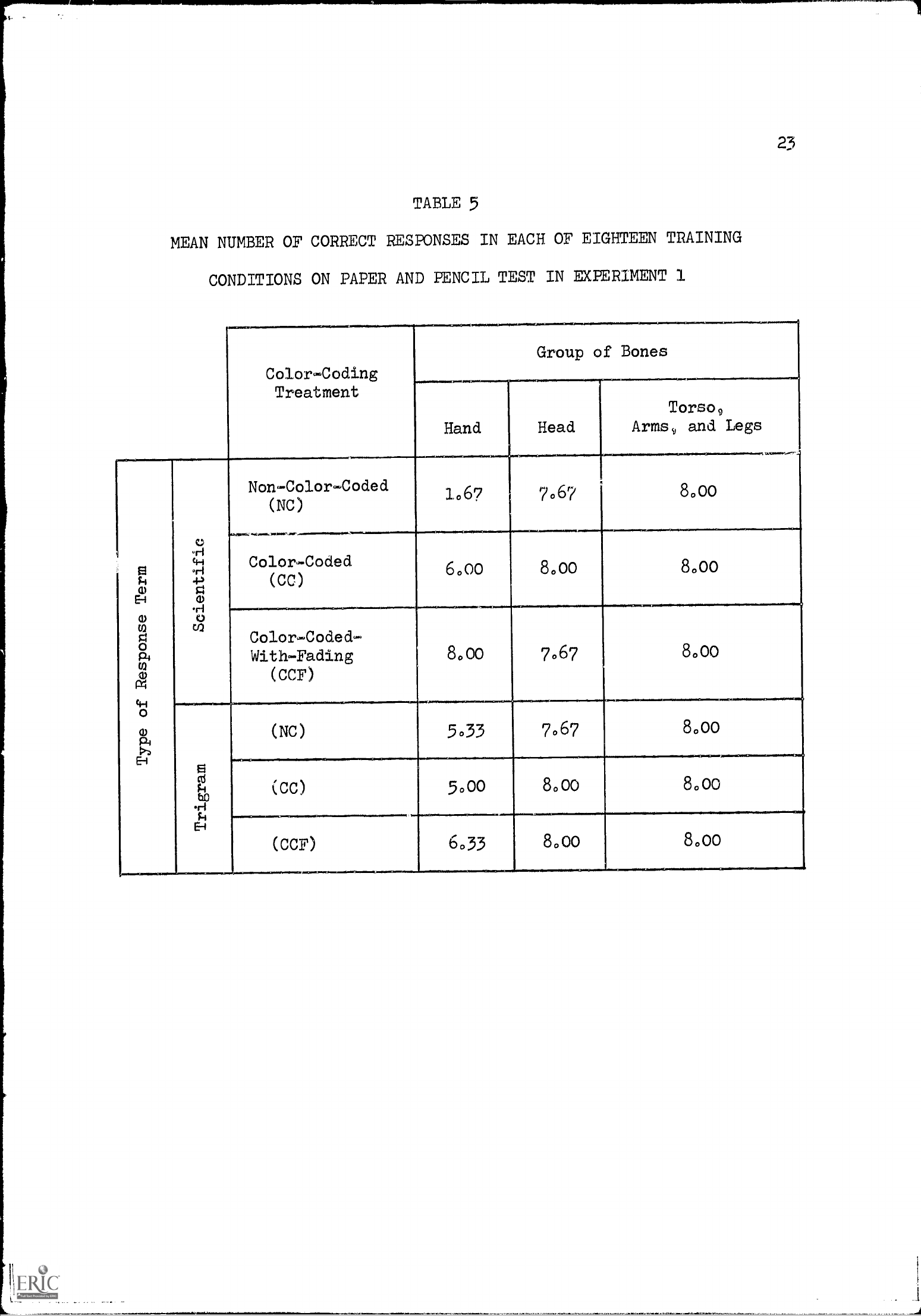
TABLE 5
MEAN NUMBER OF CORRECT RESPONSES IN EACH
OF EIGHTEEN TRAINING
CONDITIONS ON PAPER AND PENCIL TEST IN
EXPERIMENT I
Color-Coding
Treatment
Group of Bones
Hand
Head
Torso9
Arms, and Legs
e
$4
E-1
0
W
o
0
rz4
ce-i
0
0
al
.ri
ci-1
ql
g
.0
0
0
Non- Color -Coded
(NC)
1067
7067
.......
80oo
Color-Coded
(cc)
60oo
80oo
80oo
Color- Coded-
With- Fading
(ccF)
80oo
7067
.
800o
E
k
bo
cd
$4
E-1
(NC)
5033
7067
80oo
(CC)
5000
80oo
80oo
(ccF)
6033
80oo
80oo
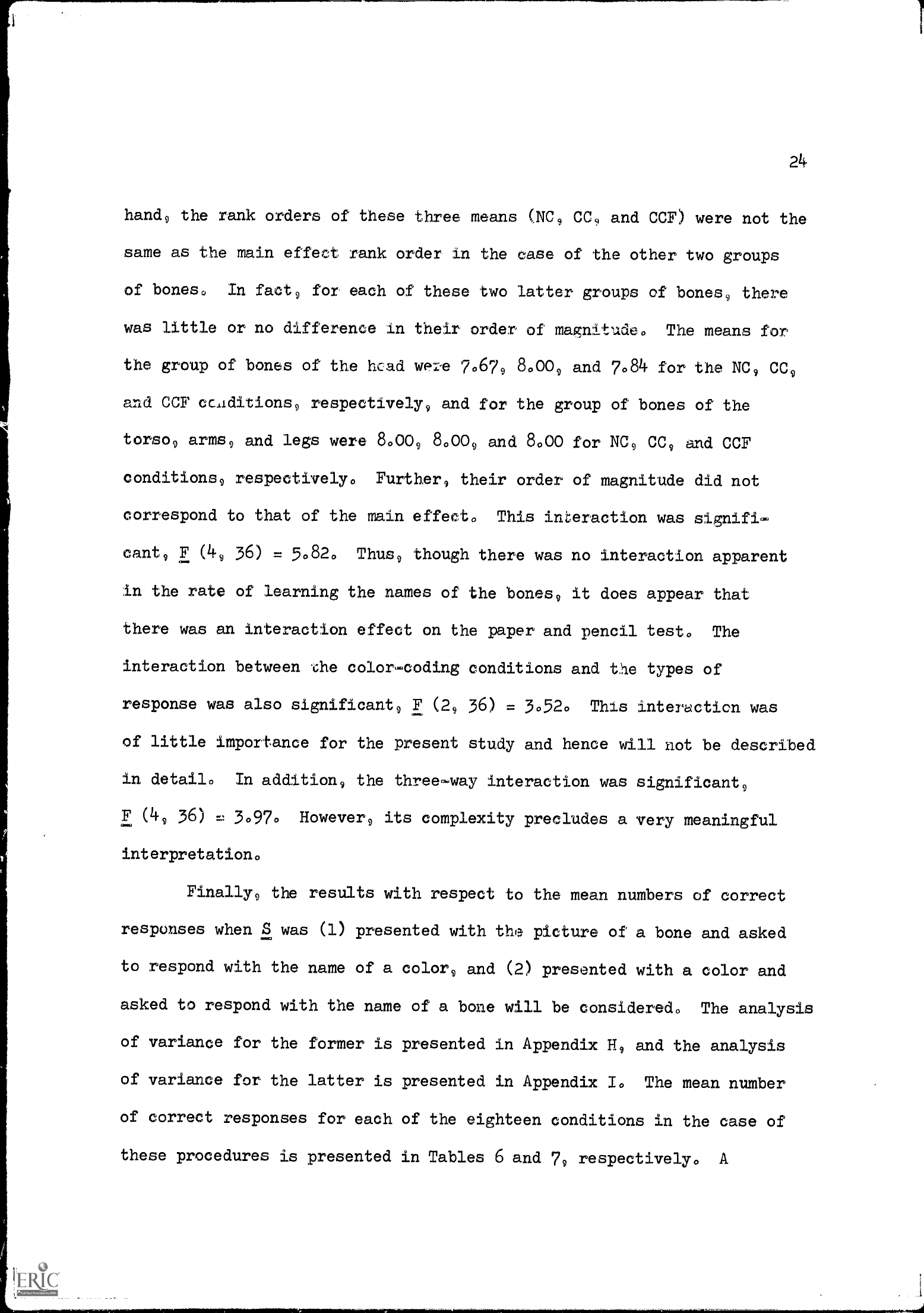
hand9 the rank orders of these three means (NC9 CC9 and CCF)
were not the
same as the main effect rank order in the case of the other two
groups
of bones°
In facto for each of these two latter groups of bones9 there
was little or no difference in their order of magnitude°
The means for
the group of bones of the had were 70679 80009 and 7.84 for the
NC9 CC9
and CCF cc_aditions9 respectively9 and for the group of bones of the
torso9 arms9 and legs were 80009 8.009 and 8000 for NC9 CC9 and CCF
conditions9 respectively.
Further, their order of magnitude did not
correspond to that of the main effect0
This interaction was signifi-
canto F (49 36) = 50820
Thus9 though there was no interaction apparent
in the rate of learning the names of the bones9 it does
appear that
there was an interaction effect on the paper and pencil test°
The
interaction between .che color-coding conditions and the types of
response was also significant9 F (29 36) = 30520
This interaction was
of little importance for the present study and hence will not be
described
in detail°
In addition, the three-way interaction
was significant9
F (49 36) = 30970
However9 its complexity precludes
a very meaningful
interpretation.
Finally9 the results with respect to the
mean numbers of correct
responses when S was (1) presented with the picture of
a bone and asked
to respond with the name of a color9 and (2) presented
with a color and
asked to respond with the name of
a bone will be considered.
The analysis
of variance for the former is presented in Appendix
H9 and the analysis
of variance for the latter is presented in Appendix I0
The mean number
of correct responses for each of the eighteen conditions
in the case of
these procedures is presented in Tables 6 and 79
respectively.
A
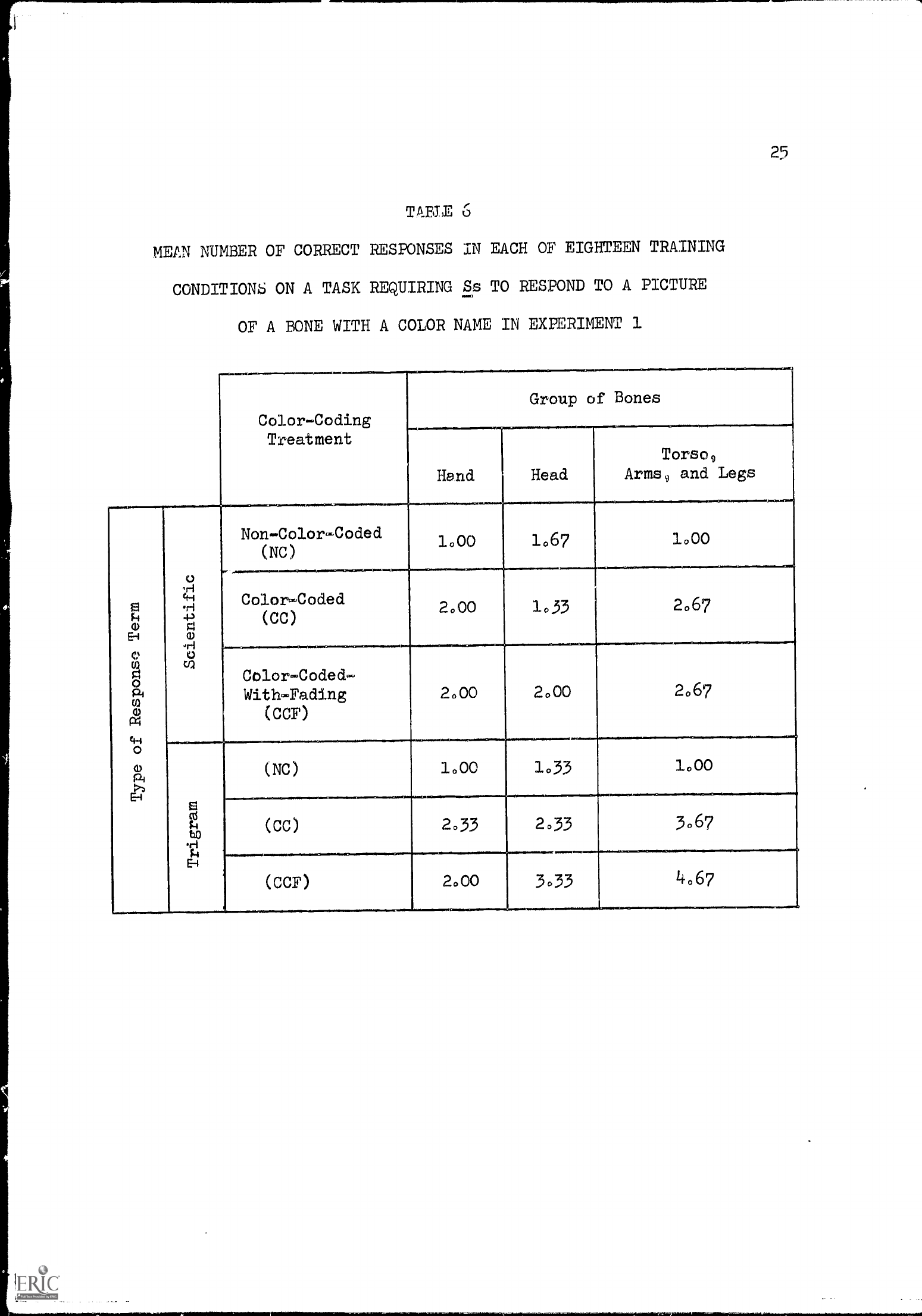
25
TABLE 6
MEAN NUMBER OF CORRECT RESPONSES IN
EACH OF EIGHTEEN TRAINING
CONDITIONS ON A TASK REQUIRING Ss TO RESPOND
TO A PICTURE
OF A BONE WITH A COLOR NAME IN EXPERIMENT
1
.
Jwavage../s.wwxyaf
Color-Coding
Treatment
.
.
...
Group of Bones
Hand
Head
Torso9
Arms, and Legs
0
k
0
El
C.
W
g
o
A
co
o
P1
C4.1
0
o
Pi
H
0
4.1
1-1
+)
g
0
0
W
Non-Co1or-Coded
(NC)
1000
1.67
1.00
Color-Coded
(CC)
2000
1,33
2067
Color-Coded -
With-Fading
(CCF)
2000
2000
2067
ai
F4
b.ro
Pi
El
(NC)
1000
1033
1000
(CC)
2033
2033
3067
(CCF)
2000
3033
4.67
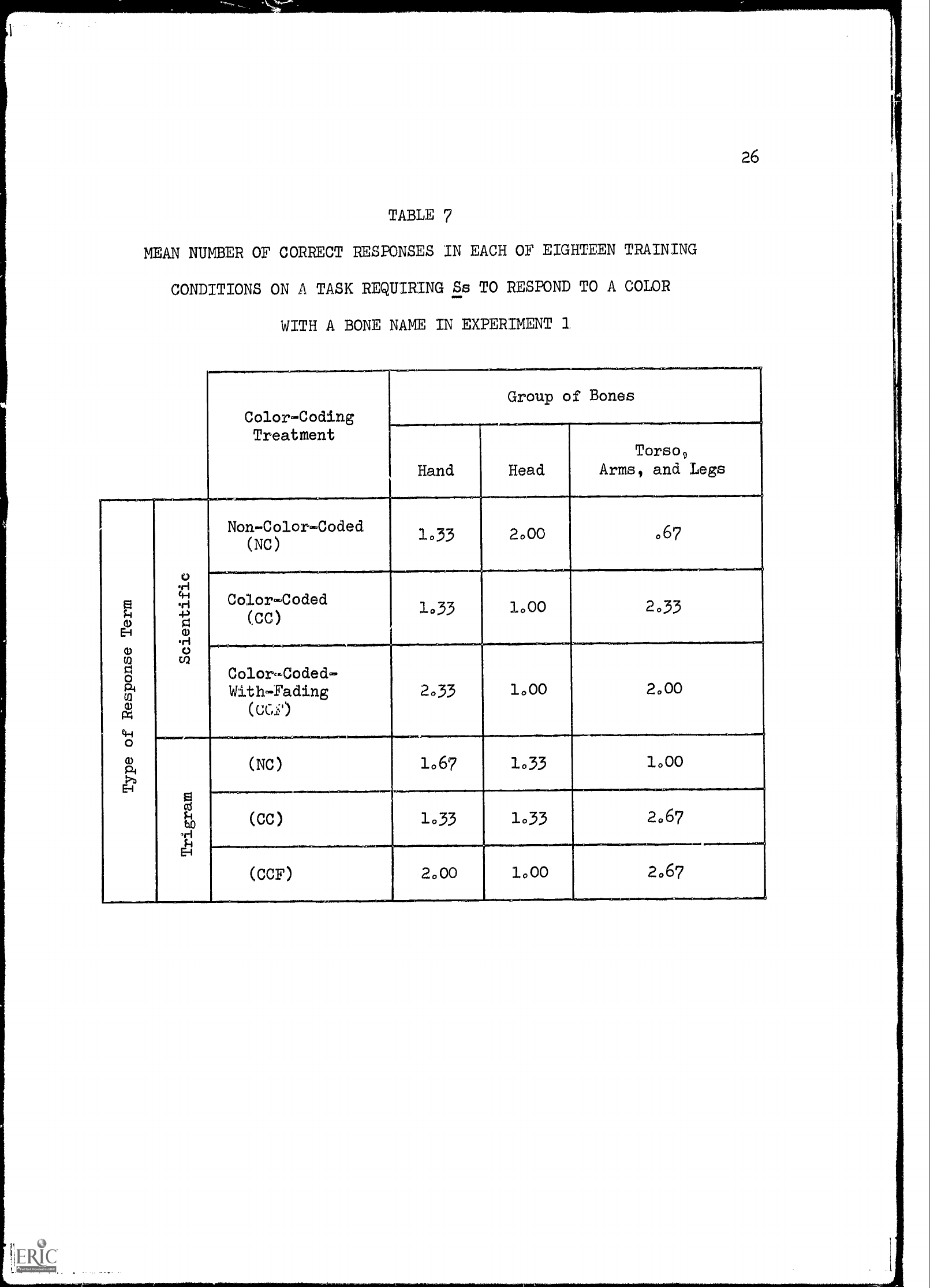
TABLE 7
MEAN NUMBER OF CORRECT RESPONSES IN EACH OF
EIGHTEEN TRAINING
CONDITIONS ON A TASK REQUIRING Ss TO RESPOND TO A
COLOR
WITH A BONE NAME IN EXPERIMENT 2
Color "-Coding
Treatment
Group of Bones
Hand
Head
Torso,
Arms, and Legs
E
P
H
0
M
0
o
al
o
rzg
el-1
o
4P
E-I
o
ff,11
+5
0
Cil
Non-Color-Coded
(NC)
1033 2000
067
Color-Coded
(CC)
1033 1000
2033
Color-Coded-
Wit -ading
(GU)
2033
1000
2.00
b0
E-I
(NC)
1067
1033
1.00
(CC)
1033 1033
2067
(CCF)
2000
1000
2067
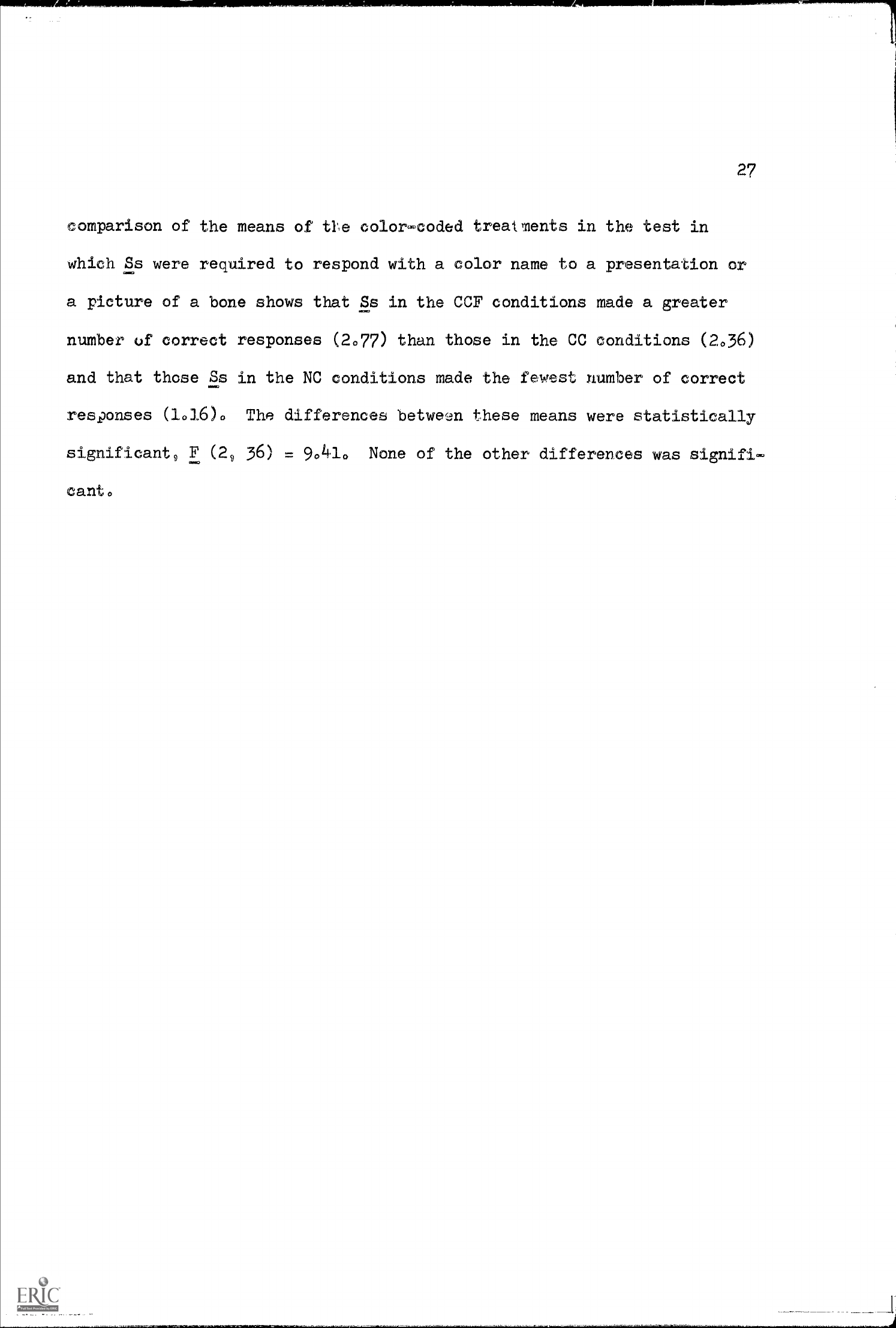
27
comparison of the means of tie color-coded treatments in the test in
which Ss were required to respond with a color name to a presentation or
a picture of a bone shows that Ss in the CCF conditions made a greater
number of correct responses (2077) than those in the CC conditions (2036)
and that those Ss in the NC conditions made the fewest number of correct
responses (1016)0
The differences betwevm these means were statistically
significant, F (29 36)
= 90410
None of the other differences was signifi-
cant.
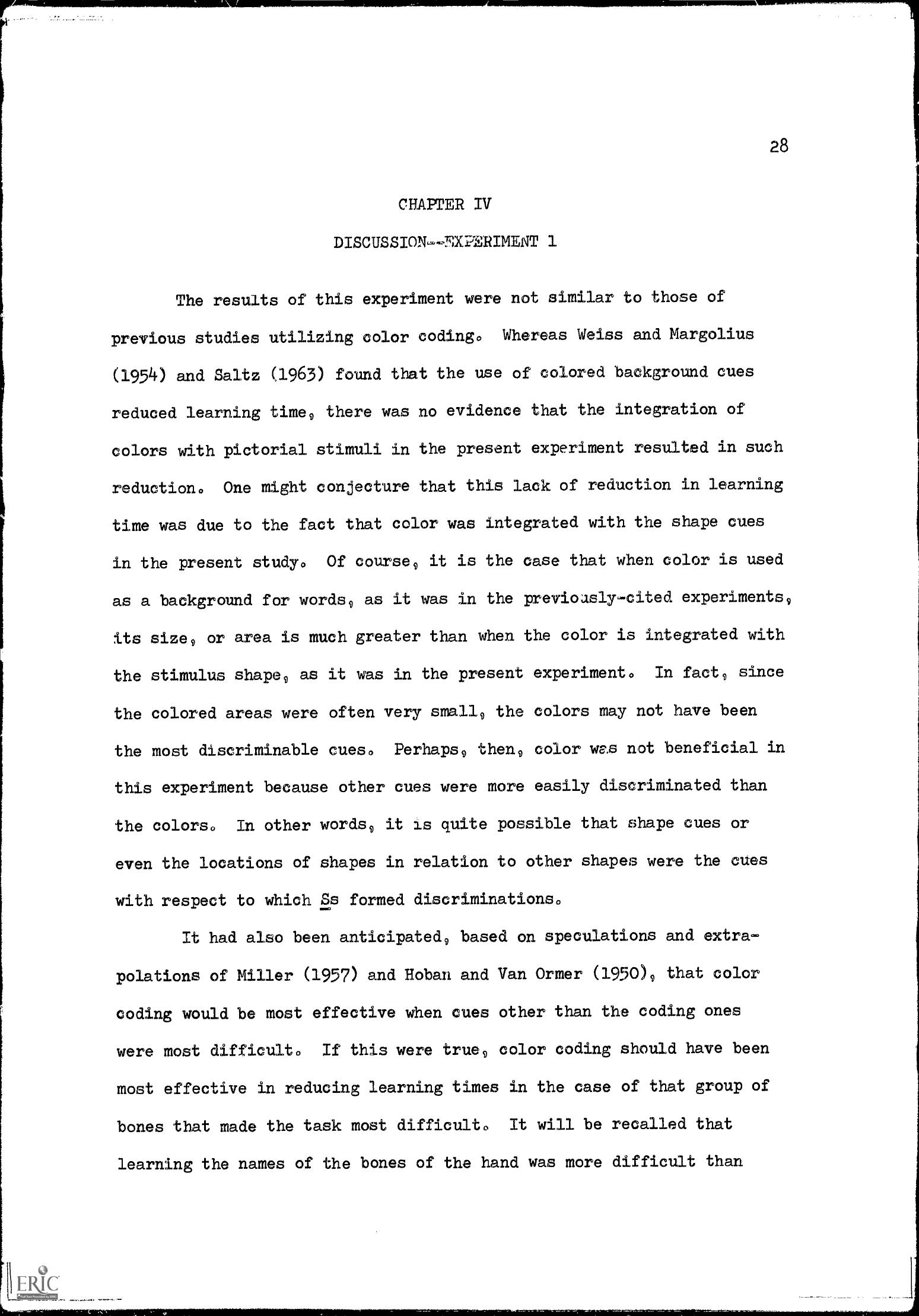
28
CHAPTER IV
DISCUSSIONNXPERIMENT 1
The results of this experiment were not similar to
those of
previous studies utilizing color coding°
Whereas Weiss and Margolius
(1954) and Saitz (1963) found that the use of colored background cues
reduced learning time9 there was no evidence that the
integration of
colors with pictorial stimuli in the present experiment
resulted in such
reduction°
One might conjecture that this lack of reduction in
learning
time was due to the fact that color was integrated with
the shape cues
in the present study°
Of course9 it is the case that when color is used
as a background for words9 as it was
in the previously '-cited experiments9
its size9 or area is much greater than when the color is integrated
with
the stimulus shape9 as it was in the present experiment°
In fact9 since
the colored areas were often very small9 the colors may not have
been
the most discriminable cueso
Perhaps9 then9 color was not beneficial in
this experiment because other cues were more easily discriminated than
the colors°
In other words9 it is quite possible that shape cues or
even the locations of shapes in relation to
other shapes were the cues
with respect to which Ss formed discriminations°
It had also been anticipated9 based on speculations and extra-
polations of Miller (1957) and Hoban and Van Ormer
(1950)9 that color
coding would be most effective when cues other than the coding ones
were most difficult°
If this were true9 color coding should have been
most effective in reducing learning times in the case of that group of
bones that made the task most difficulto
It will be recalled that
learning the names of the bones of the hand was more difficult than
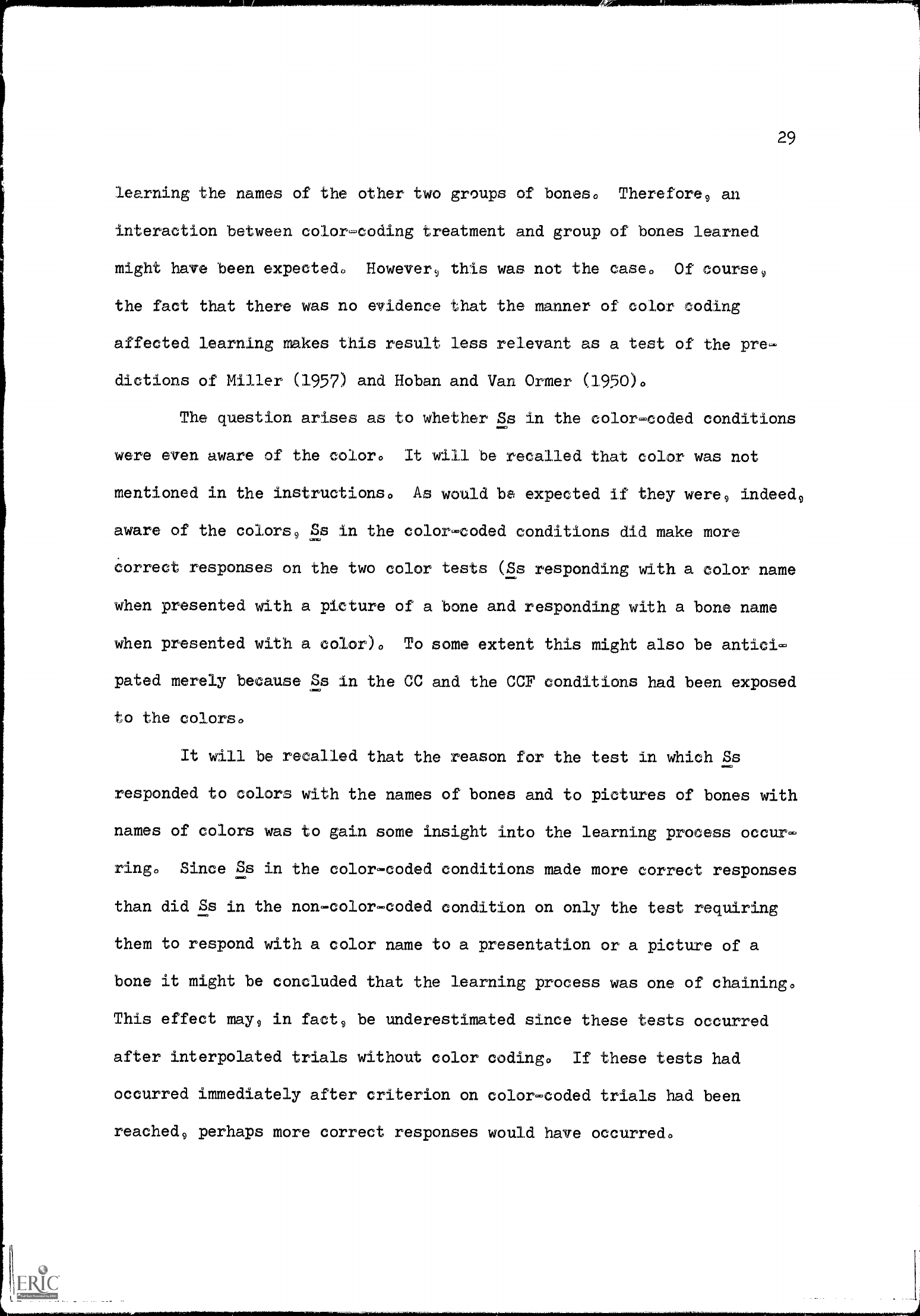
29
learning the names of the other two groups of bones.
Therefore° an
interaction between color-coding treatment and group of bones learned
might have been expected.
However, this was not the case.
Of course9
the fact that there was no evidence that the manner of color coding
affected learning makes this result less relevant as a test of the pre-
dictions of Miller (1957) and Hoban and Van Ormer (1950).
The question arises as to whether Ss in the color-coded conditions
were even aware of the color.
It will be recalled that color was not
mentioned in the instructions.
As would be expected if they were9 indeed9
aware of the colors9 Ss in the color-coded conditions did make more
Correct responses
on the two color tests (Ss responding with a color name
when presented with a picture of a bone and responding with a bone
name
when presented with a color).
To some extent this might also be antici-
pated merely because Ss in the CC and the CCF conditions had been exposed
to the colors.
It will be recalled that the reason for the test in which Ss
responded to colors with the names of bones and to pictures of bones with
names of colors was to gain some insight into the learning process occur-
ring.
Since Ss in the color-coded conditions made more correct responses
than did Ss in the non-color-coded condition on only the test requiring
them to respond with a color name to a presentation or a picture of a
bone it might be concluded that the learning process was one of chaining.
This effect may9 in fact9 be underestimated since these tests occurred
after interpolated trials without color coding.
If these tests had
occurred immediately after criterion on color-coded trials had been
reached9 perhaps more correct responses would have occurred.
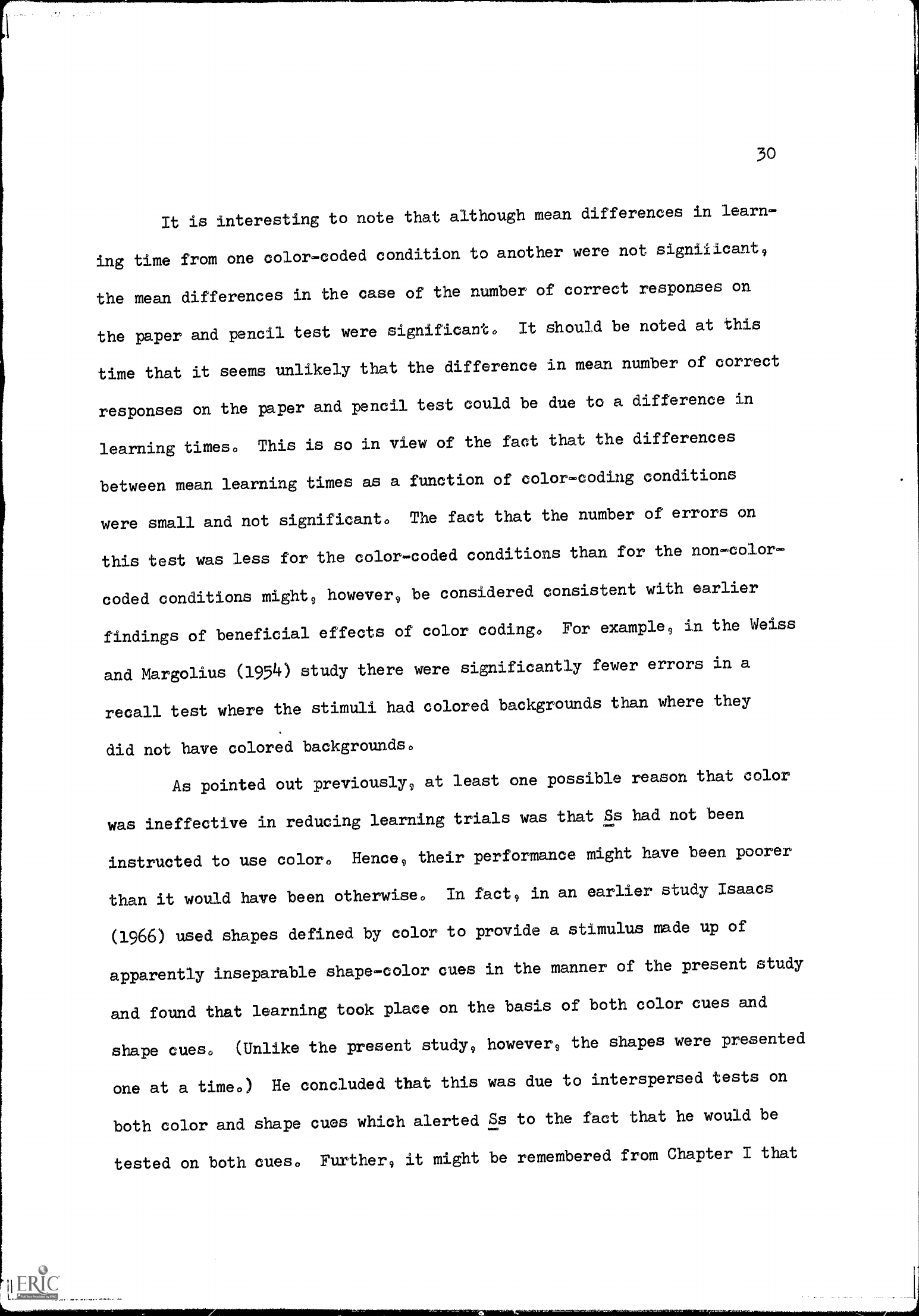
30
It is interesting
to note that although mean
differences in learn-
ing time from one
color-coded condition to
another were not signiiicant9
the mean differences
in the case of the number
of correct responses on
the paper and
pencil test were
significant.
It should be noted at
this
time that it seems
unlikely that the
difference in mean number
of correct
responses on
the paper and pencil
test could be due to a
difference in
learning times.
This is so in view of
the fact that the
differences
between mean learning
times as a function of
color-coding conditions
were small and
not significant.
The fact that the number
of errors on
this test was less for
the color-coded
conditions than for the
non-color-
coded conditions mighty,
however9 be considered
consistent with earlier
findings of beneficial effects
of color coding.
For example9 in the
Weiss
and Margolius
(1954) study there were
significantly fewer errors
in a
recall test where the
stimuli had colored
backgrounds than where
they
did not have colored
backgrounds.
As pointed out previously9
at least one possible reason
that color
was ineffective
in reducing learning
trials was that Ss had not
been
instructed to use color.
Hence9 their performance
might have been poorer
than it would have
been otherwise.
In fact9 in an earlier
study Isaacs
(1966) used shapes defined by color
to provide a stimulus
made up of
apparently inseparable
shape-color cues in the manner
of the present study
and found that learning
took place on the basis
of both color cues and
shape cues.
(Unlike the present study9
however9 the shapes were
presented
one at a
time.)
He concluded that this was
due to interspersed tests on
both color and shape cues
which alerted Ss to the
fact that he would be
tested on both cues.
Further9 it might be
remembered from Chapter I
that
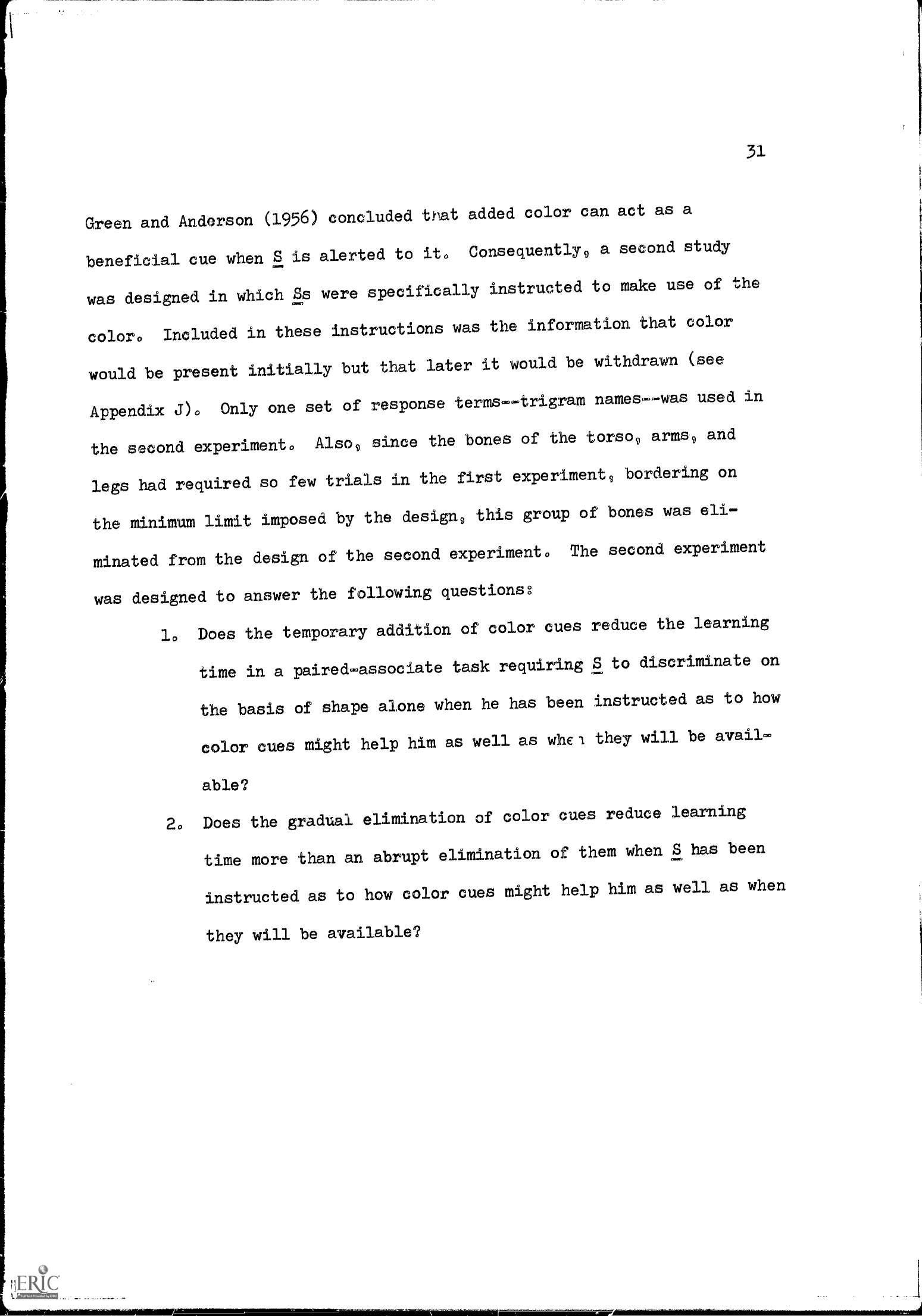
31
Green and Anderson
(1956) concluded tat
added color can act as a
beneficial cue when
S is alerted to
it.
Consequently9 a second
study
was designed
in which Ss were
specifically instructed
to make use of
the
color.
Included in these
instructions was the
information that color
would be present
initially but that
later it would be
withdrawn (see
Appendix J)0
Only one set
of response
terms--trigram names--was
used in
the second
experiment.
Also9 since the bones
of the torso9 arms9
and
legs had required so
few trials in the
first experiment9
bordering on
the minimum
limit imposed by the
design9 this group
of bones was eli-
minated from the
design of the second
experiment.
The second experiment
was designed
to answer the
following questions8
1.
Does the temporary
addition of color cues
reduce the learning
time in a paired-associate
task requiring S to
discriminate on
the basis of shape
alone when he has
been instructed as
to how
color cues might help
him as well as whcl
they will be avail-
able?
2.
Does the gradual
elimination of color cues
reduce learning
time more than an
abrupt elimination of
them when S has
been
instructed as to how
color cues might help
him as well as when
they will be available?
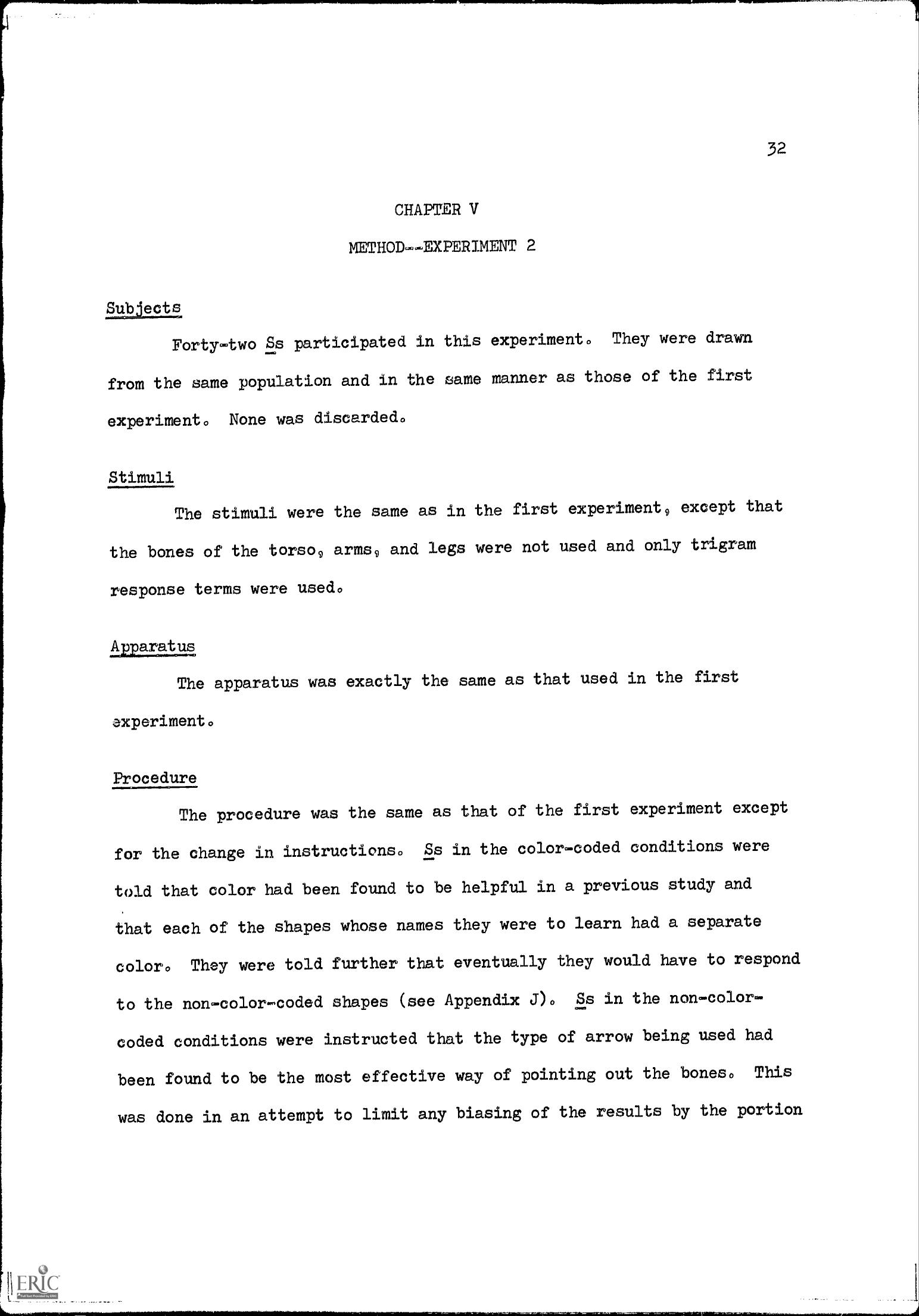
32
CHAPTER V
METHOD
EXPERIMENT 2
Subjects
Forty-two Ss participated in
this experiment.
They were drawn
from the same population
and in the same manner as
those of the first
experiment.
None was discarded.
Stimuli
The stimuli were the same as in the
first experiment9 except that
the bones of the torso9 arms9
and legs were not used and
only trigram
response terms were
used.
Amaratus
The apparatus was exactly the same as
that used in the first
experiment.
Procedure
The procedure was the same as
that of the first experiment
except
for the change in instructions.
Ss in the color-coded conditions were
told that color had been found to
be helpful in a previous study and
that each of the shapes whose names
they were to learn had a separate
color.
They were told further that eventually
they would have to respond
to the non-color-coded shapes
(see Appendix J).
Ss in the non-color-
coded conditions were instructed
that the type of arrow being used
had
been found to be the most
effective way of pointing out the
bones.
This
was done in an
attempt to limit any biasing of the
results by the portion
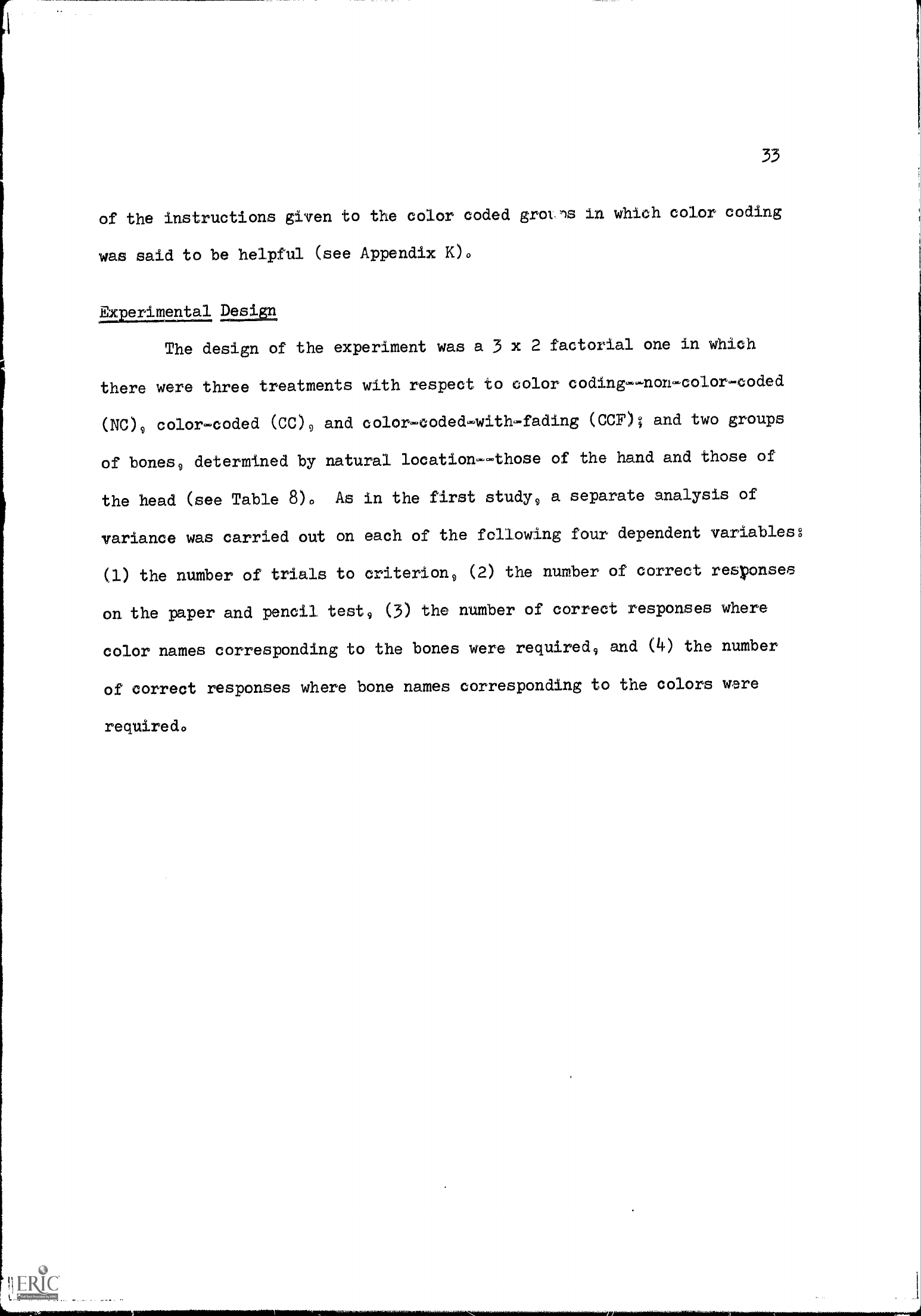
t
33
of the instructions given to the
color coded grotns in which color coding
was said to be
helpful (see Appendix K)0
gaalastal Design
The design of the experiment was a 3 x 2
factorial one in which
there were three treatments with respect
to color coding--non-color-coded
(NC)9 color-coded (CC)9 and color-coded-with-fading
(CCF); and two groups
of bones9 determined by natural location--those
of the hand and those of
the head (see Table 8).
As in the first study9 a separate analysis
of
variance was carried out on each of the
following four dependent variablesg
(1) the number of trials to criterion9
(2) the number of correct responses
on the paper and
pencil test9 (3) the number of correct responses
where
color names corresponding to the bones were
required9 and (4) the number
of correct responses where bone names
corresponding to the colors were
required.
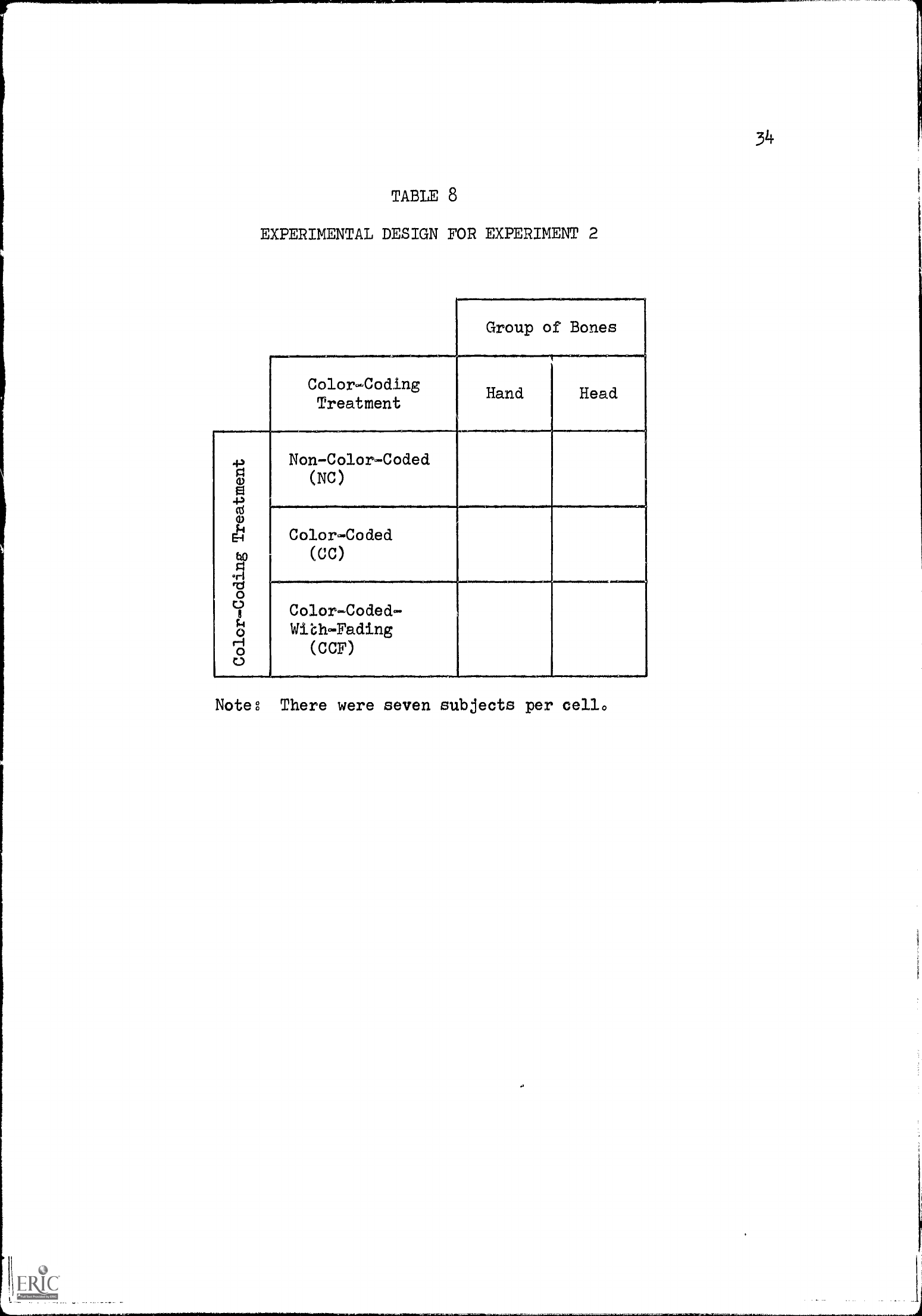
34
TABLE
8
EXPERIMENTAL DESIGN FOR EXPERIMENT 2
Group of Bones
Color-Coding
Treatment
Non-Color-Coded
(NC)
Color-Coded
(CC)
Color-Coded-
Wibh-Fading
(CCF)
Hand
Head
Notes
There were seven subjects per cello
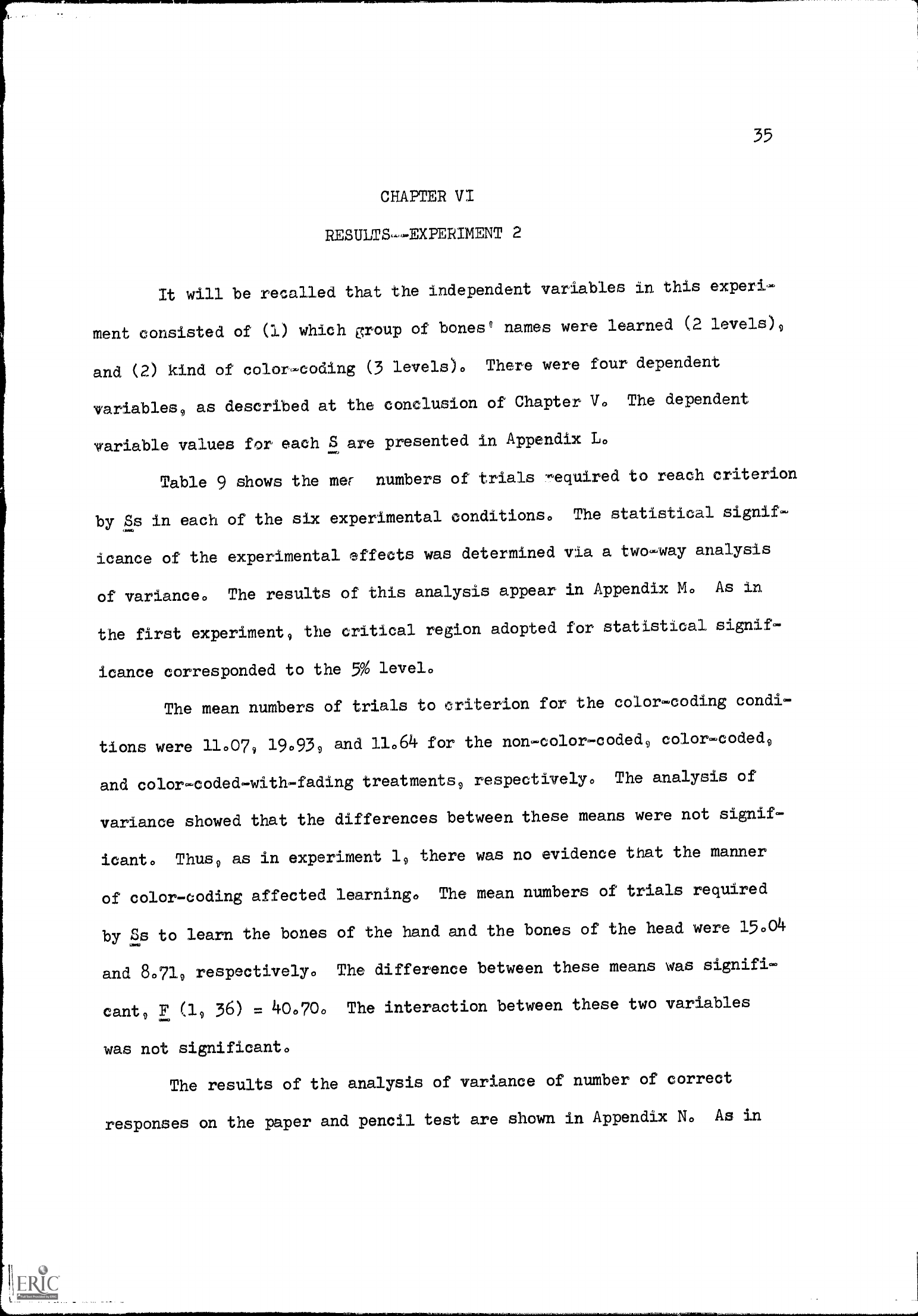
35
CHAPTER VI
RESULTSEXPERIMENT 2
It will be recalled that
the independent variables
in this experi-
ment consisted of (1) which group
of bones° names were
learned (2 levels)9
and (2) kind of color
coding (3 levels).
There were four dependent
variables, as described at the
conclusion of Chapter V.
The dependent
variable values for each S are
presented in Appendix L.
Table
9
shows the mer
numbers of trials 'equired
to reach criterion
by Ss in each of the six
experimental conditions.
The statistical signif-
icance of the experimental effects was
determined via a two-way
analysis
of variance.
The results of this analysis appear
in Appendix M.
As in
the first experiment, the
critical region adopted for
statistical signif-
icance corresponded to the
5% level.
The mean numbers of trials
to criterion for the
color-coding condi-
tions were 11.079 19.939 and
11.64 for the non-color-coded9
color-coded9
and color-coded-with-fading
treatments9 respectively.
The analysis of
variance showed that the
differences between these means were
not signif-
icant.
Thus9 as in experiment 19 there was no
evidence that the manner
of color-coding affected
learning.
The mean numbers of trials
required
by Ss to learn the bones of
the hand and the bones of the
head were 15.04
and 8.719 respectively.
The difference between these means was
signifi-
cant9 F (19 36) =
40.70.
The interaction between
these two variables
was not significant.
The results of the analysis
of variance of number of
correct
responses on the paper
and pencil test are shown in
Appendix N.
As in
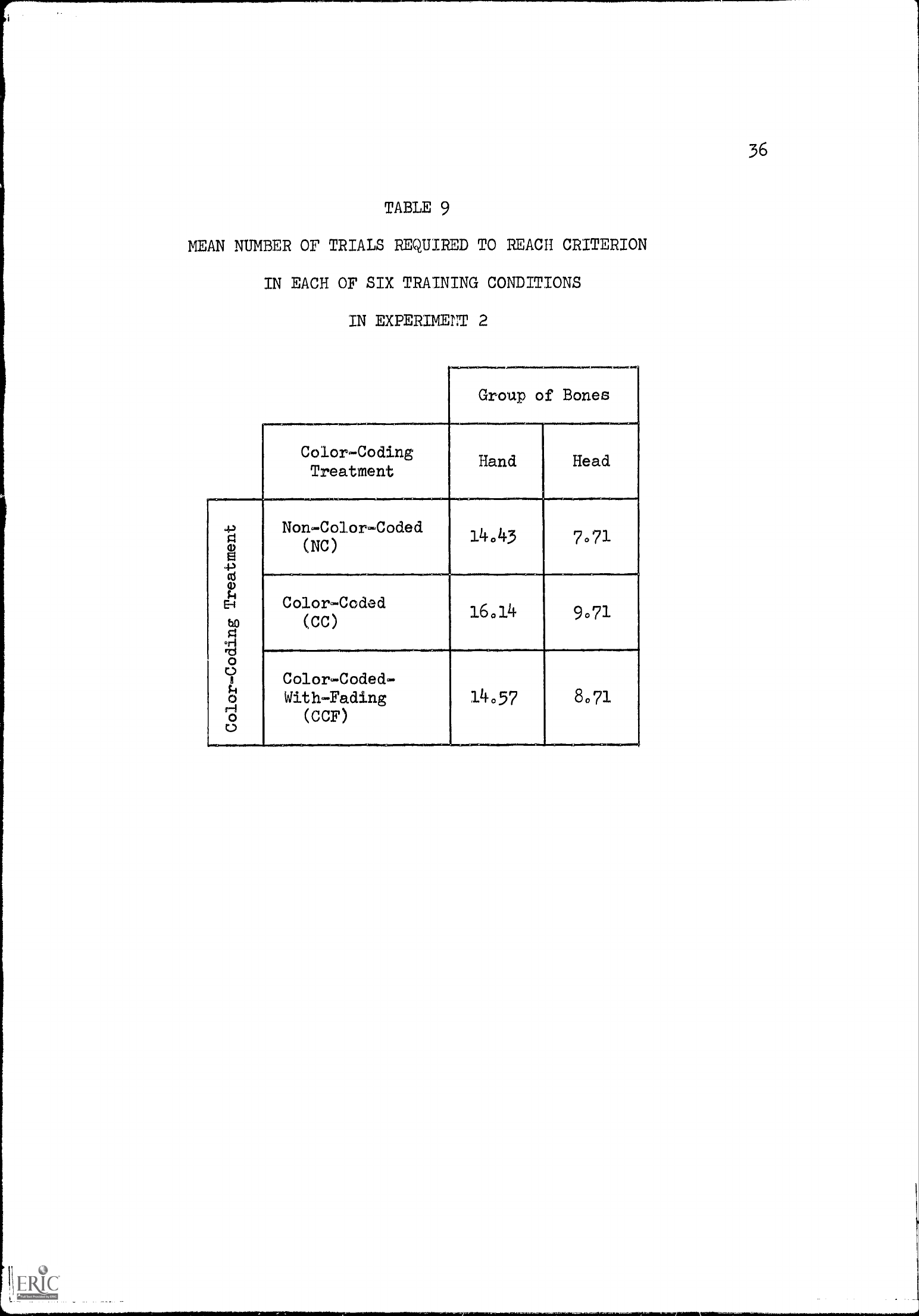
36
TABLE 9
MEAN NUMBER OF TRIALS REQUIRED TO REACH CRITERION
IN EACH OF SIX TRAINING CONDITIONS
IN EXPERIMENT 2
11110.1.1111.11MPIONPNIIII
Color-Coding
Treatment
Group of Bones
Hand
Head
7.71
Non-Color-Coded
(NC)
Color-Coded
(CC)
14,43
16.14
9.71
Color-Coded-
With-Fading
(CCF)
14.57 8071
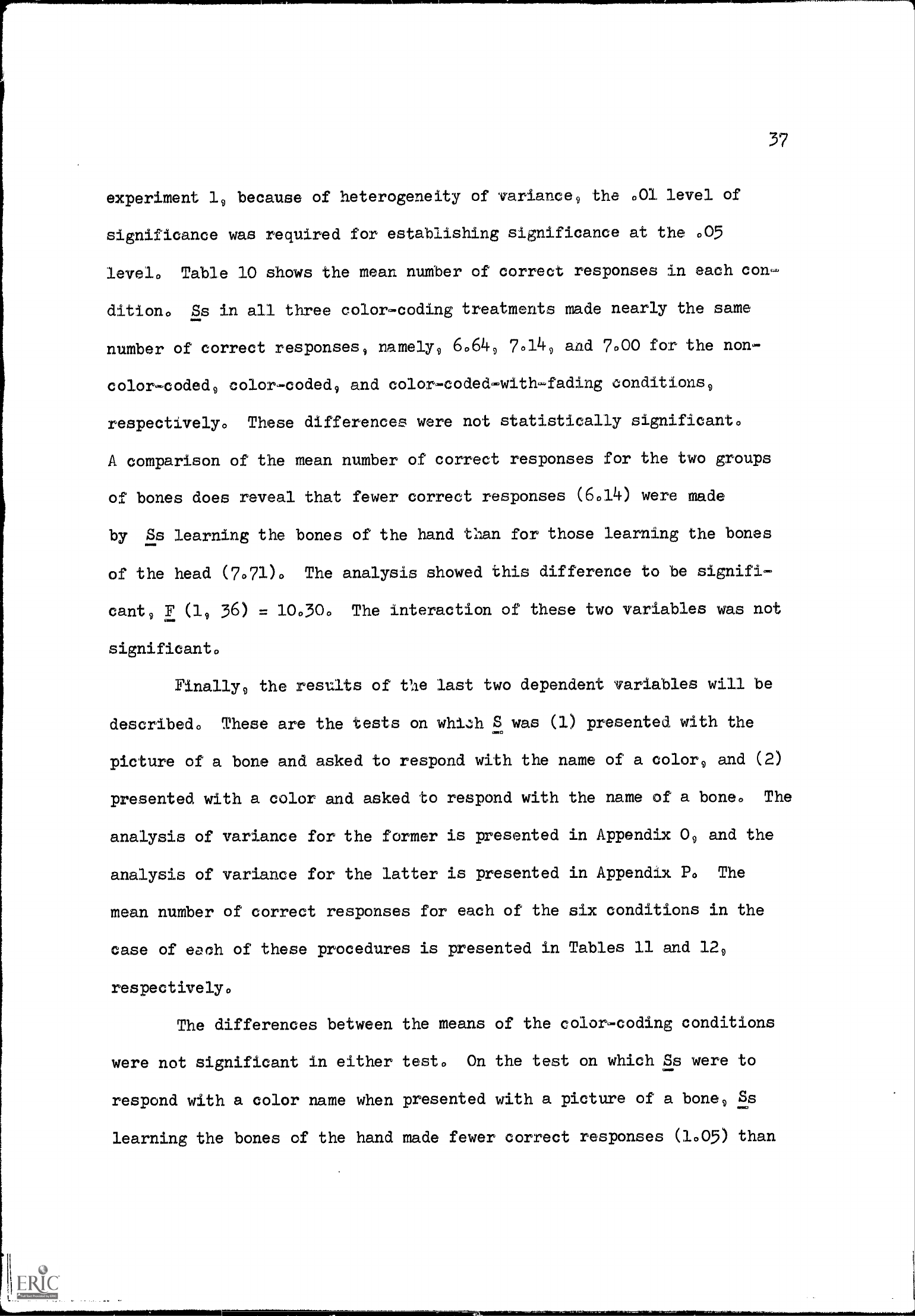
37
experiment 19 because of heterogeneity of variance, the .01 level of
significance was required for establishing significance at the .05
level.
Table 10 shows the mean number of correct responses in each con-
dition.
Ss in all three color-coding treatments made nearly the same
number of correct responses, namely9 60649
7.149 and 7000 for the non-
color-coded9 color-coded9 and color-coded-with-fading conditions9
respectively.
These differences were not statistically significant.
A comparison of the mean number of correct responses for the two groups
of bones does reveal that fewer correct responses
(6.14) were made
by
Ss learning the bones of the hand than for those learning the bones
of the head (7071).
The analysis showed this difference to be signifi-
cant9 F (19 36) = 10.30.
The interaction of these two variables was not
significant.
Finally9 the results of the last two dependent variables will be
described.
These are the tests on which S was (1) presented with the
picture of a bone and asked to respond with the name of a color9 and (2)
presented with a color and asked to respond with the name of a bone.
The
analysis of variance for the former is presented in Appendix 09 and the
analysis of variance for the latter is presented in Appendix P.
The
mean number of correct responses for each of the
six conditions in the
case of each of these procedures is presented in Tables
11 and 129
respectively.
The differences between the means of the color-coding conditions
were not significant in either test.
On the test on which Ss were to
respond with a color name when presented with a picture of a bone9 Ss
learning the bones of the hand made fewer correct responses (1005) than
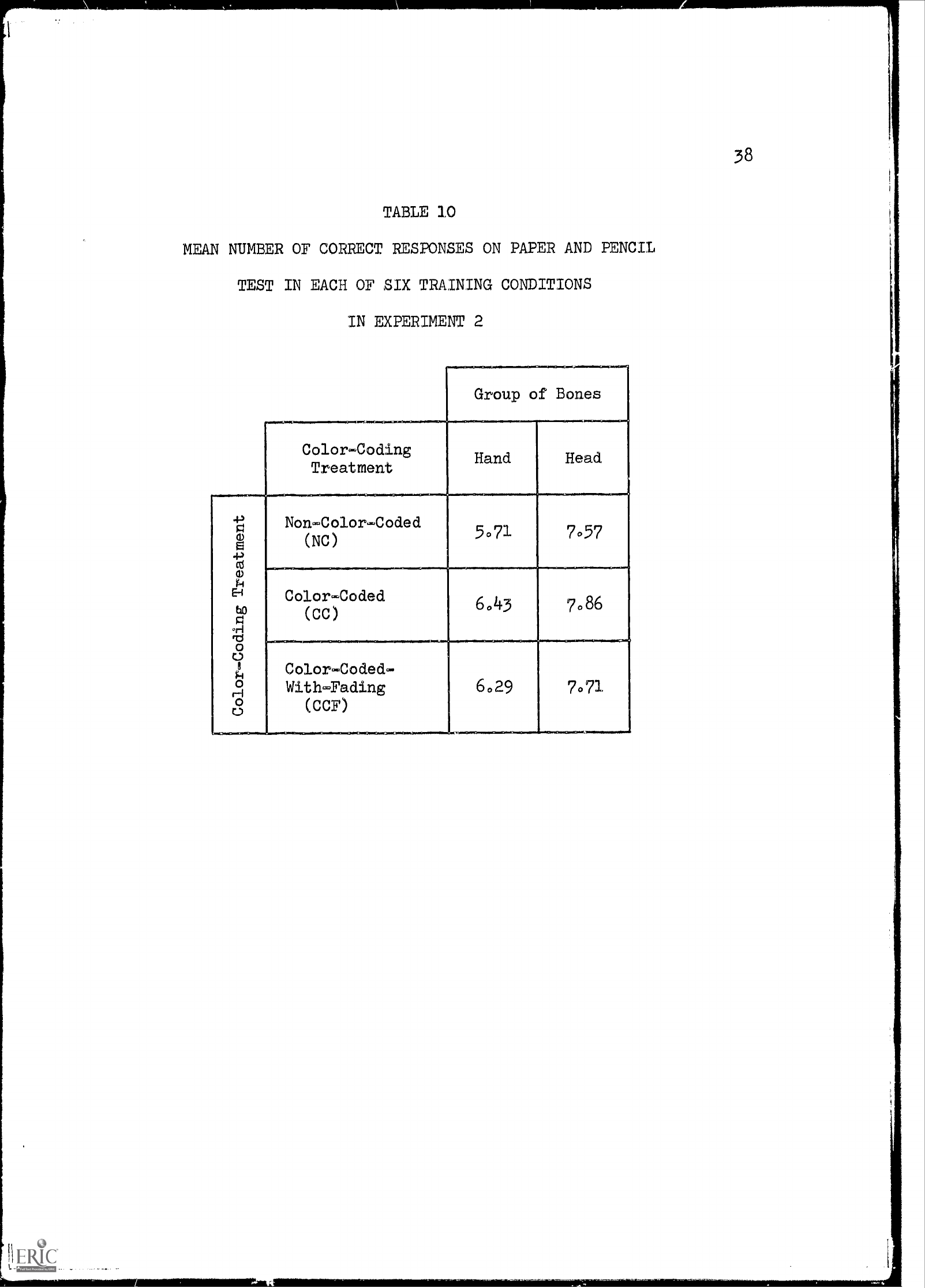
TABLE 10
MEAN NUMBER OF CORRECT RESPONSES ON PAPER AND PENCIL
TEST IN EACH OF SIX TRAINING CONDITIONS
IN EXPERIMENT 2
Non-Color-Coded
(NC)
Color-Coded
(CC)
Group of Bones
Hand
Head
5.71
6043
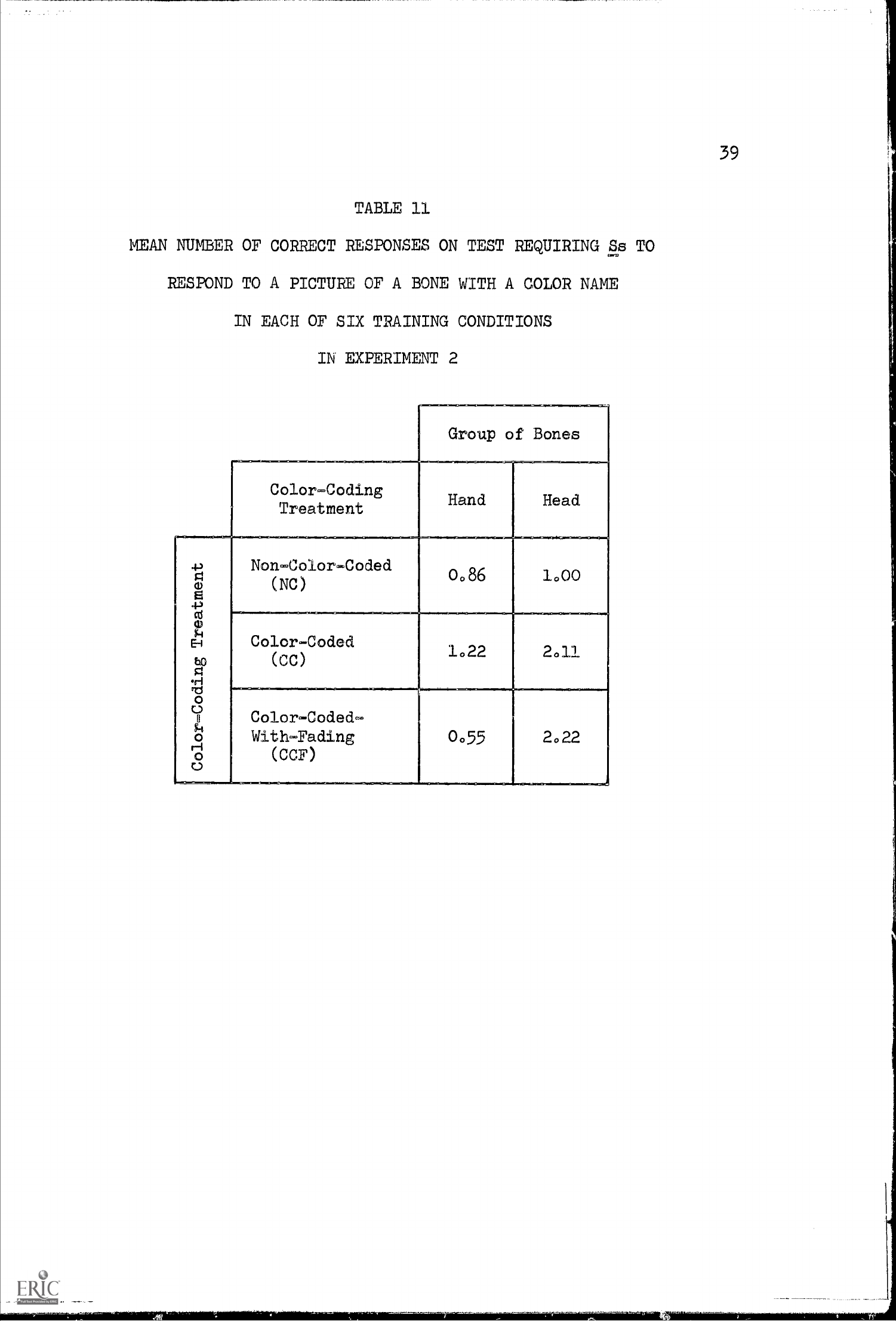
TABLE 11
MEAN NUMBER OF CORRECT RESPONSES ON TEST REQUIRING Ss TO
RESPOND TO A PICTURE OF A BONE WITH A COLOR NAME
IN EACH OF SIX TRAINING CONDITIONS
IN EXPERIMENT 2
Group of Bones
Color-Coding
Treatment
Hand
Non-Color-Coded
(NC)
Color-Coded
(CC)
Color-Coded-
With-Fading
(CCF)
0086
1.22
Head
1.00
0.55
2022
39
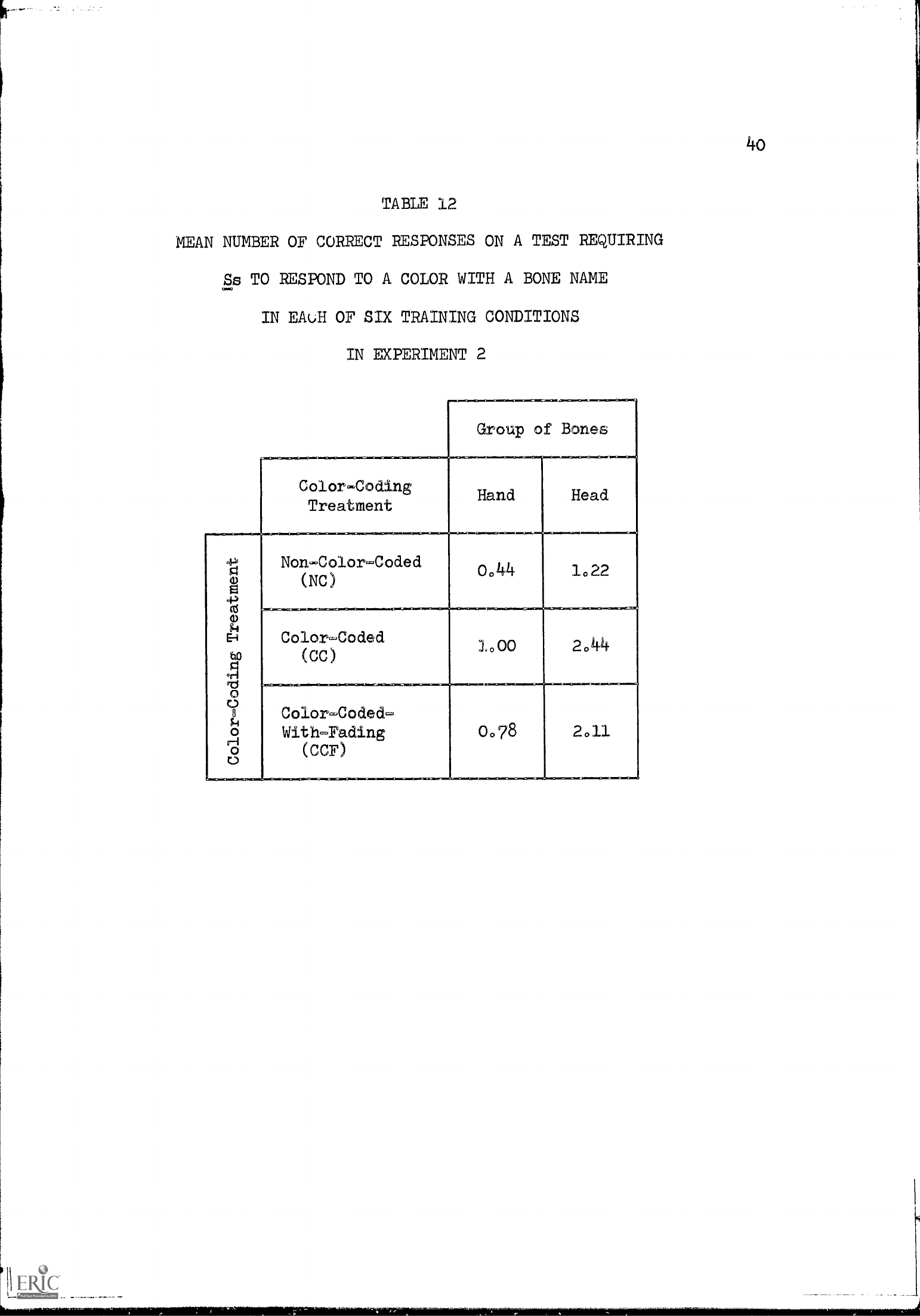
TABLE 12
MEAN NUMBER OF CORRECT RESPONSES ON A TEST REQUIRING
Ss TO RESPOND TO A COLOR WITH A BONE NAME
IN EAuH OF SIX TRAINING CONDITIONS
IN EXPERIMENT 2
Group of Bones
Color-Coding
Treatment
Hand
Head
Non-Color-Coded
(NC)
o,44
1.22
Color-Coded
(CC)
1.00
2044
Color-Coded-
With-Fading
(CCF)
O78 2011
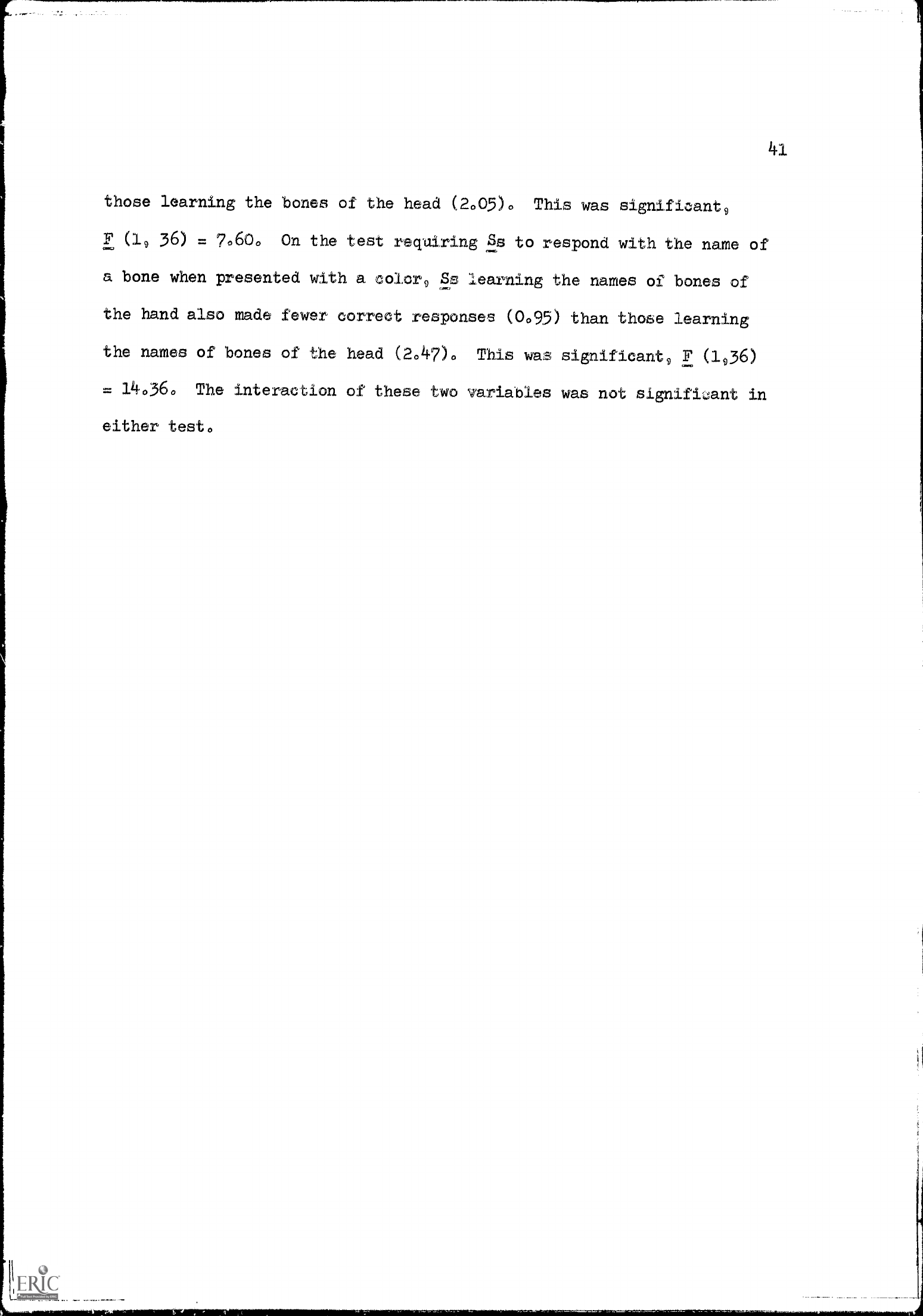
those learning the bones of the head (20 05)0
This was significant9
F (19 36)
=
70600
On the test requiring Ss to respond with the
name of
a bone when presented with a color9 Ss learning the
names of bones of
the hand also made fewer correct
responses (0095) than those learning
the names of bones of the head (2047).
This was significant9 F (1936)
= 140360
The interaction of these two variables
was not signifLJant in
either test.
P.
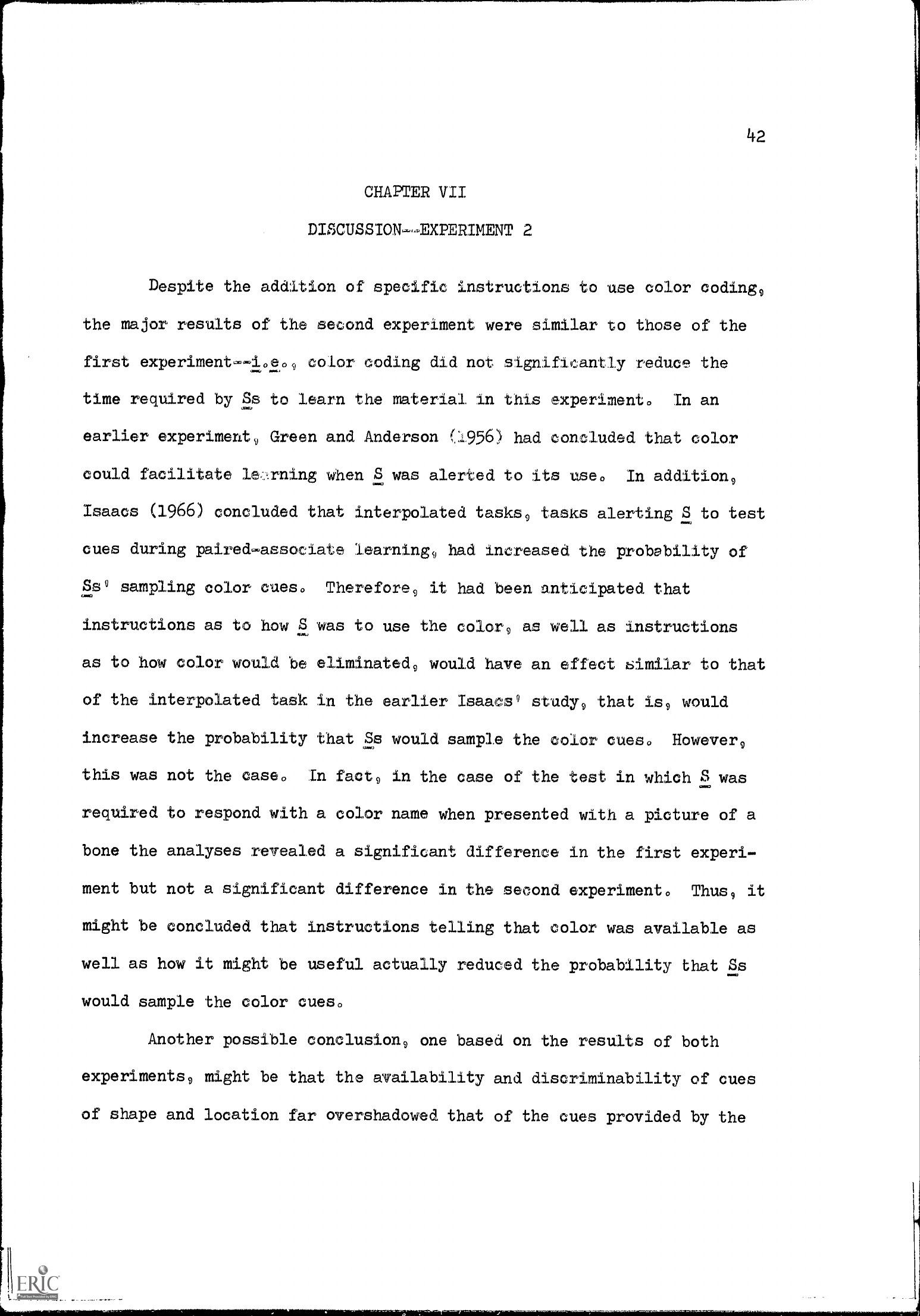
42
CHAPTER VII
DISCUSSION--EXPERIMENT 2
Despite the addition of specific instructions to use color coding9
the major results of the second experiment were similar to those of the
first experiment--i.e.9 color coding did not significantly reduce the
time required by Ss to learn the materia, in this experiment.
In an
earlier experiment, Green and Anderson (:1956) had concluded that color
could facilitate le,rning when S was alerted to its use.
In addition9
Isaacs (1.966) concluded that interpolated tasks9 tasks alerting S to test
cues during paired-associate learning9 had increased the probability of
Ss' sampling color cues.
Therefore9 it had been anticipated that
instructions as to how S was to use the color9 as well as instructions
as to how color would be eliminated9 would have an effect similar to that
of the interpolated task in the earlier Isaacs' study9 that is9 would
increase the probability that Ss would sample the color
cues. However9
this was not the case.
In fact9 in the case of the test in which S was
required to respond with a color name when presented with
a picture of a
bone the analyses revealed a significant difference in the first experi-
ment but not a significant difference in the second experiment.
Thus9 it
might be concluded that instructions telling that color
was available as
well as how it might be useful actually reduced the probability that Ss
would sample the color cues.
Another possible conclusion9 one based on the results of both
experiments9 might be that the availability and discriminability of
cues
of shape and location far overshadowed that of the
cues provided by the
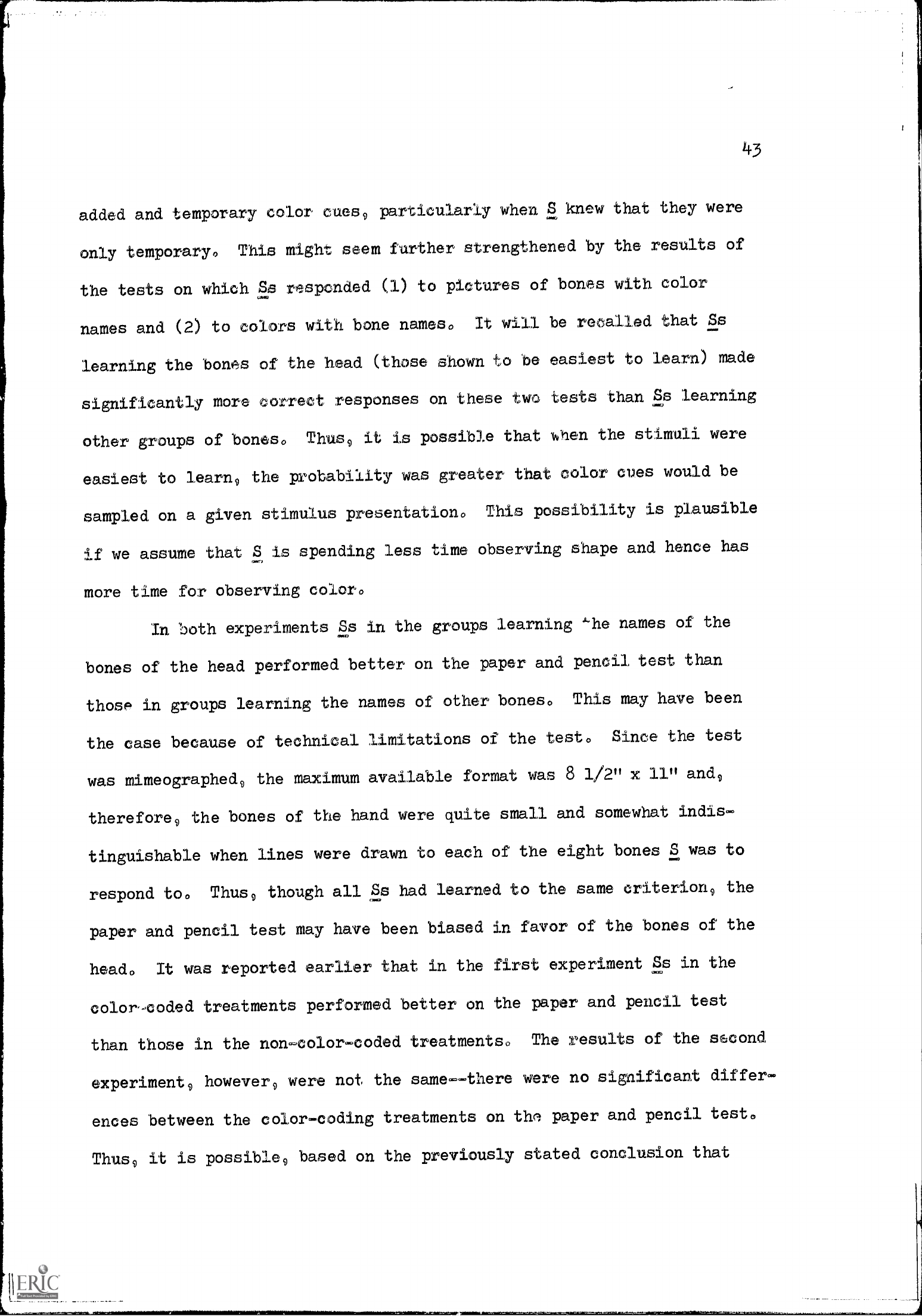
43
added and temporary color cues9
particularly when S knew that they were
only temporary.
This might seem further strengthened
by the results of
the tests on which Ss
responded (1) to pictures of bones with
color
names and
(2) to colors with bone names.
It will be recalled that
Ss
learning the bones of the head
(those shown to be easiest to
learn) made
significantly more correct responses on
these two tests than Ss
learning
other groups of bones.
Thus9 it is possible that when the
stimuli were
easiest to learn9 the probability was
greater that color cues would
be
sampled on a given stimulus
presentation.
This possibility is plausible
if we assume that S is spending
less time observing shape and hence
has
more time for
observing color.
In both experiments Ss in the groups
learning 4-he names of the
bones of the head performed better on
the paper and pencil test than
those in groups learning the names
of other bones.
This may have been
the case because of technical
limitations of the test.
Since the test
was mimeographed9
the maximum available format was
8 1/2" x 11" and9
therefore9 the bones of the hand were
quite small and somewhat indis-
tinguishable when lines were drawn to
each of the eight bones S was to
respond to.
Thus9 though all Ss had learned to
the same criterion9 the
paper and pencil test may
have been biased in favor of the
bones of the
head.
It was reported earlier that in the
first experiment Ss in the
color-coded treatments performed
better on the paper and pencil test
than those in the non-color-coded
treatments.
The results of the second
experiment9 however9 were not the same--there were
no significant differ-
ences between the
color-coding treatments on the paper
and pencil test.
Thus9 it is possible9 based on the
previously stated conclusion that
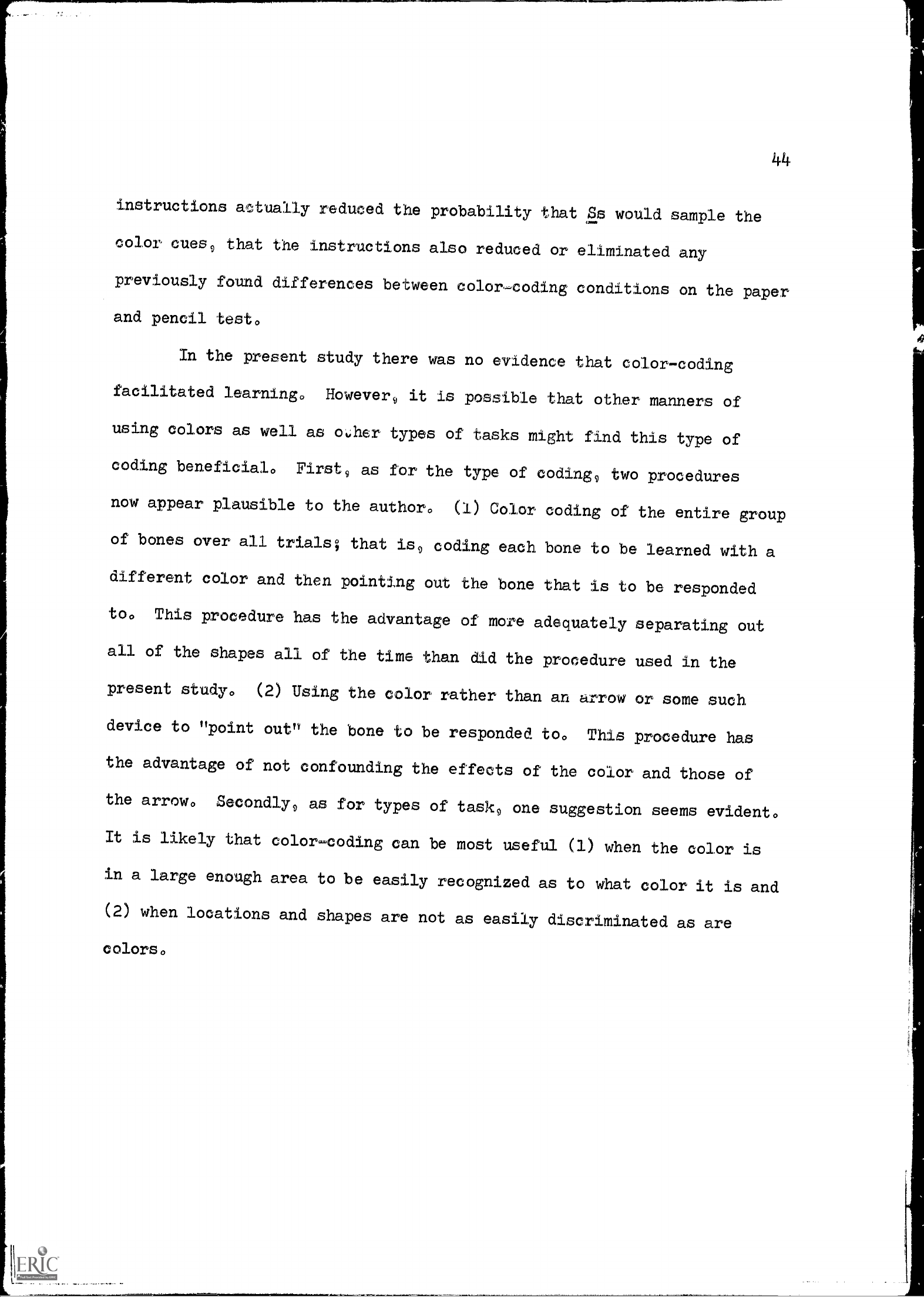
44
instructions actually reduced
the probability that Ss
would sample the
color cues
that the instructions
also reduced or eliminated
any
previously found differences
between color-coding
conditions on the
paper
and pencil test.
In the present study there
was no evidence that color-coding
facilitated learning.
However9 it is possible
that other
manners of
using colors
as well as 'puller types of tasks
might find this type
of
coding beneficial.
First9 as for the type
of coding9 two procedures
now appear plausible to the author.
(1) Color coding
of the entire
group
of bones over all
trials; that is9 coding
each bone to be learned
with a
different color and then
pointing out the bone
that is to be responded
to.
This procedure has the
advantage of
more adequately separating out
all of the shapes
all of the time than
did the procedure used
in the
present study.
(2) Using the
color rather than
an arrow or some such
device to "point out's
the bone to be responded
to.
This procedure has
the advantage of not
confounding the effects
of the color and those
of
the arrow.
Secondly9 as for types
of task9 one suggestion
seems evident.
It is likely that
color-coding can be most
useful (1) when the color
is
in a large enough
area to be easily recognized
as to what color it is and
(2) when locations
and shapes are not
as easily discriminated
as are
colors.
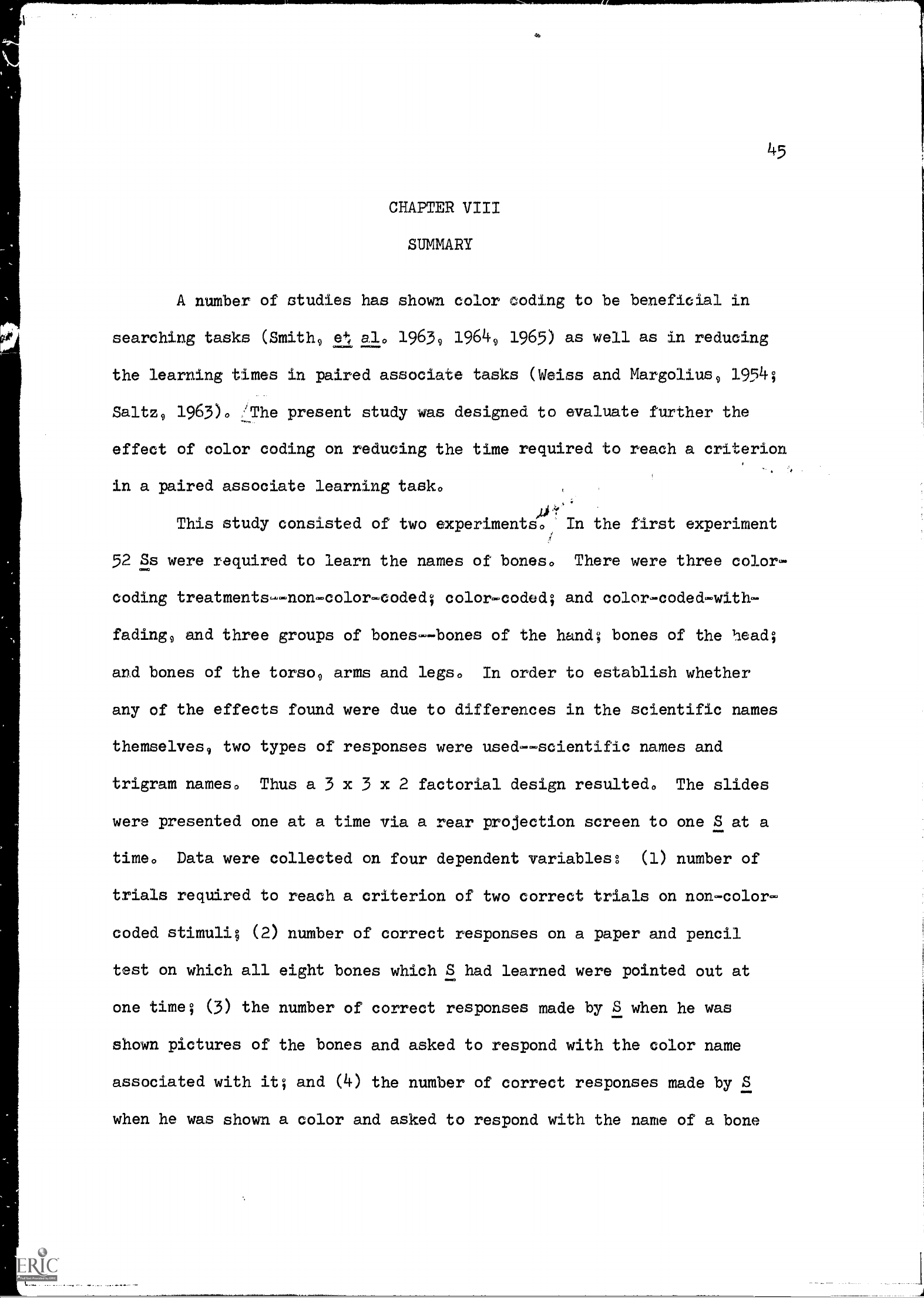
CHAPTER VIII
SUMMARY
A number of studies has shown color coding to be beneficial in
searching tasks (Smith9 e el. 19639 19649 1965) as well as in reducing
the learning times in paired associate tasks (Weiss and Margoiius9 1954;
Saltz9 1963). 'The present study was designed to evaluate further the
effect of color coding on reducing the time required to reach a criterion
in a paired associate learning task.
This study consisted of two experiments.
In the first experiment
52 Ss were required to learn the names of bones.
There were three colors
coding treatmentsnon-color-coded; color-coded; and color-coded-with-
fading9 and three groups of bones--bones of the hand; bones of the head;
and bones of the torso9 arms and legs.
In order to establish whether
any of the effects found were due to differences in the scientific names
themselves9 two types of responses were used--scientific names and
trigram names.
Thus a 3 x 3 x 2 factorial design resulted. The slides
were presented one at a time via a rear projection screen to one S at a
time.
Data were collected on four dependent variables: (1) number of
trials required to reach a criterion of two correct trials on non-color-
coded stimuli; (2) number of correct responses on a paper and pencil
test on which all eight bones which S had learned were pointed out at
one time; (3) the number of correct responses made by S when he was
shown pictures of the bones and asked to respond with the color name
associated with it; and (4) the number of correct responses made by S
when he was shown a color and asked to respond with the name of a bone
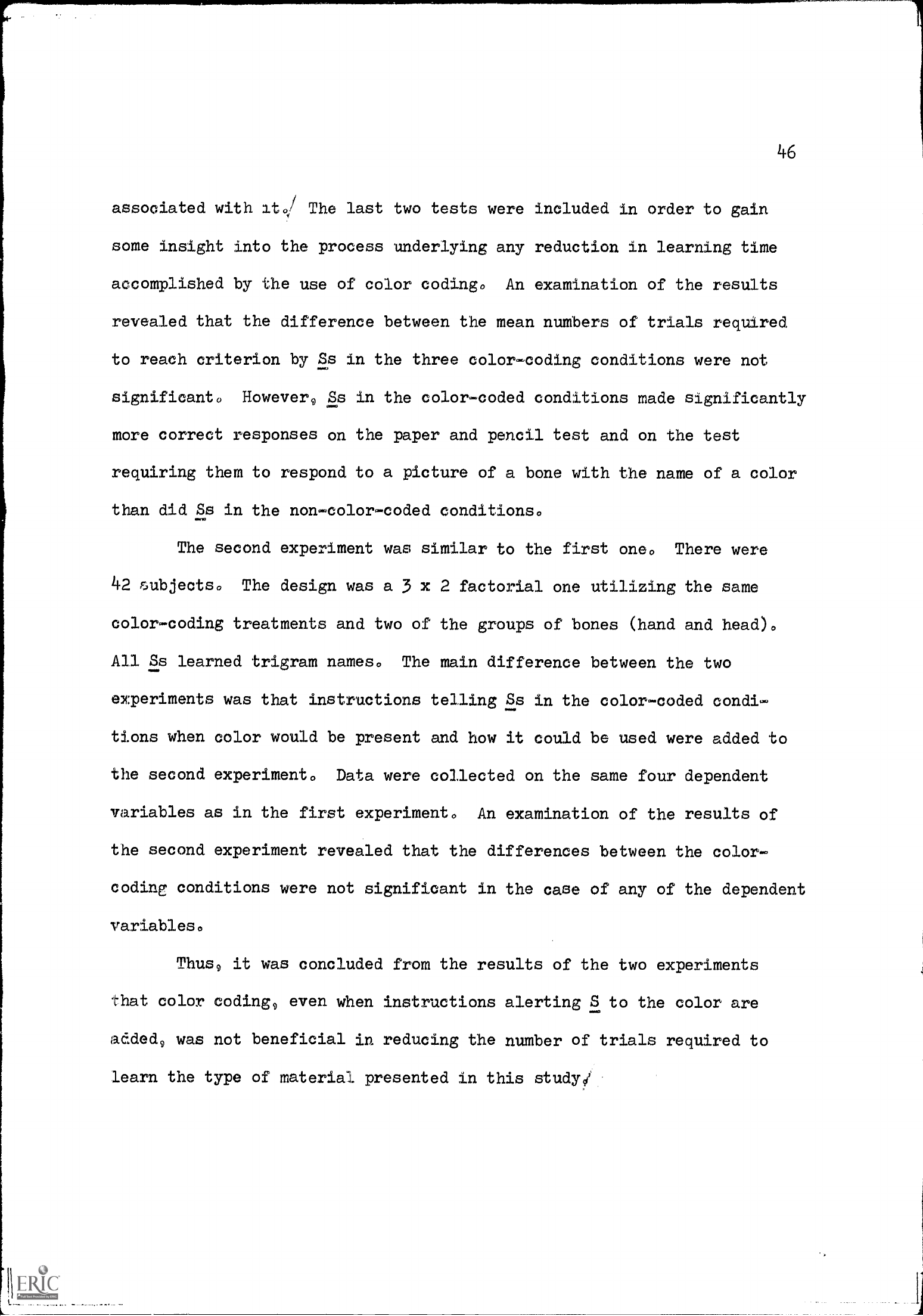
1+6
associated with it o/ The last two tests were included in order to gain
some insight into the process underlying any reduction in learning time
accomplished by the use of color coding°
An examination of the results
revealed that the difference between the mean numbers of trials required
to reach criterion by Ss in the three color-coding conditions were not
significant°
However9 Ss in the color-coded conditions made significantly
more correct responses on the paper and pencil test and on the test
requiring them to respond to a picture of a bone with the name of a color
than did Ss in the non-color-coded conditions°
The second experiment was similar to the first oneo
There were
42 r.mbjectso
The design was a 3 x 2 factorial one utilizing the same
color-coding treatments and two of the groups of bones (hand and head)0
All Ss learned trigram names°
The main difference between the two
experiments was that instructions telling Ss in the color-coded condi-
tions when color would be present and how it could be used were added to
the second experiment.
Data were collected on the same four dependent
variables as in the first experiment°
An examination of the results of
the second experiment revealed that the differences between the color-
coding conditions were not significant in the case of any of the dependent
variables.
Thus9 it was concluded from the results of the two experiments
that color coding9 even when instructions alerting S to the color
are
added9 was not beneficial in reducing the number of trials required to
learn the type of material presented in this study/

REFERENCES
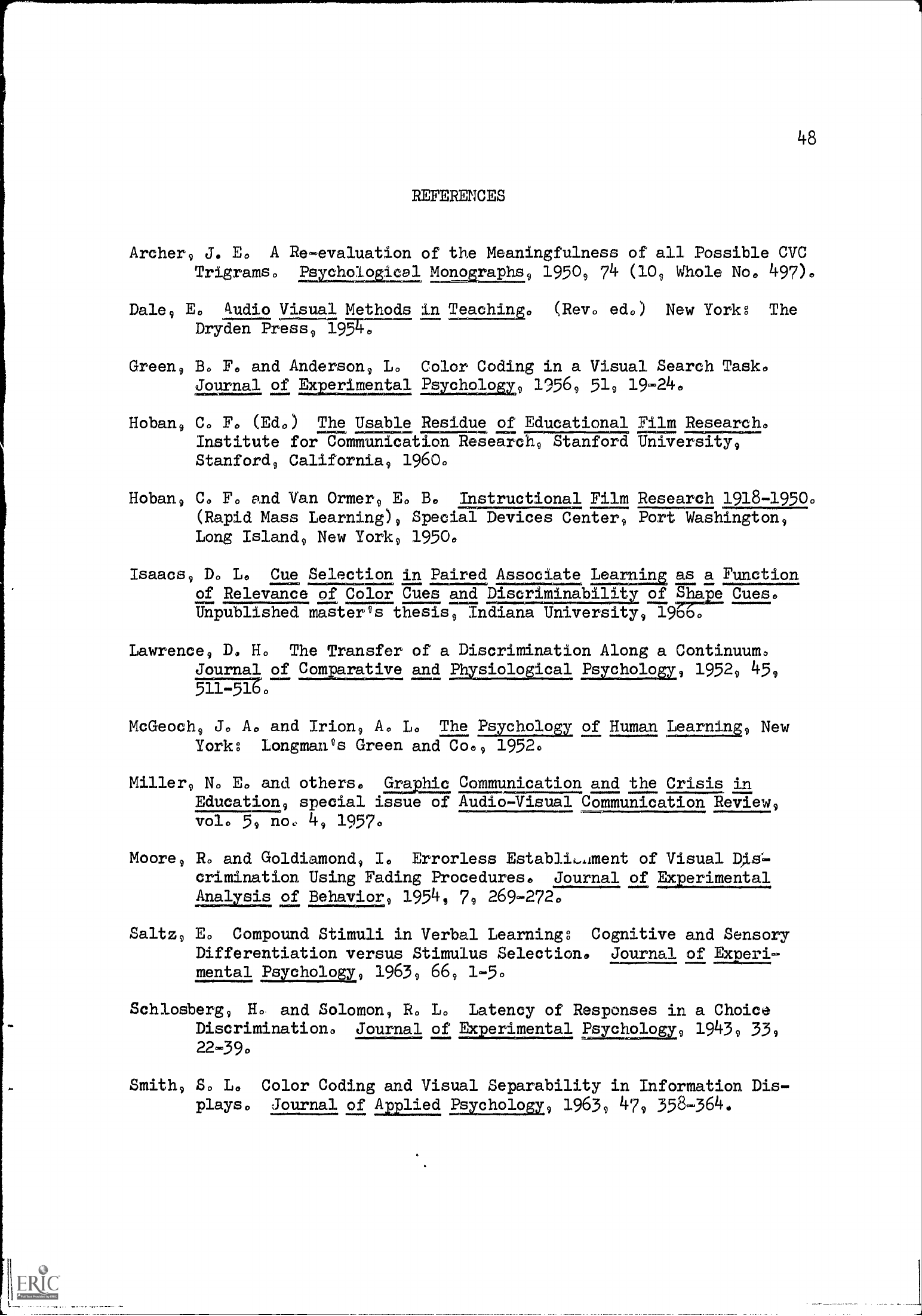
1+8
REFERENCES
Archer9 J. E.
A Re-evaluation of the Meaningfulness of all Possible CVC
Trigrams.
219.x2h2121 MonoEraphs9 19509 74 (109 Whole No, 497)
.
Dale9 E. Midi() Visual Methods in TeachinE. (Rev. ed.) New York: The
Dryden Press9
Green9 B. F. and Anderson9 L.
Color Coding in a Visual Search Task.
Journal of amisental pacholoa9 19569 519 19-24.
Hoban9 C. F. (Ed.)
The Usable Residue of Educational Film Research.
Institute for Communication Research9 Stanford University9
Stanford9 California9 1960.
Hoban9 C. F. and Van Ormer9 E. B. Instructional Film Research 1918-1950.
(Rapid Mass Learning)9 Special Devices Center9 Port Washington9
Long Island9 New York9 1950.
Isaacs9 D. L. Cue Selection in Paired Associate ltamipz. as a Function
of Relevance of Color Cues and pisslasilpabilitx of *22 Cues.
Unpublished master's thesis9 Indiana University9 19oo.
Lawrence9 D. H.
The Transfer of a Discrimination Along a Continuum.
Journal of Comparative and Easiological Psychology9 19529 459
511-51g.
McGeoch9 J. A. and Irion9 A. L.
The Psychology of Human Learning9 New
York: Longman's Green and Co.9 1952.
Miller9 N. E. and others. amus Communication and the Crisis in
Education9 special issue of Audio-Visual Communication Review9
vol. 59 no
49 1957,
Moore9 R. and Goldiamond9 I.
Errorless Establik,,iment of Visual Dis"-
crimination Using Fading Procedures.
Journal of Experimental
Analysis of Behavior9 19549 79 269-272.
Saltz9 E.
Compound Stimuli in Verbal Learning: Cognitive and Sensory
Differentiation versus Stimulus Selection.
Journal of Experi-
mental Psychology9 19639 669 1-5.
Schlosberg9
H. and Solomon9 R. L. Latency of Responses in a Choice
Discrimination.
Journal of Experimental Psychology9 19439 339
22-39.
Smith9 S. L. Color Coding and Visual Separability in Information Dis-
plays.
Journal of Applied Psychology9 19639 479 358364.
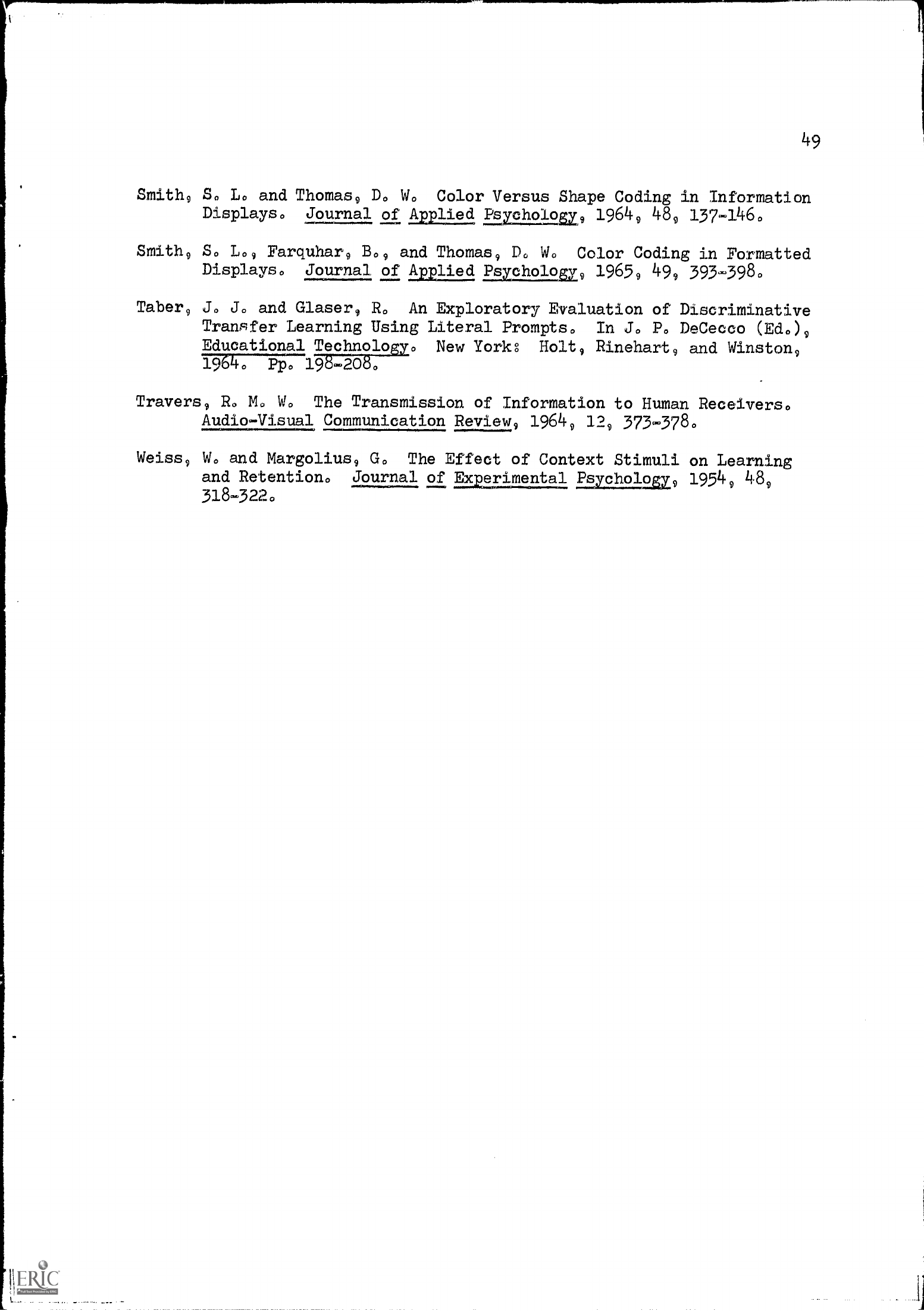
1+9
Smith9 S. L. and Thomas9 D. Wo
Color Versus Shape Coding in Information
Displays°
Journal of A221121 Psychology
9
19649 489 137-146.
Smith9 So Log Farquhar9 Bog and Thomas9 D. Wo
Color Coding in Formatted
Displays°
Journal of Ap22121, psycholozzo 19659 499 393-3980
Taber9 J. J. and Glaser9 R0
An Exploratory Evaluation of Discriminative
Transfer Learning Using Literal Prompts°
In Jo P. DeCecco (Ed0)9
Educational Technolo
0
New York
Holt9 Rinehart9 and Winston9
17640
Pp0 19 -20
.
Travers9 R. M. W0
The Transmission of Information to Human Receivers°
Audio-Visual Communication Reviews 19649 129 373-3780
Weiss9 Wo and Margolius9 Go
The Effect of Context Stimuli on Learning
and Retention°
Journal of aperimental Esmizaam9 19549 489
318-322,

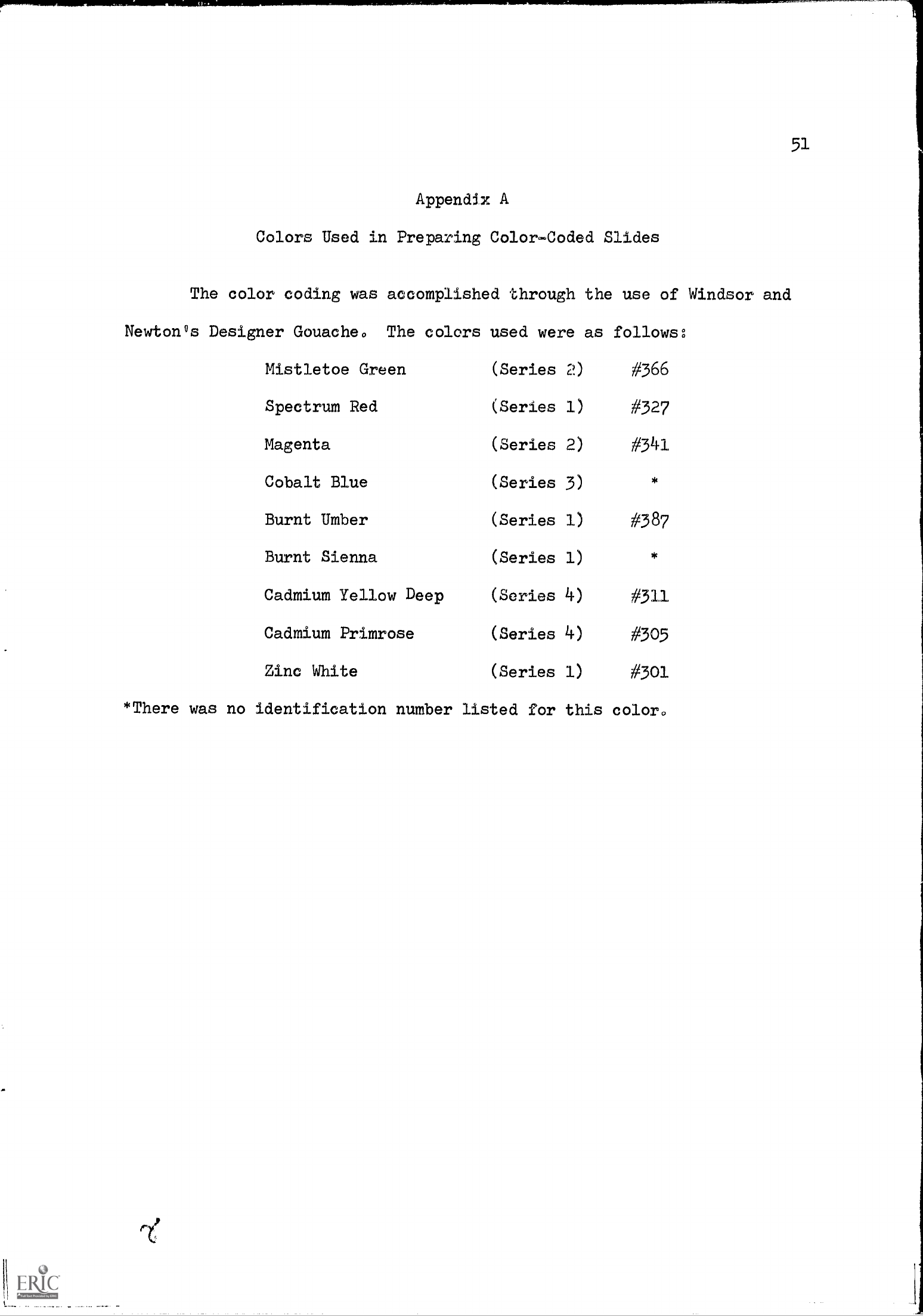
51
AppendJx A
Colors Used in Preparing Color-Coded Slides
The color coding was accomplished through the use of Windsor and
NewtonQs Designer Gouache.
The colors used were as follows:
Mistletoe Green
(Series 2) #366
Spectrum Red
(Series 1)
#327
Magenta
(Series 2)
#341
Cobalt Blue
(Series 3)
Burnt Umber
(Series 1)
#387
Burnt Sienna
(Series 1)
Cadmium Yellow Deep
(Series 4)
#311
Cadmium Primrose
(Series 4)
#305
Zinc White
(Series 1)
#301
*There was no identification number listed for this color.
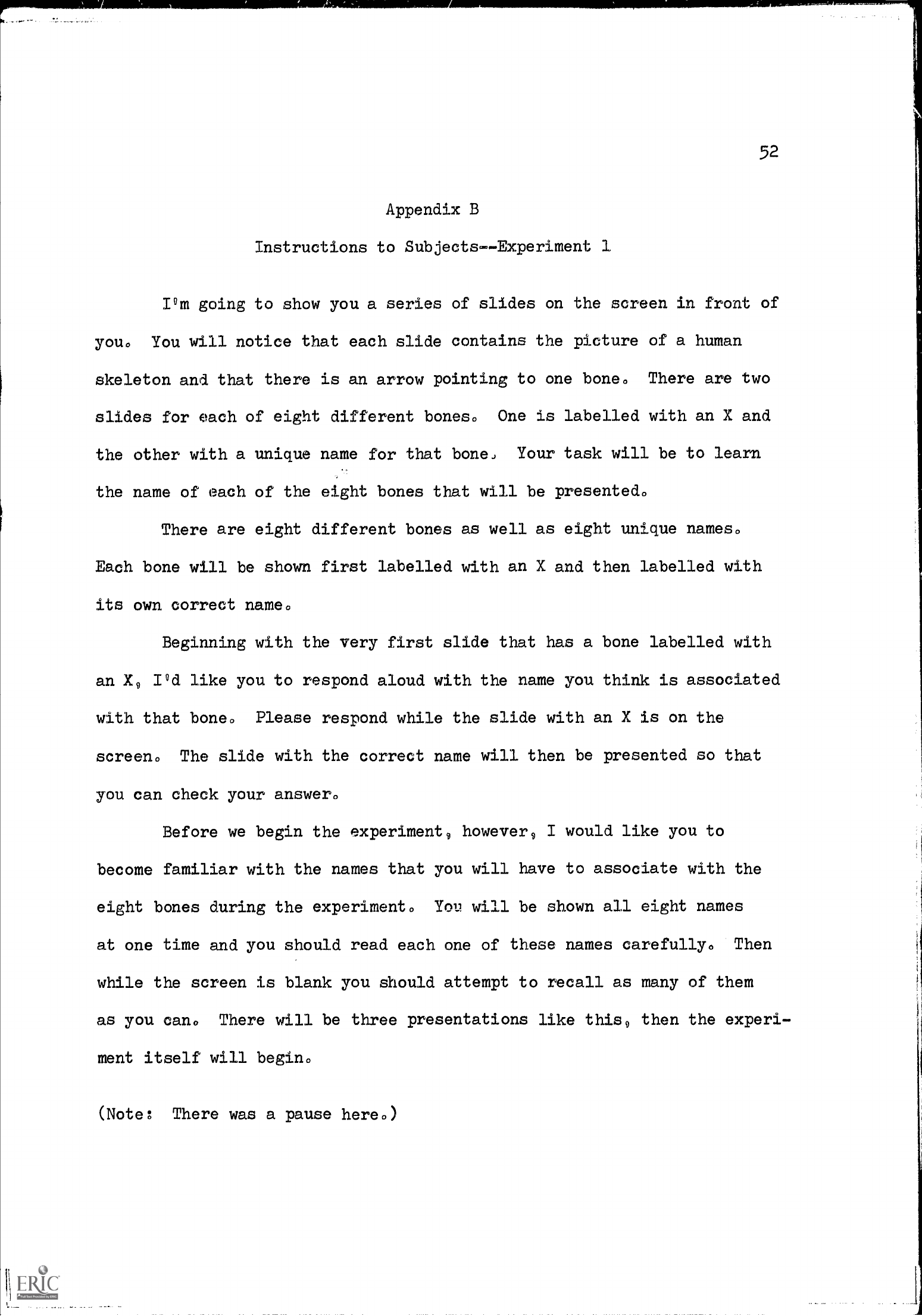
52
Appendix B
Instructions to Subjects--Experiment 1
I'm going to show you a series of slides on the screen in front of
you.
You will notice that each slide contains the picture of a human
skeleton and that there is an arrow pointing to one bone.
There are two
slides for each of eight different bones.
One is labelled with an X and
the other with a unique name for that bone,
Your task will be to learn
the name of each of the eight bones that will be presented.
There are eight different bones as well as eight unique names.
Each bone will be shown first labelled with an X and then labelled with
its own correct name.
Beginning with the very first slide that has a bone labelled with
an X9 I'd like you to respond aloud with the name you think is associated
with that bone.
Please respond while the slide with an X is on the
screen.
The slide with the correct name will then be presented so that
you can check your answer.
Before we begin the experiments however9 I would like you to
become familiar with the names that you will have to associate with the
eight bones during the experiment.
You will be shown all eight names
at one time and you should read each one of these names carefully.
Then
while the screen is blank you should attempt to recall as many of them
as you can.
There will be three presentations like this9 then the experi-
ment itself will begin.
(Note:
There was a pause here.)
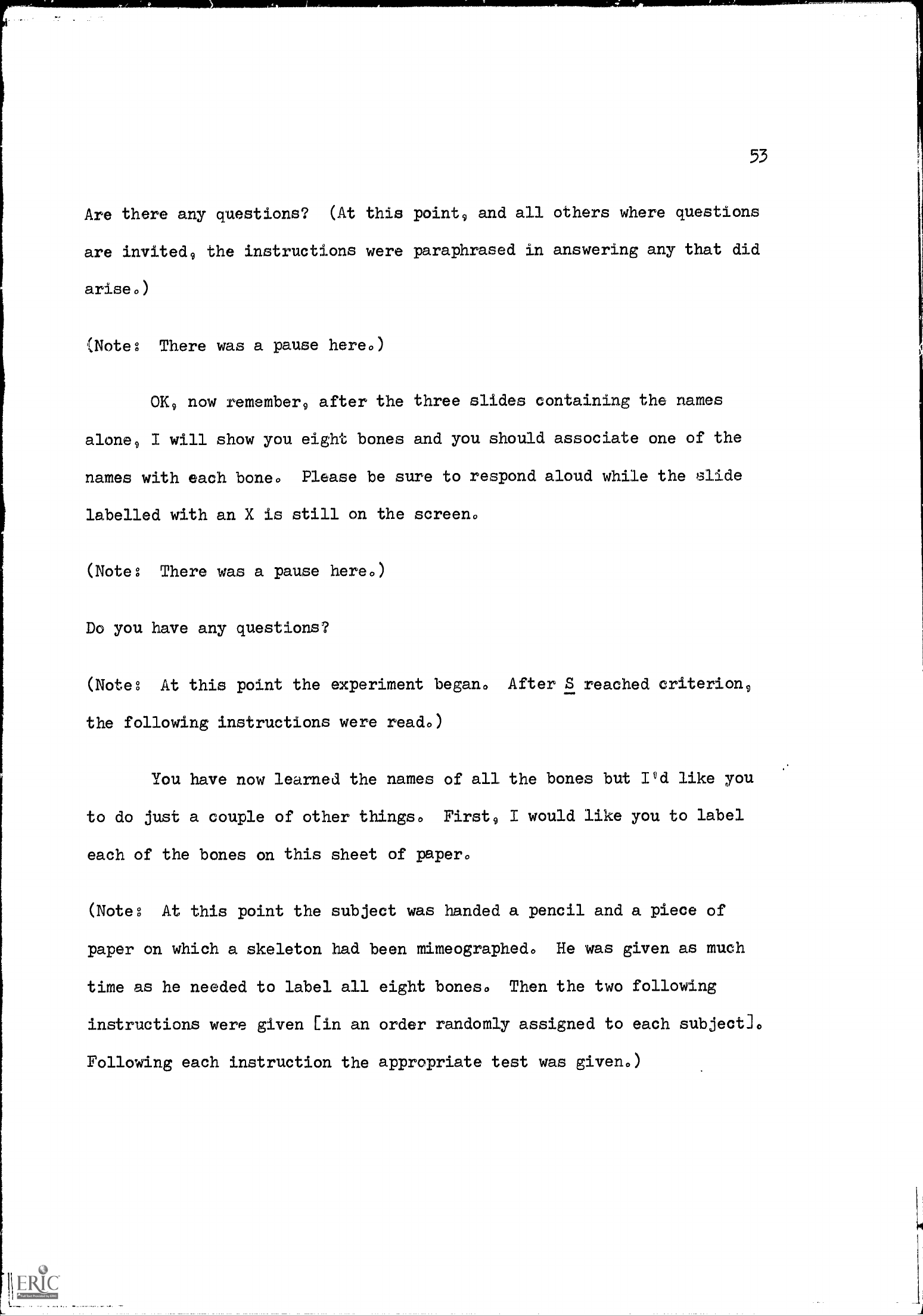
53
Are there any questions?
(At this point9 and all others where questions
are invited9 the instructions were paraphrased
in answering any that did
arise.)
(Notes
There was a pause here.)
OK9 now remember9 after the three slides containing the names
alone9 I will show you eight bones and you should associate one of the
names with each bone.
Please be sure to respond aloud while the slide
labelled with an X is still on the screen.
(Note:
There was a pause here.)
Do you have any questions?
(Note:
At this point the experiment began.
After S reached criterion9
the following instructions were read.)
You have now learned the names of all the bones but I'd like you
to do just a couple of other things.
First9 I would like you to label
each of the bones on this sheet of paper.
(Notes
At this point the subject was handed a pencil and a piece of
paper on which a skeleton had been mimeographed.
He was given as much
time as he needed to label all eight bones.
Then the two following
instructions were given an an order randomly assigned to each subject].
Following each instruction the appropriate test was given.)
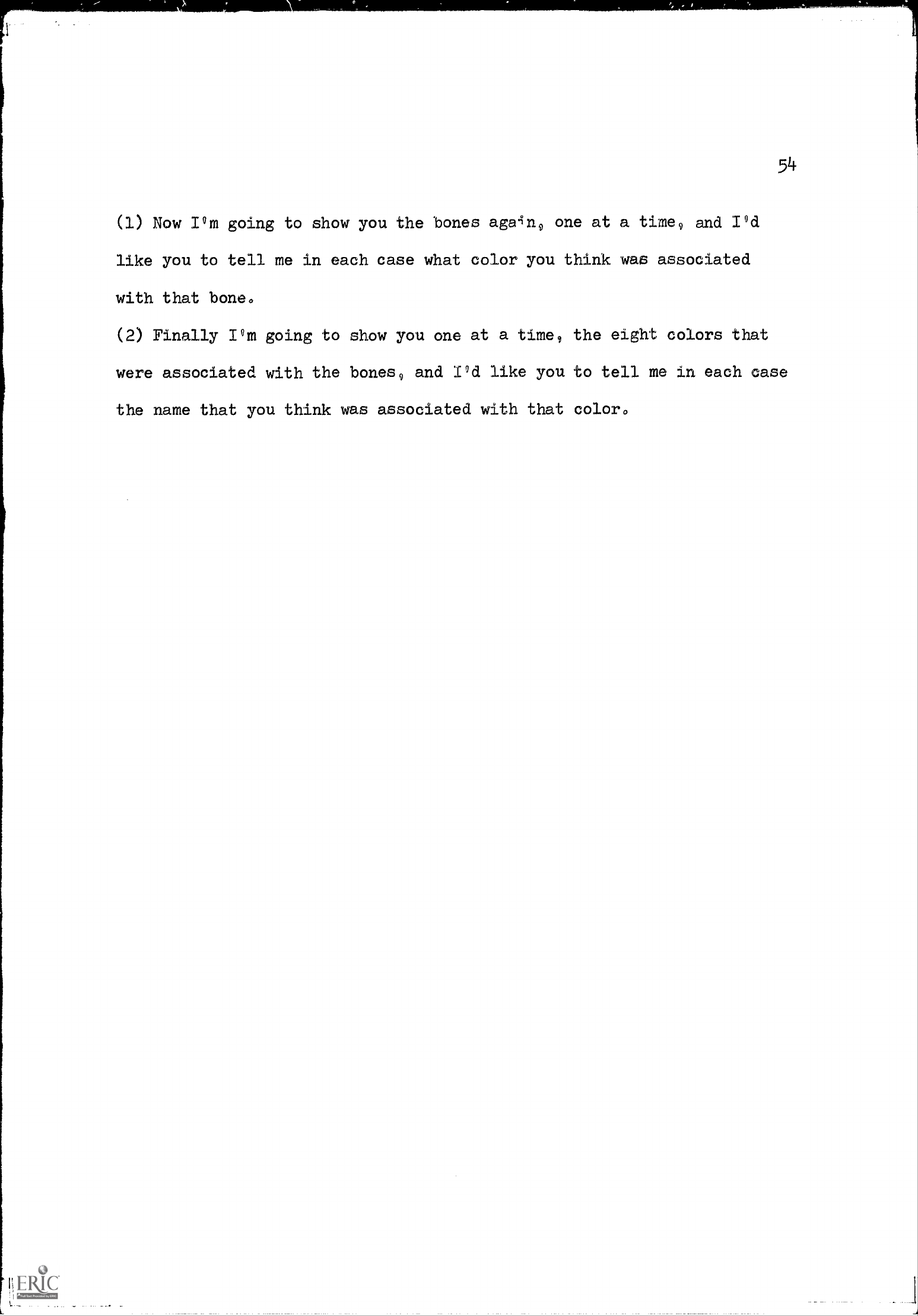
51+
(1) Now I'm going to show you the bones aga4n9 one at a time9 and I'd
like you to tell me in each case what color you think was associated
with that bone.
(2) Finally I'm going to show you one at a time9 the eight colors that
were associated with the bones9 and I9d like you to tell me in each case
the name that you think was associated with that color.
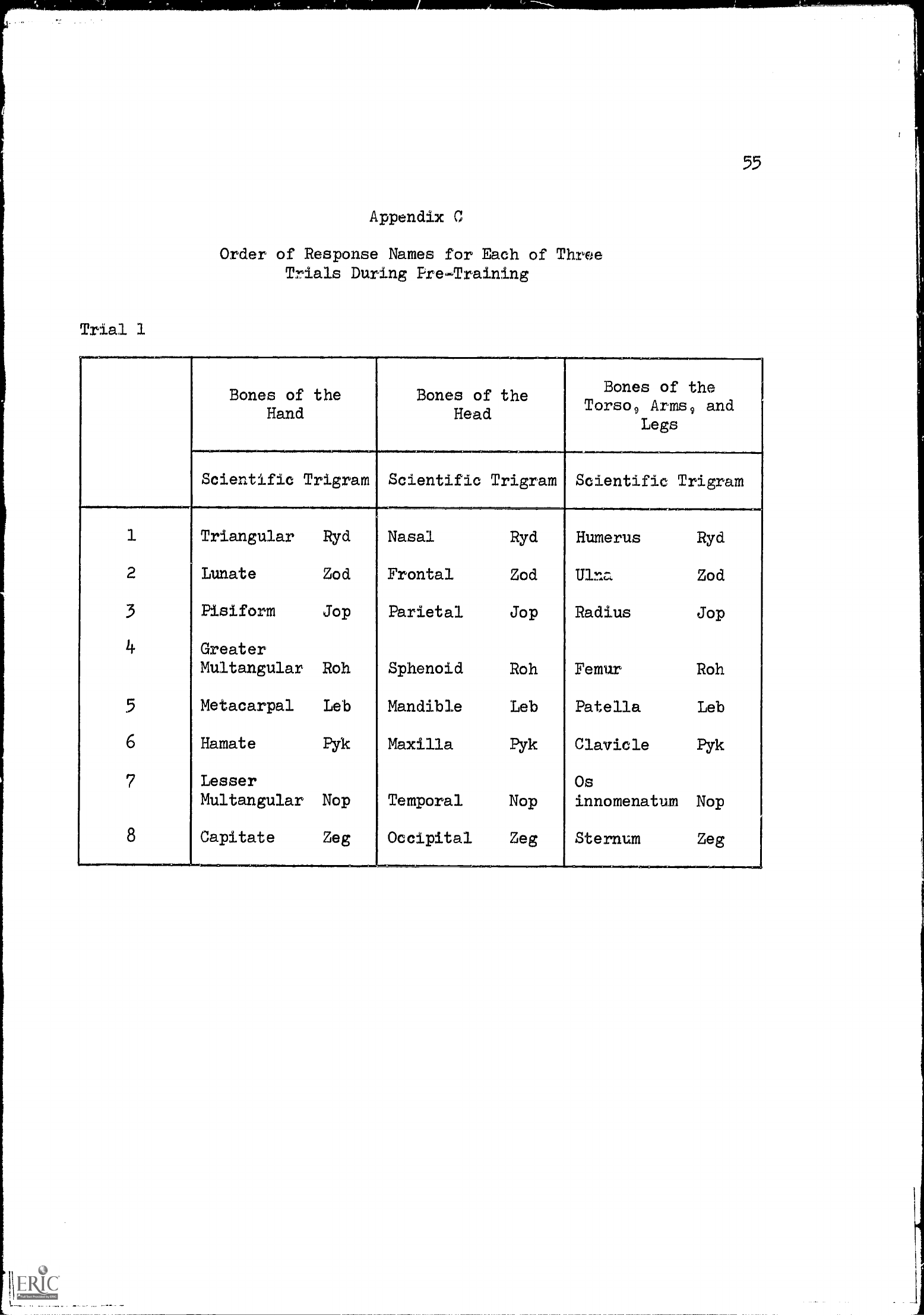
Appendix C
Order of Response Names for Each of Three
Trials During Pre-Training
Trial 1
55
Bones of the
Hand
Bones of the
Head
Bones of the
Torso9 Arms9 and
Legs
Scientific Trigram
Scientific Trigram
Scientific Trigram
1
Triangular
Ryd
Nasal
Ryd
Humerus
Ryd
2
Lunate
Zod Frontal
Zod Ulna.
Zod
3
Pisiform
Jop
Parietal
Jop Radius
Jop
4
Greater
Multangular
Roh Sphenoid
Roh
Femur
Roh
5
Metacarpal
Leb
Mandible
Leb Patella
Leb
6
Hamate
Pyk
Maxilla Pyk
Clavicle Pyk
7
Lesser
Os
Multangular
Nop Temporal
Nop
innomenatum
Nop
8 Capitate
Zeg
Occipital Zeg
Sternum
Zeg
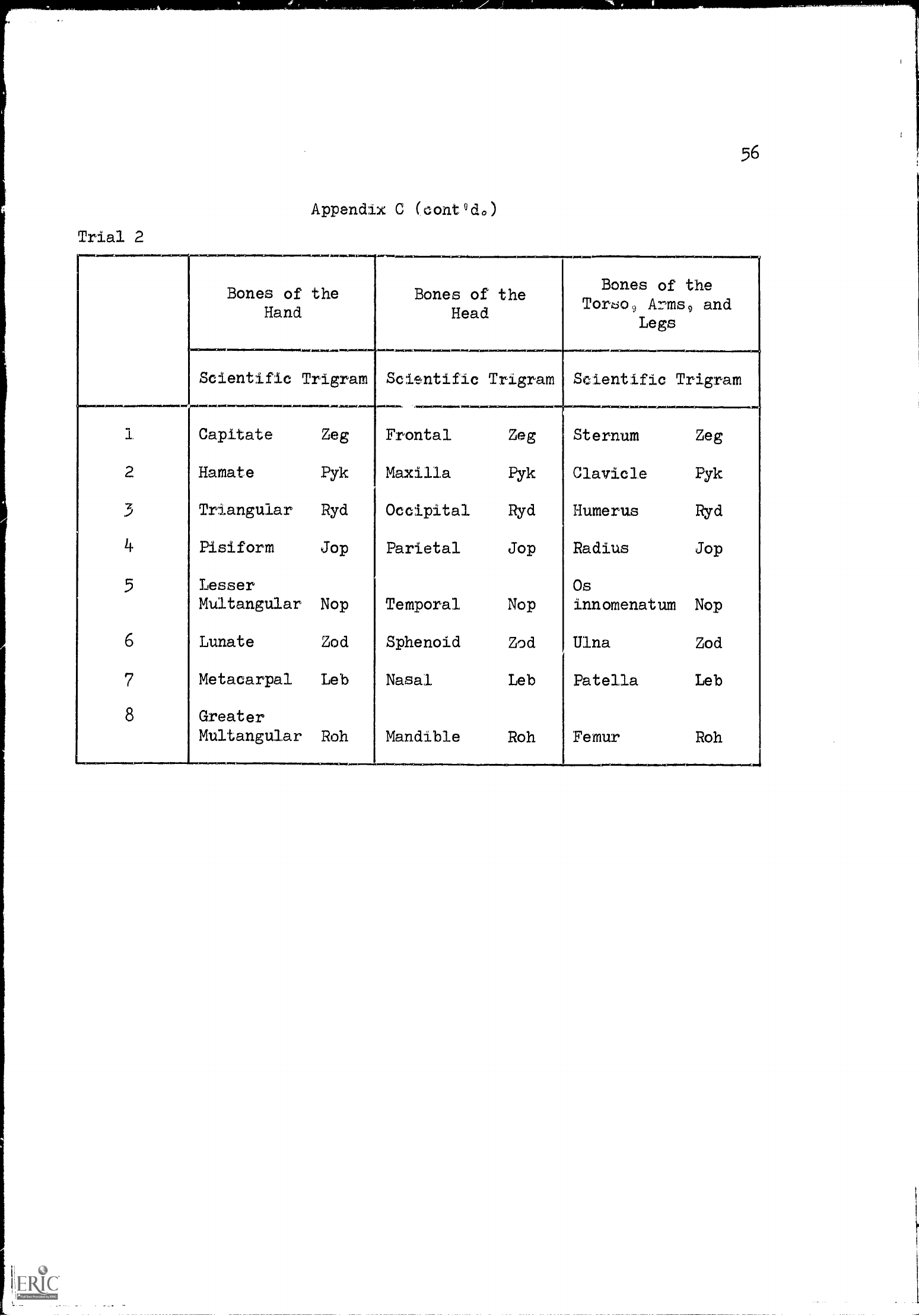
Appendix C (contudo)
Trial 2
56
.M7MG7M
Bones of the
Bones of the
Bones of the
Hand
Head
Torsos Arms9 and
Legs
.
.1..cgem,........70011,211.10..
Scientific Trigram
.MWIN#0.
Scientific Trigram
Scientific Trigram
Capitate
Zeg
Frontal Zeg
Sternum
Zeg
2
Hamate
Pyk
Maxilla
Pyk Clavicle Pyk
7
..)
Triangular
Ryd
Occipital
Ryd Humerus
Ryd
4
Pisiform
Jop Parietal
Jop Radius
Jop
5
Lesser
Os
Multangular Nop
Temporal Nop
innomenatum
Nop
6 Lunate
Zod Sphenoid
Zod Ulna
Zod
7
Metacarpal Leb Nasal
Leb
Patella Leb
8
Greater
Multangular
Roh
Mandible
Roh Femur
Roh
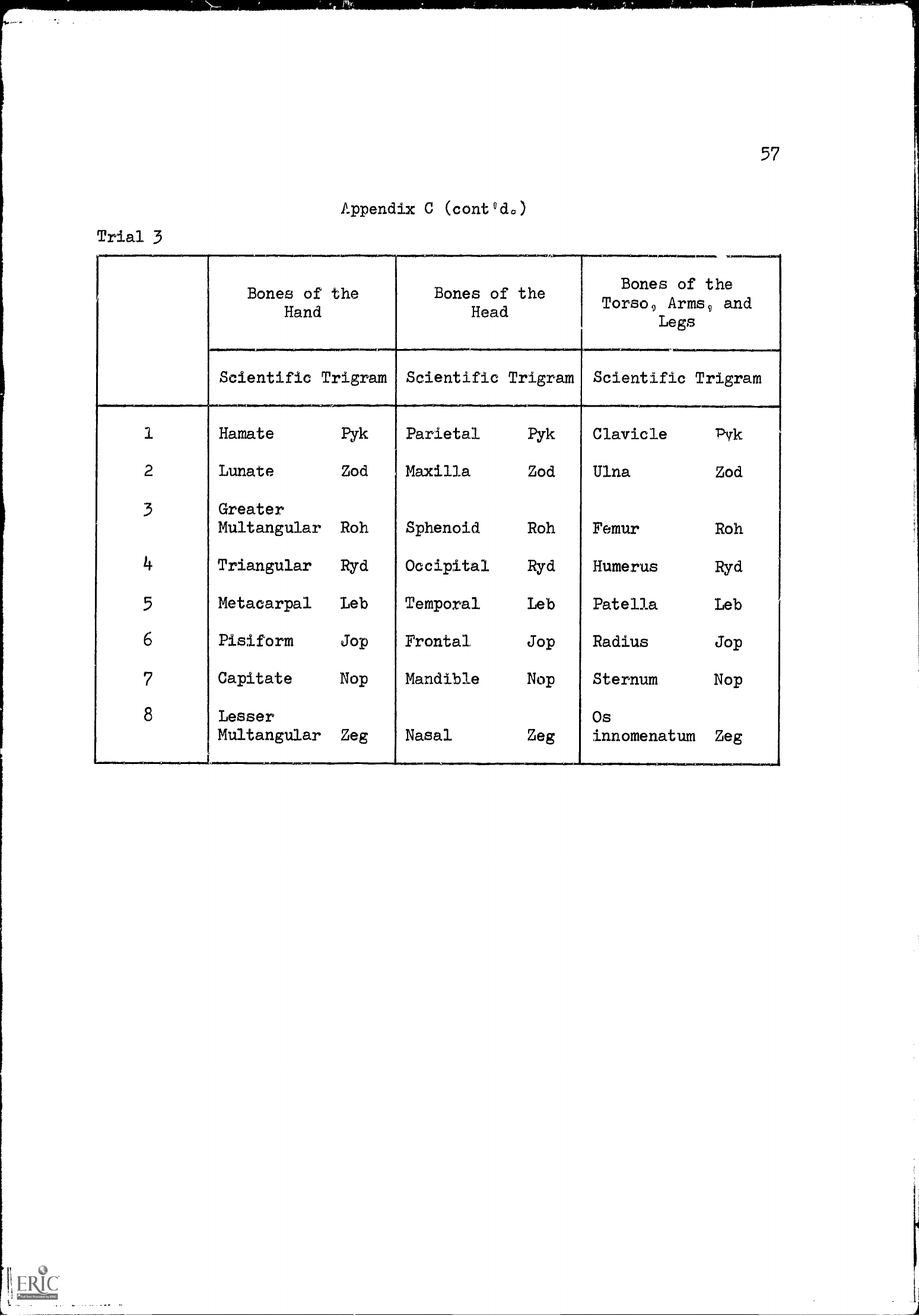
Appendix C (contudo)
Trial
3
57
P
...10.0.01.=Woraia IC7Mi
Bones of the
Hand
Bones of the
Head
Bones of the
Torso
Arms9 and
Legs
---_____
Scientific Trigram
Scientific Trigram
Scientific Trigram
1 Hamate
Pyk Parietal
Pyk
Clavicle
Pyk
2 Lunate
Zod Maxilla
Zod
Ulna
Zod
3
Greater
Multangular Roh
Sphenoid
Roh Femur
Roh
4 Triangular
Ryd
Occipital Ryd
Humerus
Ryd
5
Metacarpal
Leb
Temporal
Leb
Patella
Leb
6 Pisiform
Jop
Frontal.
Jop Radius
Jop
7
Capitate
Nop
Mandible Nop Sternum
Nop
8
Lesser
Os
Multangular Zeg Nasal
Zeg
innomenatum
Zeg
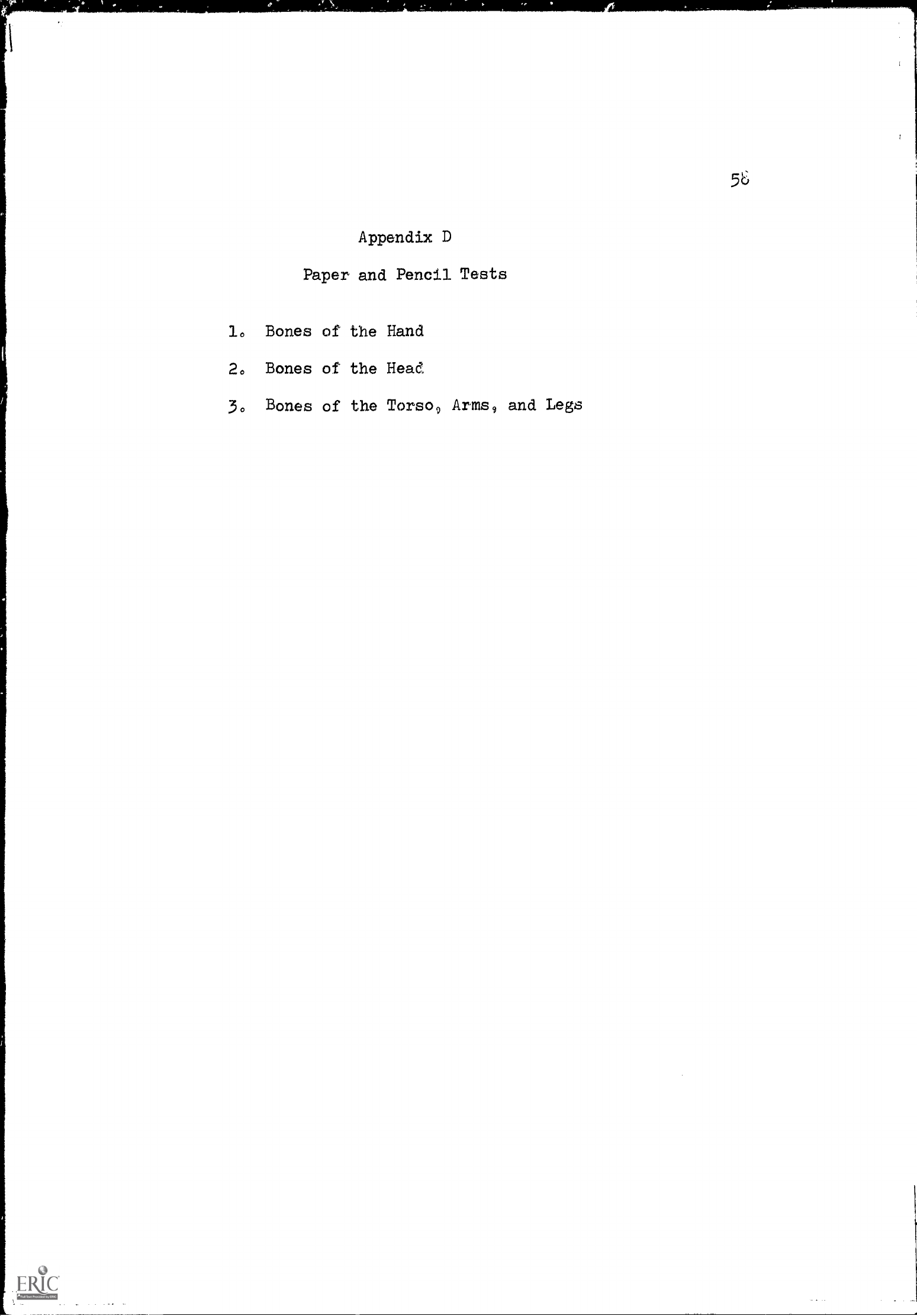
Appendix D
Paper and Pencil Tests
10
Bones of the Hand
2.
Bones of the Head
30
Bones of the Torsos, Arms9 and Legs
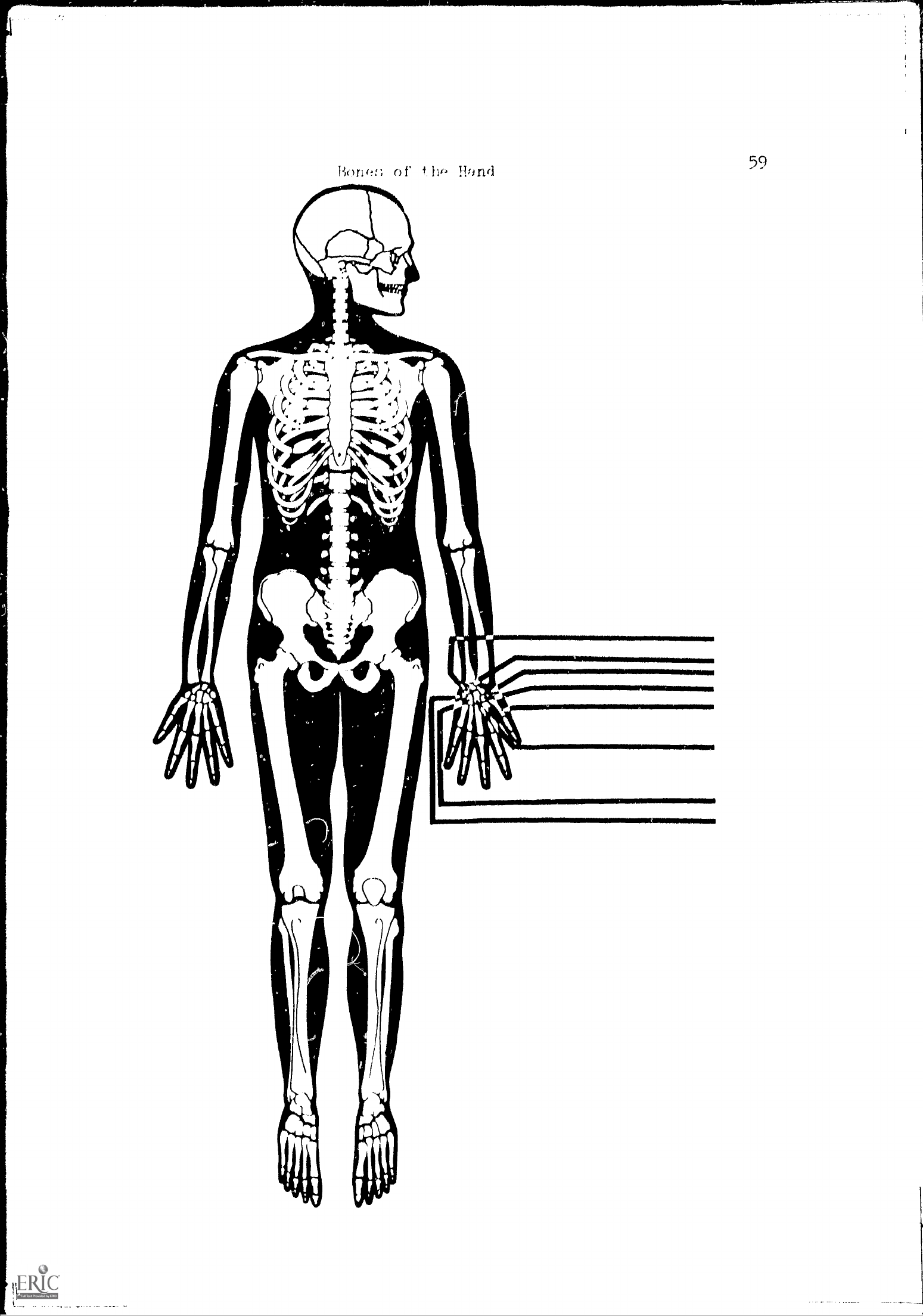
Tor(.; t
Hwy]
59
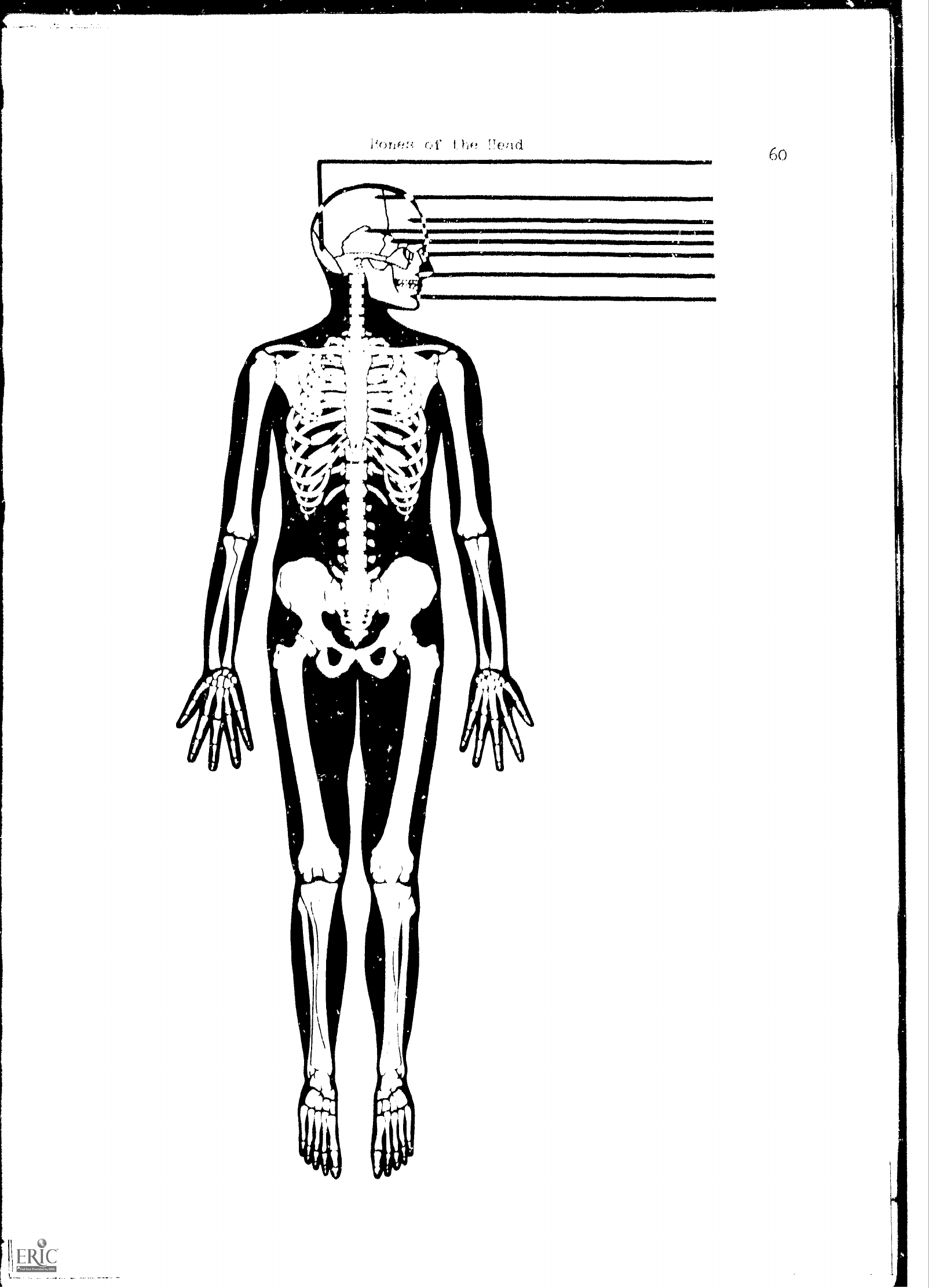
6o
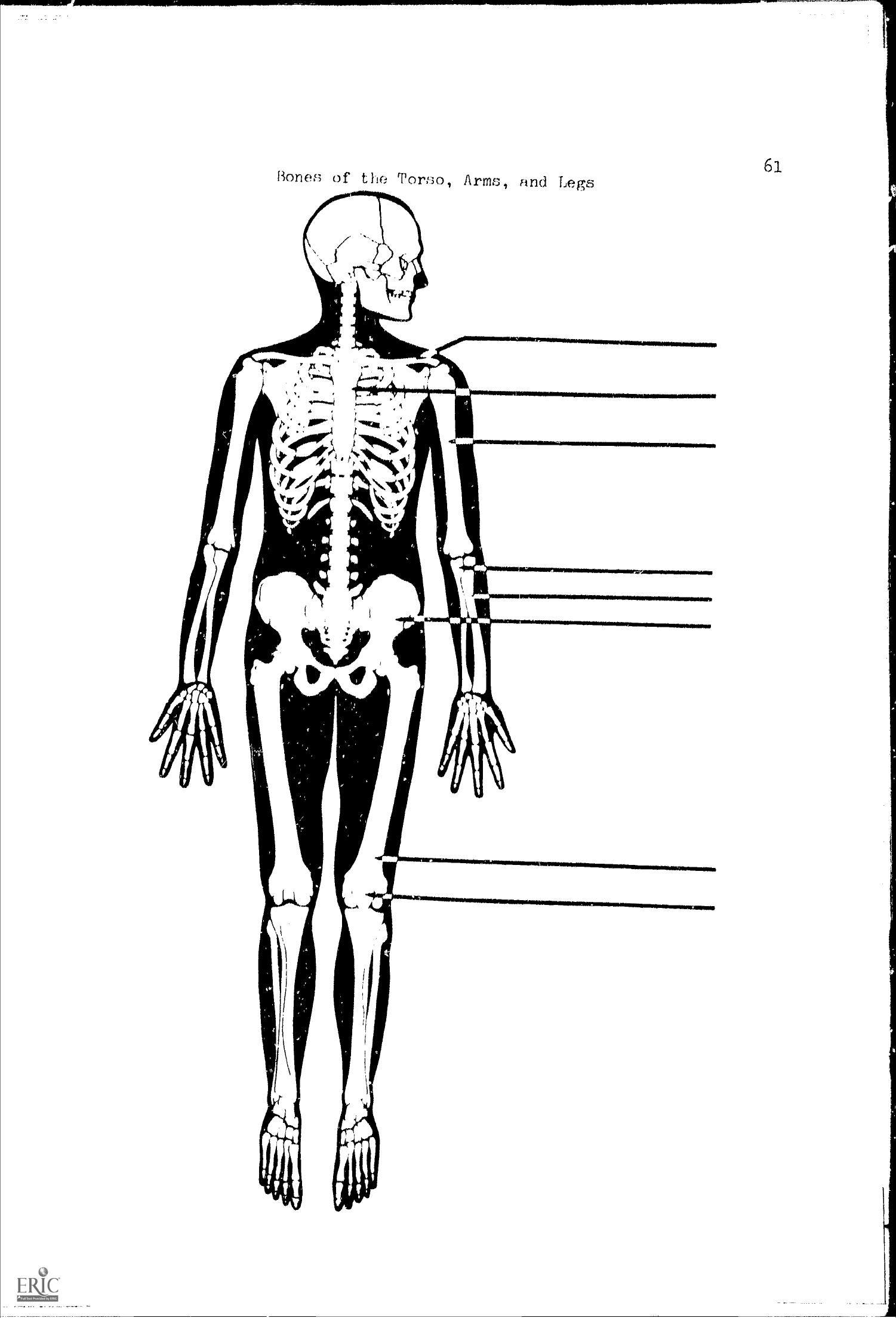
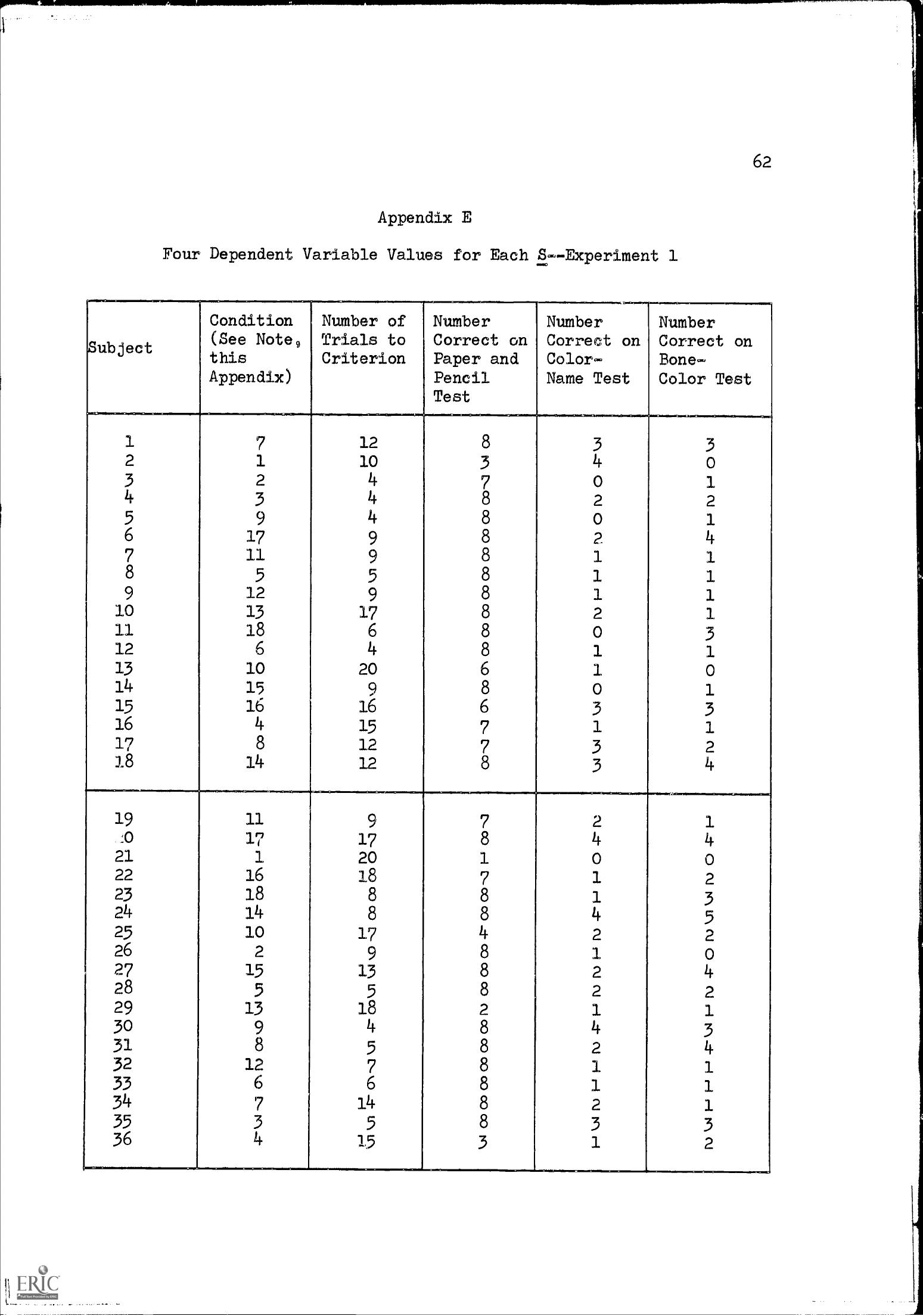
62
Appendix E
Four Dependent Variable Values for Each S--Experiment 1
ubject
Condition
(See Notes
this
Appendix)
Number of
Trials to
Criterion
Number
Correct on
Paper and
Pencil
Test
Number
Correct on
Color
Name Test
Number
Correct on
Bone-
Color Test
1
7
12
8
3
3
2
1
10
3
if
0
3
2
if
7
0
1
if
3
if
8
2
2
5
9
if
8
0
1
6
17
9
8
2 if
7
11
9
8
1
1
8
5
5
8
1
1
9
12
9
8
1
1
10
13
17
8
2
1
11
18
6
8
0
3
12
6
if
8
1
1
13
10
20
6
1
0
14
15
9
8
0
1
15
16
16
6
3
3
16
if
15
7
1
1
17
8
12
7 3
2
18
14
12
8
3
if
19
11
9
7
2
1
JO
17
17
8
if
if
21
1
20
1
0
0
22
16
18
7
1
2
23
18
8
8
1
3
24
14
8
8
4
5
25
10
17
if
2
2
26
2
9
8
1
0
27
15
13
8
2
if
28
5
5
8
2
2
29
13
18
2
1
1
30
9
if
8
if
3
31
8
5
8
2
if
32
12
7
8
1
1
33
6
6
8
1
1
34
7
14
8
2
1
35
3
5
8
3
3
36
if
15
3
1
2
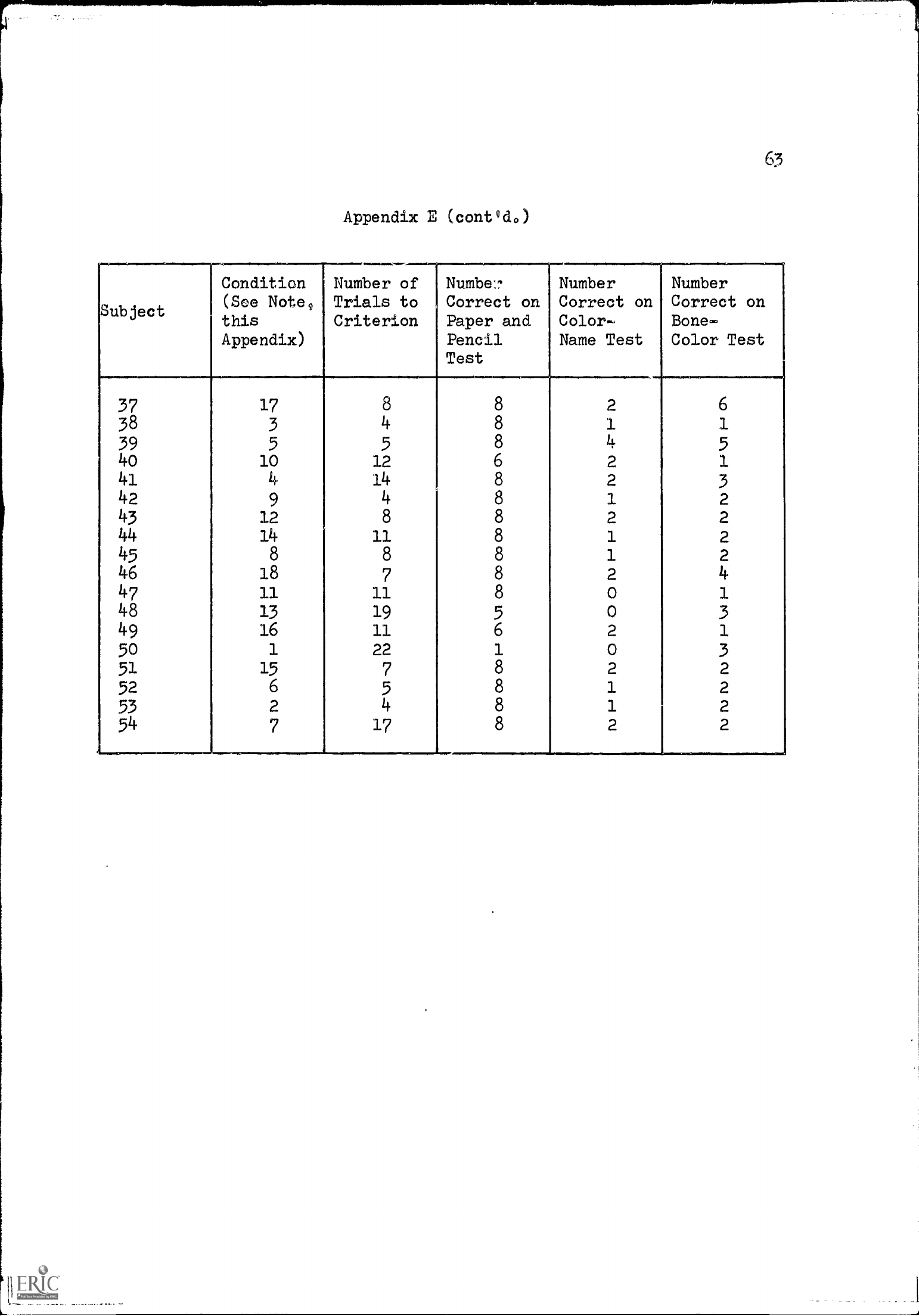
Appendix E (cont°d.)
Subject
Condition
(See Note9
this
Appendix)
Number of
Trials to
Criterion
Numbe:7
Correct on
Paper and
Pencil
Test
Number
Correct on
Color-
Name Test
Number
Correct on
Bone-
Color Test
37
17
8
8
2
6
38
3
4 8
1 1
39 5
5
8 4
5
40 10
12 6
2
1
41 4
14
8
2
3
42
9
4 8
1 2
43
12
8 8
2 2
44
14 11 8 1
2
45 8
8 8 1
2
46 18
7
8
2 4
47
11 11
8 0 1
48
13 19
5
0
3
49
16 11
6
2
1
50 1
22
1 0
3
51
15
7
8
2
2
52
6
5
8 1
2
53
2
4 8 1
2
54
7
17
8
2
2
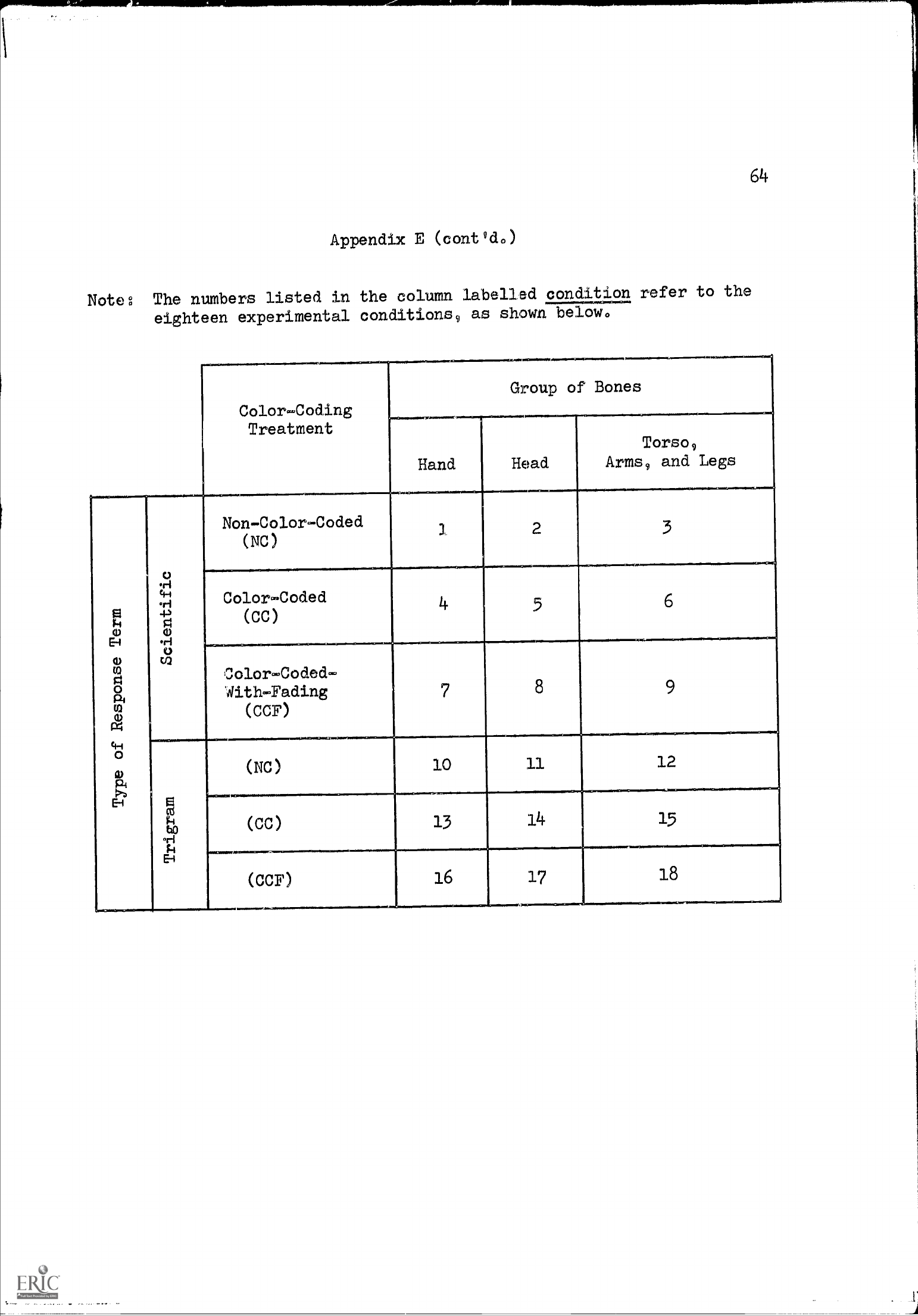
Appendix E (cont'do)
Note
The numbers listed in the column
labelled condition refer to the
eighteen experimental conditions9 as
shown below°
64
Color-Coding
Treatment
1--------
Hand
Group of Bones
Head
Torso9
Arms9 and Legs
N
0
Ei
0
0
g
R,
m
0
c4
44
0
0
E-i
o
.1.4
4-1
0
0
.H
VI
Non-Color-Coded
(NC)
2
3
Color-Coded
(CC)
4
5
6
Color -Coded -
With-Fading
(ccF)
7
8
9
la
as
El°
k
n,
r.
E-I
_____
(Nc)
-----
10
11
12
(CC)
13
14
15
(ccF)
16
17
18

65
Appendix F
Analysis of Variance of Number of
Trials to Reach Criterion
as a Function of
Color-Coding Treatment
(C)9 Group of
Bones (G)9 and Type of Response
Term (R)
Source
SS
df
MS
F
req.
F
obt.
.05
Color-Coding Treatment (C)
Group of Bones (G)
Type of Response Term (R)
C X G
C X R
G X R
CXGXR
error
1.815
2
.907
3.23
<1
9140370
2 457°185
3.23
580090*
115.574
1
1150574
40o8
14.685*
420519
4
10.630
2061
10351
15593
2
70796
3023
<1
250482
2
120741
3.23
10619
5.185
4
1.296
2061
<1
283333
36
70870
*Statistically significant0
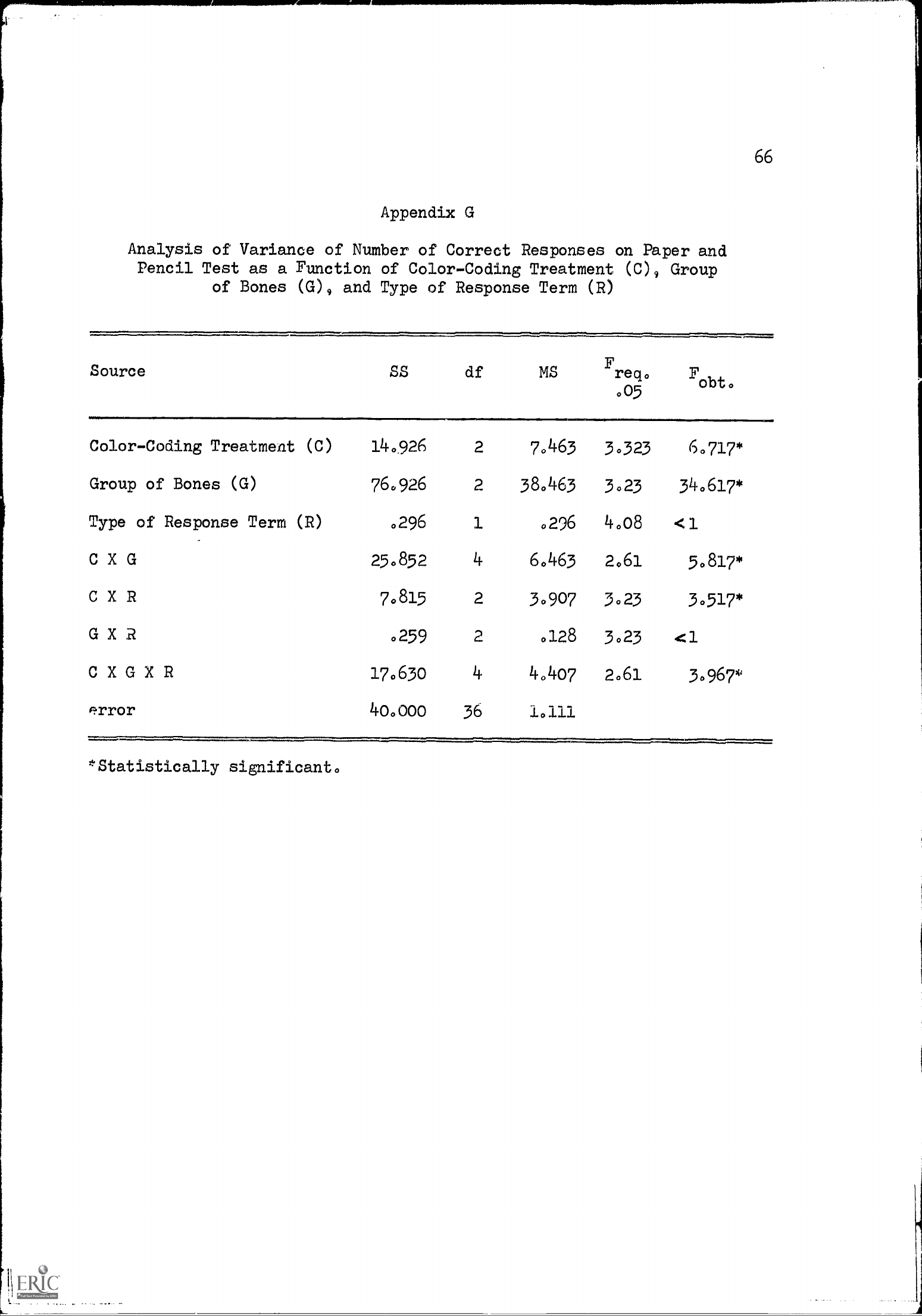
66
Appendix G
Analysis of Variance of Number of Correct Responses on Paper and
Pencil Test as a Function of Color-Coding Treatment (C)9 Group
of Bones (G)9 and Type of Response Term (R)
Source
SS
df
MS
F
req.
F
obt.
.05
Color-Coding Treatment (C)
14.926 2 7.463
3.323
6.717*
Group of Bones (G)
76.926
2 38.463
3.23
34.617*
Type of Response Term (R)
.296
1
0296
4008
<1
C x G
25.852 4
6.463
2061
5,817*
C X R
7.815
2
3,907
3,23
3.517*
G X R
.259
2
.128 3.23
4c1
C X G X R
17.630
4
4.407
2.61
3.967*
error
40.000
36 1.111
*Statistically significant.
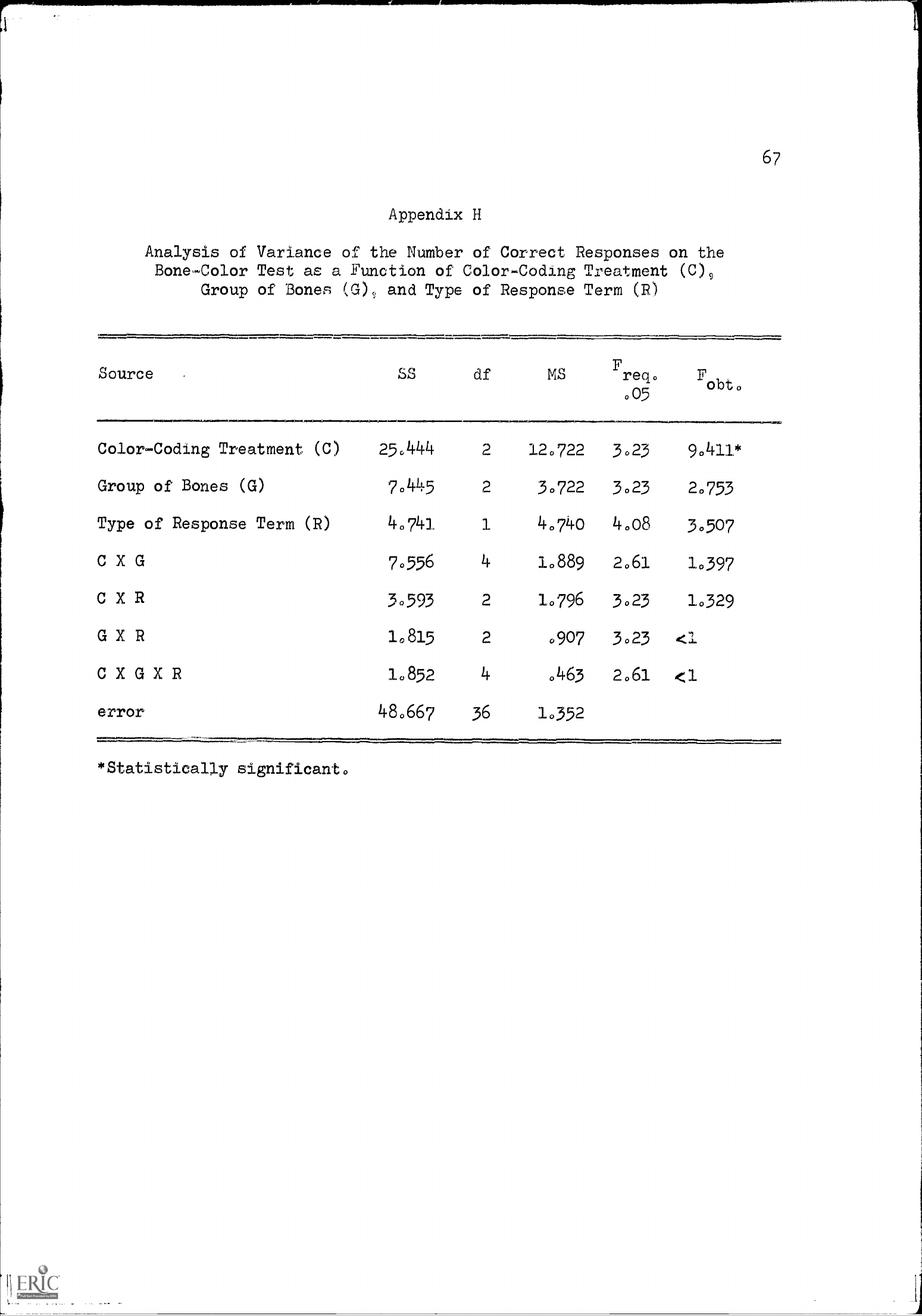
Appendix H
Analysis of Variance of the Number of Correct Responses on the
Bone-Color Test as a Function of Color-Coding Treatment (C)9
Group of Bones (G)9 and Type of Response Term (R)
I10141*
67
Source
re,
00
df
MS
F
req.
.05
Color-Coding Treatment (C)
25444
..ILIMEM
2 12.722
3023
Group of Bones (G)
70445
2
30722
3023
Type of Response Term (R)
40741
1 40740
4008
C X G
7.556
4 10889 2.61
C X R
3 593
2
1.796 3.23
G x R
1.815
2
.907
3.23
C X G X R
1.852
4 .463
2.61
error
48.667
36 1.352
*Statistically significant.
F
obt.
90411*
20753
30507
1.397
1.329
<L
<1
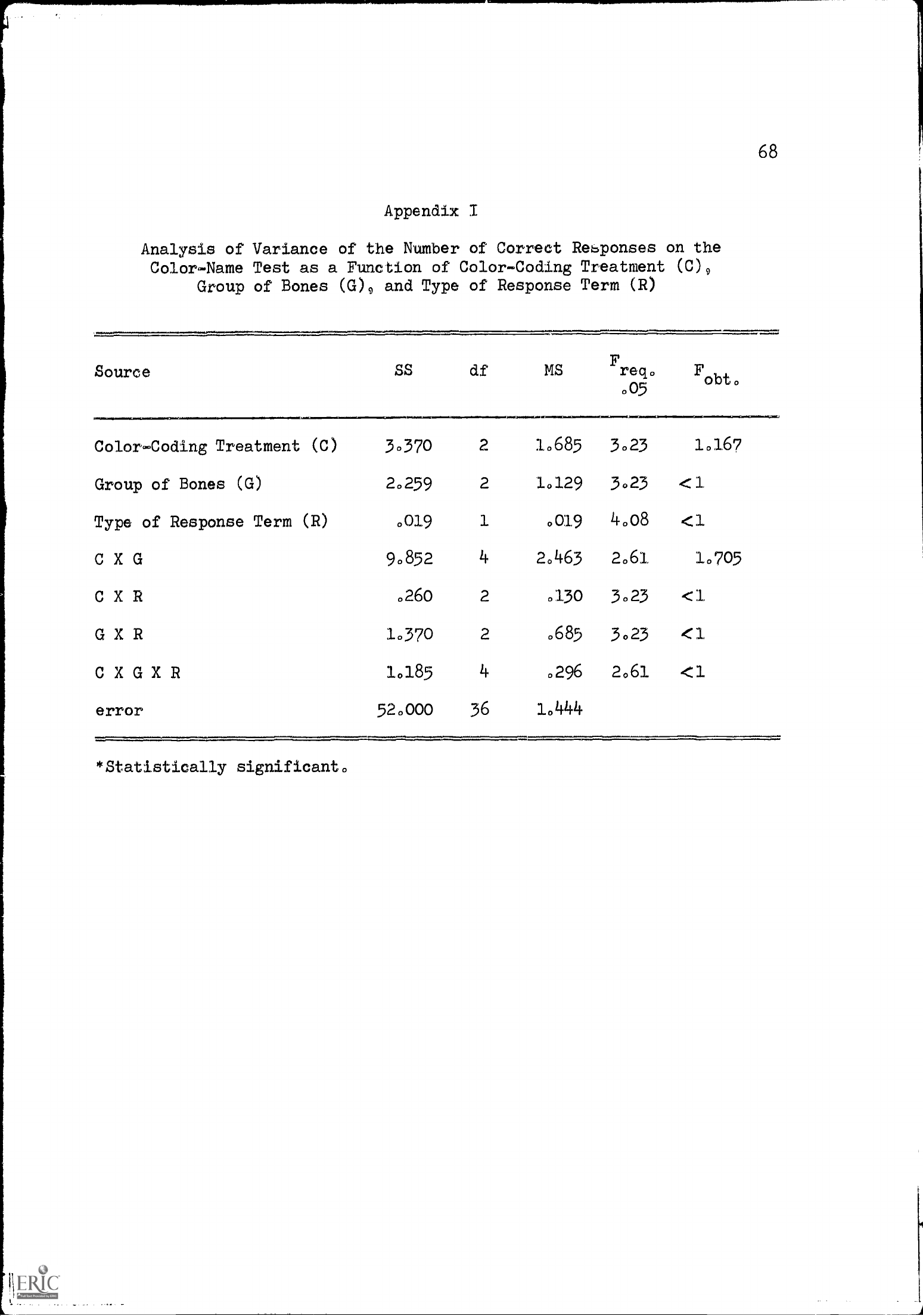
aniMMINEMPFM.
Appendix
Analysis of Variance of the Number of Correct Rebponses on the
Color-Name Test as a Function of Color-Coding Treatment (C)9
Group of Bones (G)9 and Type of Response Term (R)
68
SS
Color-Coding Treatment (C)
Group of Bones (G)
Type of Response Term (R)
C X G
C X R
G X R
CXGXR
error
df
MS
Imlinolukamm-11064...
3037o
20259
0019
90852
0260
10370
10185
F
req.
F
obt.
.05
2 1685
2 10129
1
.019
4
24463
2
0130
2 0685
4
0296
520000
36
10444
3023
10167
3023
4:1
40o8
<1
2061
10705
3023 <1
3023
<1
2061
<1
* Statistically significant.

69
Appendix J
Instructions to Subjects--Experiment 2g
Color-Coded Conditions
I'm going to show you a series of slides on the screen in front of
you.
You will notice that each slide contains the picture of a human
skeleton and that there io an arrow pointing to one bone.
There are two
slides for each of eight different bones. One is labelled with an X and
the other with a nnique name for that bone.
Your task will be to learn
the name of each of the eight bones that will be presented.
There are eight different bones as well as eight unique names.
Each bone will be shown first labelled with an X and then labelled with
its own correct name.
Beginning with the very first slide that has a bone labelled with
an X9 I'd like you to respond aloud with the name you think is associated
with that bone.
Please respond while the slide with an X is on the
screen.
The slide with the correct name will then be presented so that
you can check your answer.
We have found in a past experiment that color coding can help reduce
the number of trials required to learn this type of material.
The color
can help yr7,a separate out the bones.
Therefore9 please note that each of
the shapes has been given a unique color.
You should use these colors to
help you learn the eight bones in this experiment.
However9 I want to
caution you that
(Notes
The following was read only to Ss in the color-coded [CC] condi-
tions.)
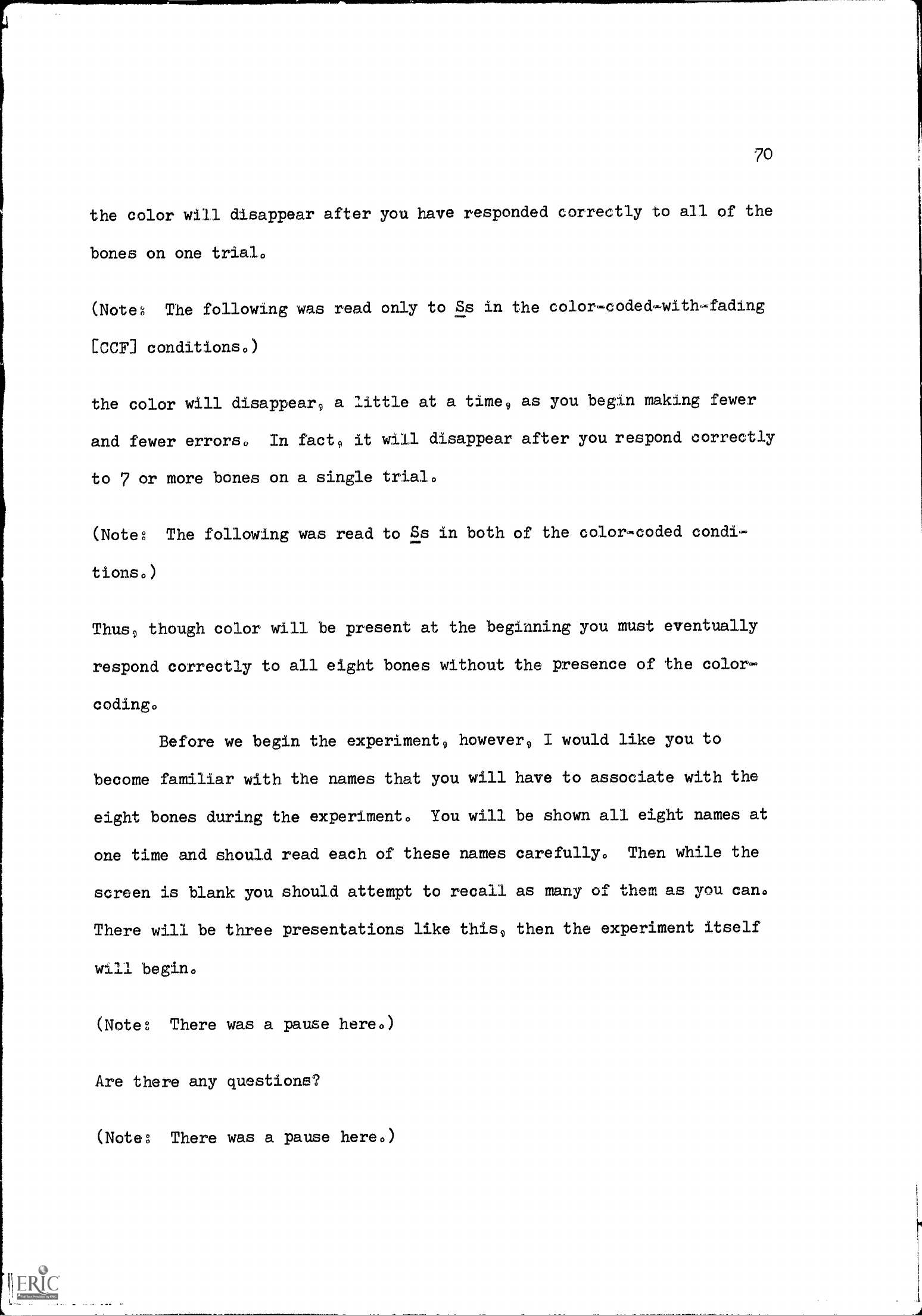
70
the color will disappear after you have responded
correctly to all of the
bones on one trial.
(Noteg
The following was read only to Ss in the
color-coded-with-fading
ECCF] conditions.)
the color will disappears a little at a time9 as you
begin making fewer
and fewer errors.
In facts it will disappear after you respond correctly
to 7 or more bones on a single trial.
(Noteg
The following was read to Ss in both of the color-coded condi-
tions.)
Thus9 though color will be present at the beginning you must eventually
respond correctly to all eight bones without the presence of the color-
coding.
Before we begin the experiments however9 I would like you to
become familiar with the names that you will have to associate with the
eight bones during the experiment.
You will be shown all eight names at
one time and should read each of these names
carefully.
Then while the
screen is blank you should attempt to recall as many of
them as you can.
There will be three presentations like this9 then the experiment itself
will begin.
(Note:
There was a pause here.)
Are there any questions?
(Noteg
There was a pause here.)

71
OK, now remember, after the three slides containing the names
alone, I will show you eight bones one at a time and you should associ-
ate one of the names with each bone.
Please be sure to respond aloud
while the slide labelled with an X is still, on the screen.
(Notes
There was a pause here.)
Do you have any questions?
(Notes
At this point the experiment began.
After S reached criterion
the following instructions were read.)
You have now learned the names of all the bones but I'd like you
to do just a couple of other things.
First, I would like you to label
each of the bones on this sheet of paper.
(Notes
At this point the subject was handed a pencil and piece of paper
on which a skeleton had been mimeographed.
He was given as much time as
he needed to label all eight bones.
Then the two following instructions
were given [in an order randomly assigned to each subject].
Following
each instruction the appropriate test was given.)
(1) Now I'm going to show you the bones again, one at
a time, and I'd
like you to tell me in each case what color you think might be associ-
ated with that bone.
(2) Finally, I'm going to show
you
one at a time, eight colors that
might be associated with the eight bones, and I'd like you to tell me in
each case the name of the bones that you think go with each color that
you see.
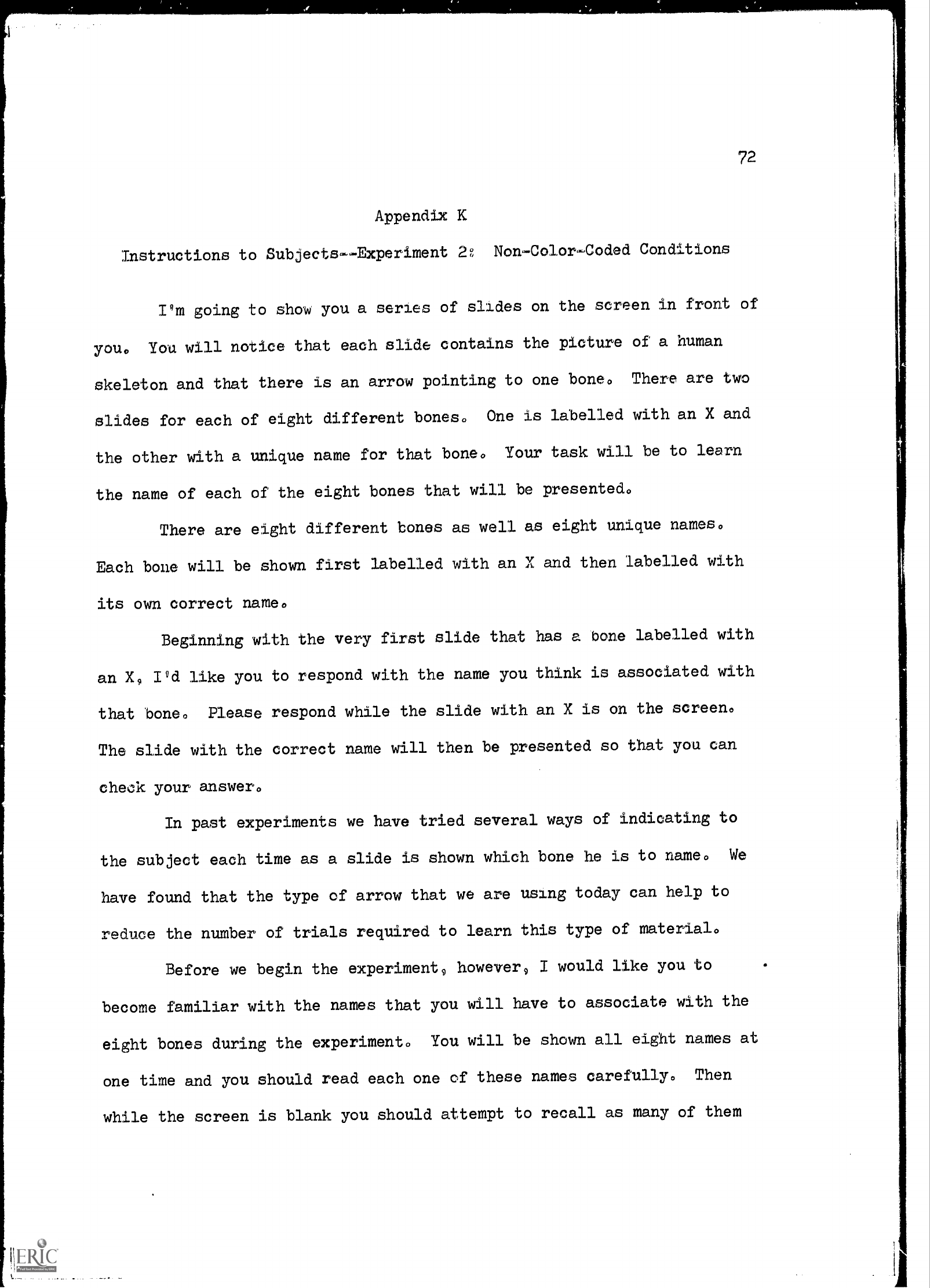
72
Appendix K
Instructions to Subjects
Experiment 2
Non-Color-Coded Conditions
I'm going to show you a series
of slides on the screen in front of
you.
You will notice that each slide
contains the picture of a human
skeleton and that there is an arrow
pointing to one bone.
There are two
slides for each of eight different
bones.
One is labelled with an X and
the other with a unique name for
that bone.
Your task will be to learn
the name of each of the eight
bones that will be presented.
There are eight different bones as
well as eight unique names.
Each bone will be shown first
labelled with an X and then labelled with
its own correct name.
Beginning with the very first slide that
has a bone labelled with
an X, I'd like you to
respond with the name you think is
associated with
that bone.
Please respond while the slide with an
X is on the screen.
The slide with the correct name will then be
presented so that you can
cheek your answer.
In past experiments we have tried several ways
of indicating to
the subject each time as a slide is
shown which bone he is to name.
We
have found that the type of arrow that we are using
today can help to
reduce the number of trials required to
learn this type of material.
Before we begin the experiment, however, I
would like you to
become familiar with the names that you
will have to associate with the
eight bones during the experiment.
You will be shown all eight names at
one time and you should
read each one of these names
carefully.
Then
while the screen is blank you should attempt
to recall as many of them
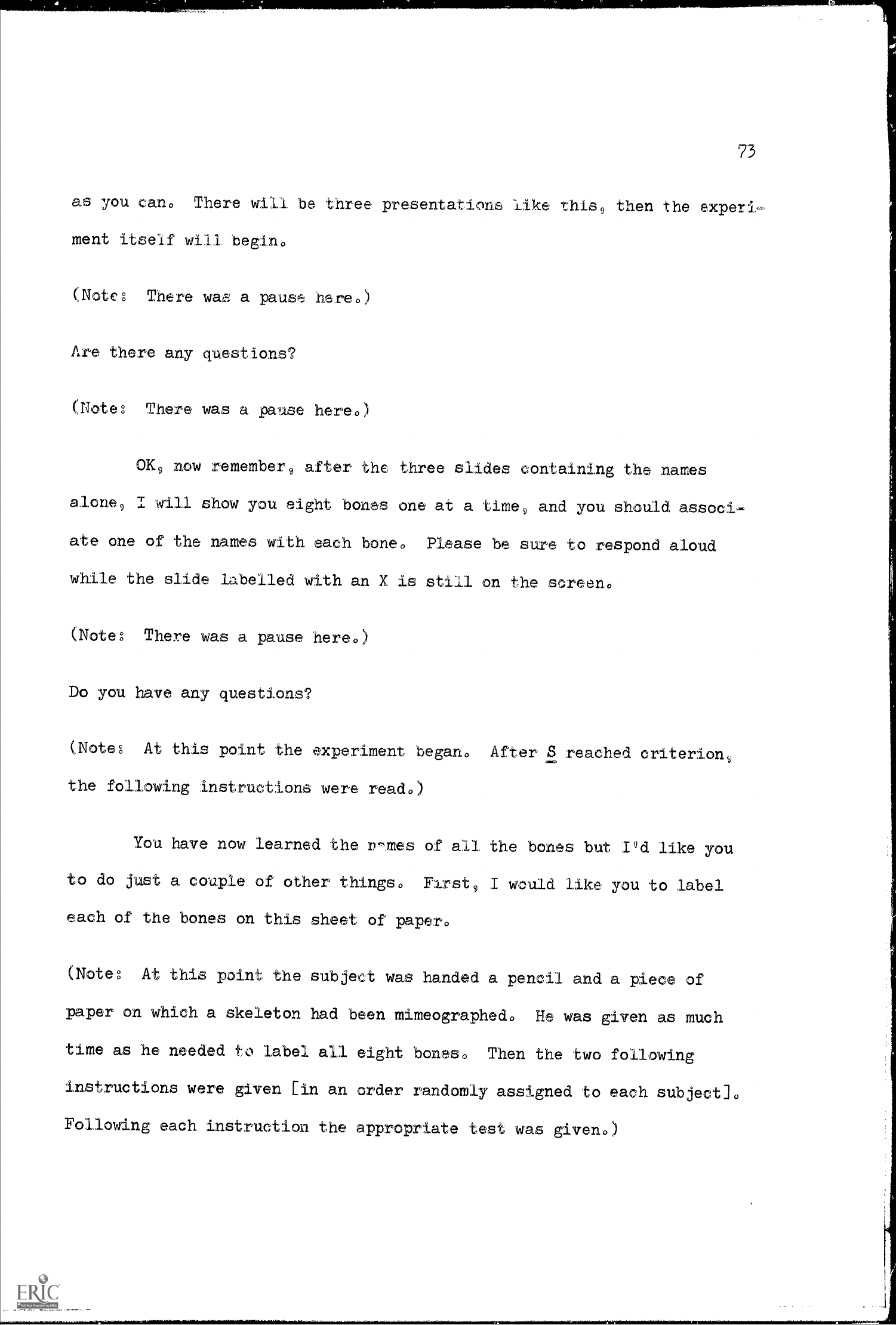
73
as you can.
There will be three presentations like this, then
the experie
ment itself will, begin.
(Notes
There was a pause here.)
Are there any questions?
(Notes
There was a pause here.)
OK, now remember, after the three slides
containing the names
alone, I will show you eight bones
one at a time, and you should associ-
ate one of the names with each bone.
Please be sure to respond aloud
while the slide labelled with
an X is still on the screen.
(Notes There was a pause here.)
Do you have any questions?
(Notes
At this point the experiment began.
After S reached criterion,
the following instructions
were read.)
You have now learned the
vemes of all the bones but I'd like you
to do just a couple of other things.
First, I would like you to label
each of the bones on this sheet of
paper.
(Note
At this point the subject
was handed a pencil and a piec
of
paper on which a skeleton had been mimeographed.
He was given as much
time as he needed to label all eight
bones.
Then the two following
instructions were given [in
an order randomly assigned to each subject].
Following each instruction the
appropriate test was given.)
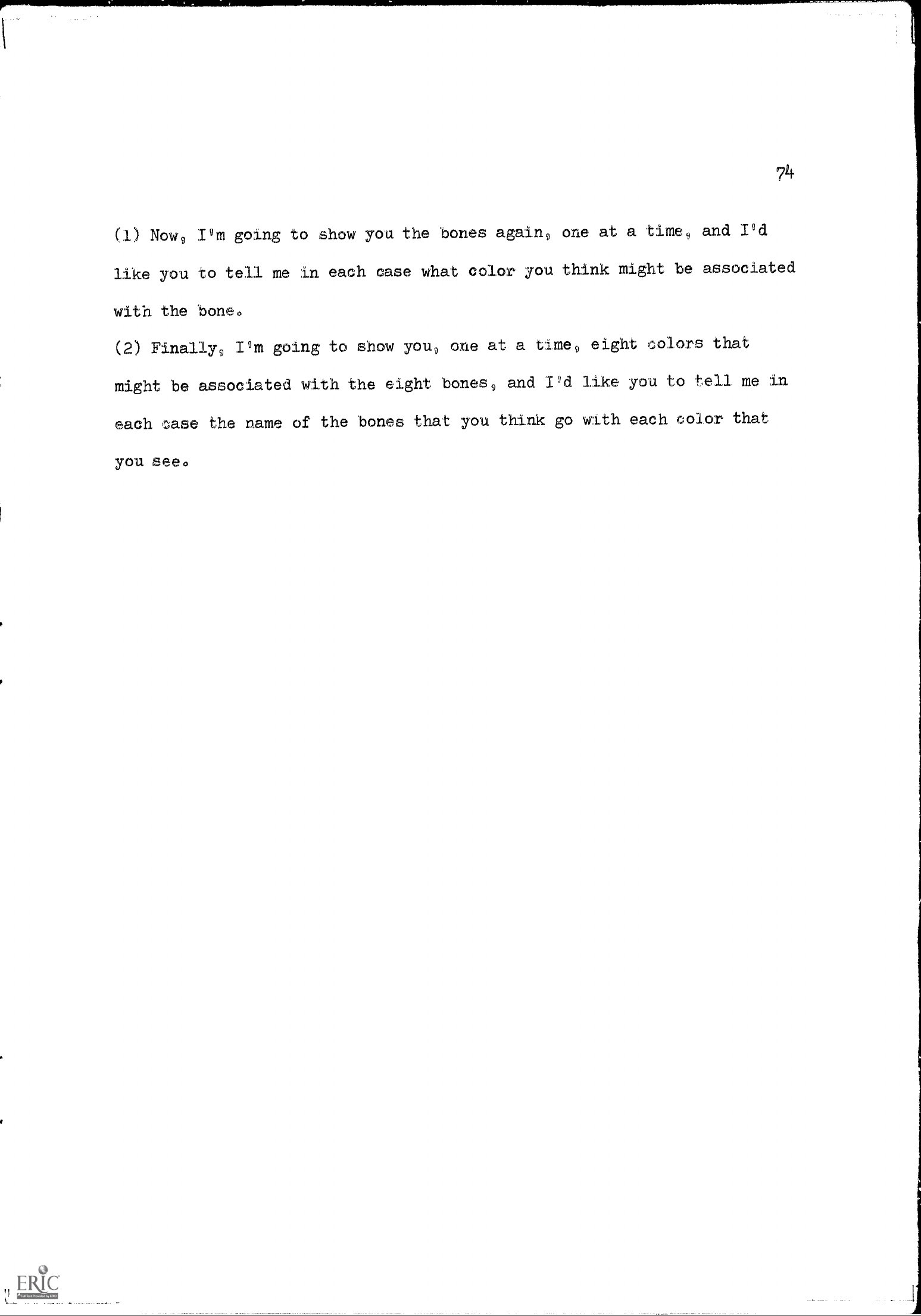
(
) Now, I'm going to show you the bones again, one at a
time, and I'd
like you to tell me in each case what color you
think might be associated
with the bone.
(2) Finally, I'm going to show you9 one at a time, eight
colors that
might be associated with the eight bones,
and I'd like you to tell me in
each case the name of the bones that you
think go with each color that
you see.
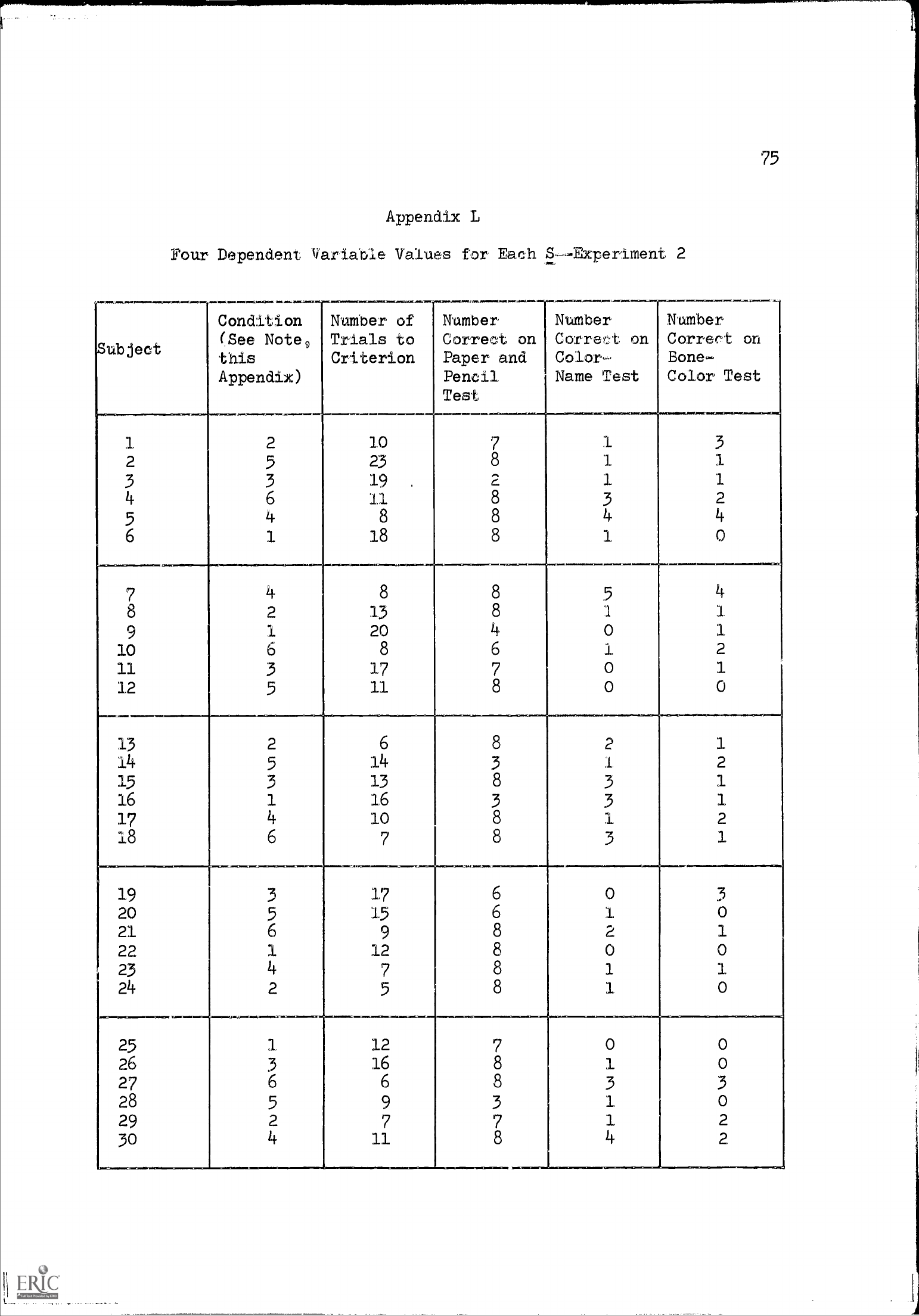
75
Appendix L
Four Dependent Variable Values for Each S--Experiment 2
ubject
Condition
(See Notes
this
Appendix)
Number of
Trials to
Criterion
Number
Correct on
Paper and
Pencil
Test
Number
CorreA on
Color-
Name Test
Number
Correc.t on
Bone-
Color Test
mooFJ
. .
.
MICOMAM...A.MAMMVO
1
2
10
7
1
3
2
5
23
8
1
1
3
3
19 ,
2
1
1
4
6
11
8
3
2
5
4
8
8
4
4
6
1
18
8 1
0
7
4
8
8
5
4
8
2
13 8
a
1
9
1
20
4
0
1
10
6
8
6
1
2
11
3
17
7
0
1
12
5
11
8 0
0
13
2 6
8
2
1
14
5
14
3
1
2
15
3
13 8
3
1
16
1 16
3 3
1
17
4 10 8
1 2
18
6
7
8
3
1
.
.
.
.
..
19
_. . ..
.
3
. ....
17 6
0
3
20
5
15
6 1
0
21
6
9
8
2
1
22
1
12 8
0
0
23
4
7
8
1
a.
24 2
5
8
1
0
_
.
25
_
1 12
7
0 0
26
3
16 8
1
0
27
6
6
8
3 3
28
5
9 3
1
0
29 2
7
7
1
2
30
4 11
8
4
2
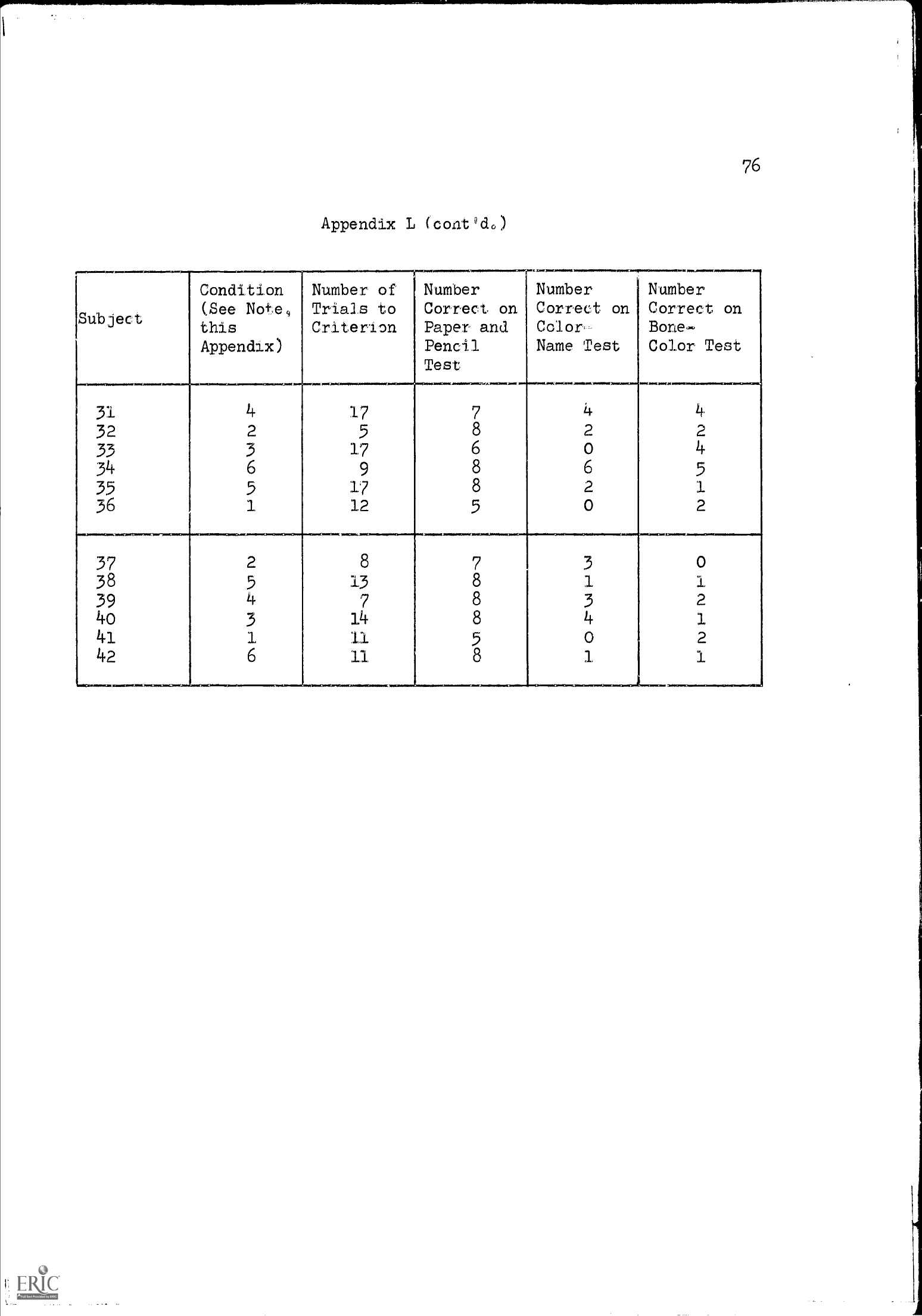
76
Appendix L (coatuclo)
Subject
Condition
(See Note,
this
Appendix)
Number of
Trials to
Criterion
Number
Correct on
Paper and
Pencil
Test
Number
Correct on
Color-
Name Test
Number
Correct on
Bone-
Color Test
.
31
4
17
7
4,
.
4
32
2
5
8
2
2
33
3
17
6 0 4
34
6
9
8 6
5
35 5
17 8 2
1
36
1 12
5
0 2
.---...
. _ , .
________
---..-
.
.
.
37
2
8
7
3
0
38
5
13 8
1
1
39
4
7
8
3
2
4o
3
14 8
4
1
41 1
11
5
0 2
42
6 11 8 1 1
_._ __ ___ _______________
. .
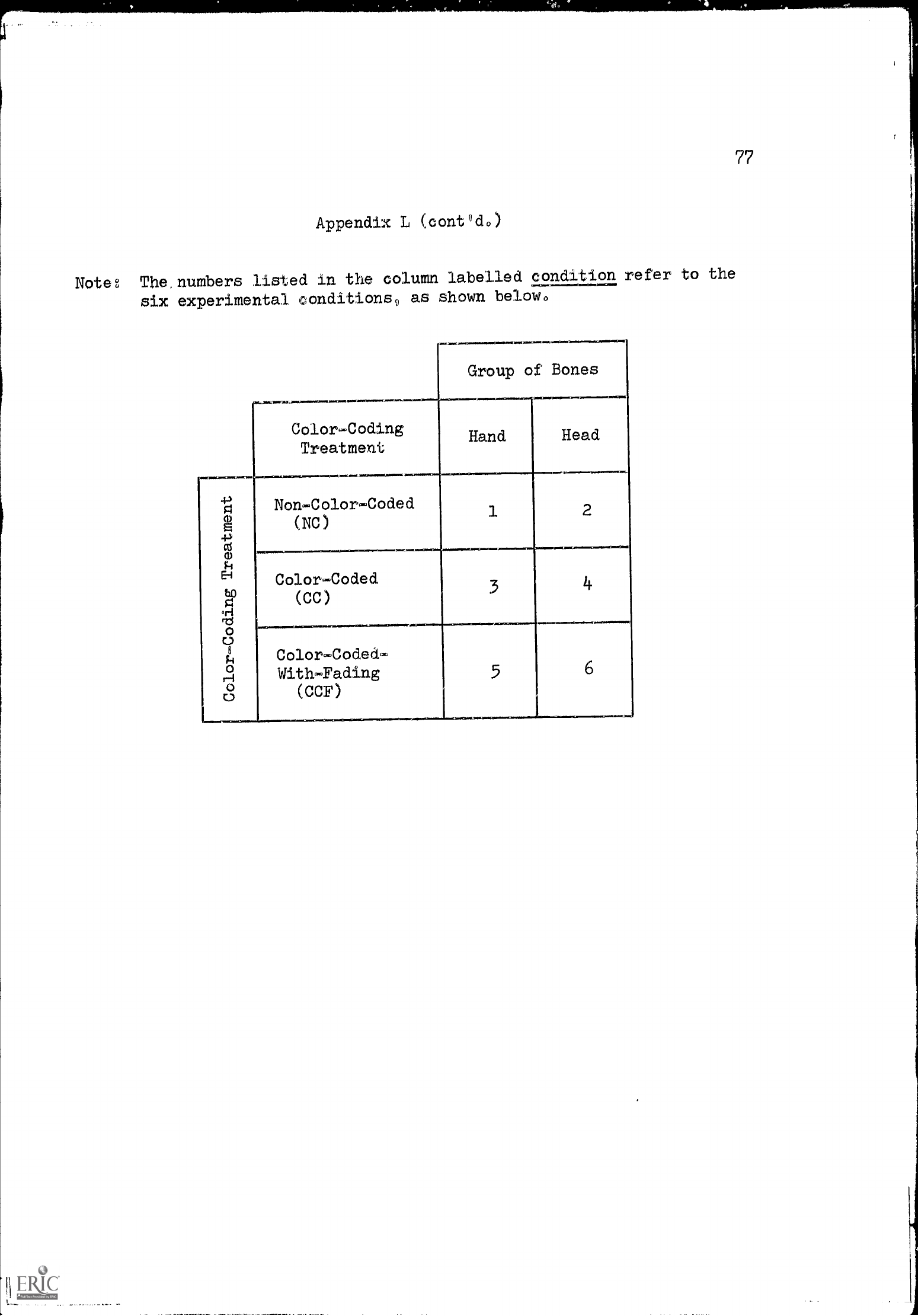
Appendix L (cont'do)
Note
The, numbers listed in the
column labelled condition
refer to the
six experimental conditions9 as
shown below,
Aelle#11470141.M.=71
.7.,70,717,7.10.01ORIMI.WOITMINC7010.0.11,70.411.WAVIO.....6.MPIN
Color-Coding
Treatment
Non-Color-Coded
(NC)
Color-Coded
(CC)
Color-Coded-
With-Fading
(CCF)
Group of Bones
AMIIIIMOMPON0.111r
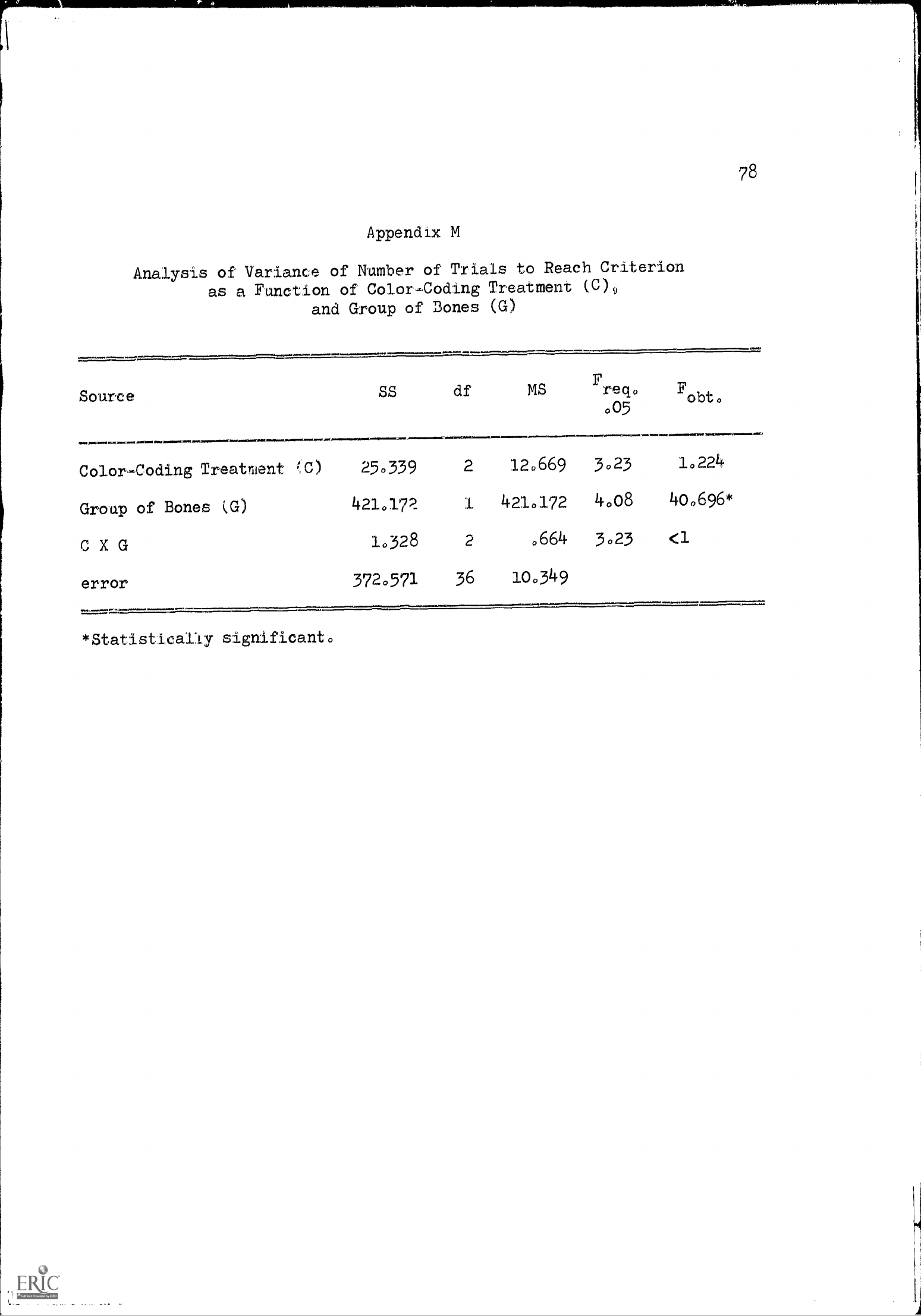
78
Appendix M
Analysis of Variance of Number of
Trials to Reach Criterion
as a Function of
Color-Coding Treatment
(C)9
and Group of Bones
(G)
Source
SS
df
MS
F
req.
F
obt.
.05
.....1....opowrowswoom.0111111111714M.110111011.1111.1111111.11/4111111aNW...././00/00111111[AIT
,1/..7NNIONM/f*PRIB-1WAIMONIILIMMINOMIIII1011.411.1.71111..11021111111711/1111.1114111.1..MMI/NIVOIONLINAI71.(20/NO*2CMIG)
Color-Coding Treatment
C)
25.339
2
12.669
3.23
10224
Group of Bones (G)
421017
1
421.172
4008
4o0696*
C X G
1.328
2
0664
3.23
<1
error
372.571
36
100349
*Statistically significant.
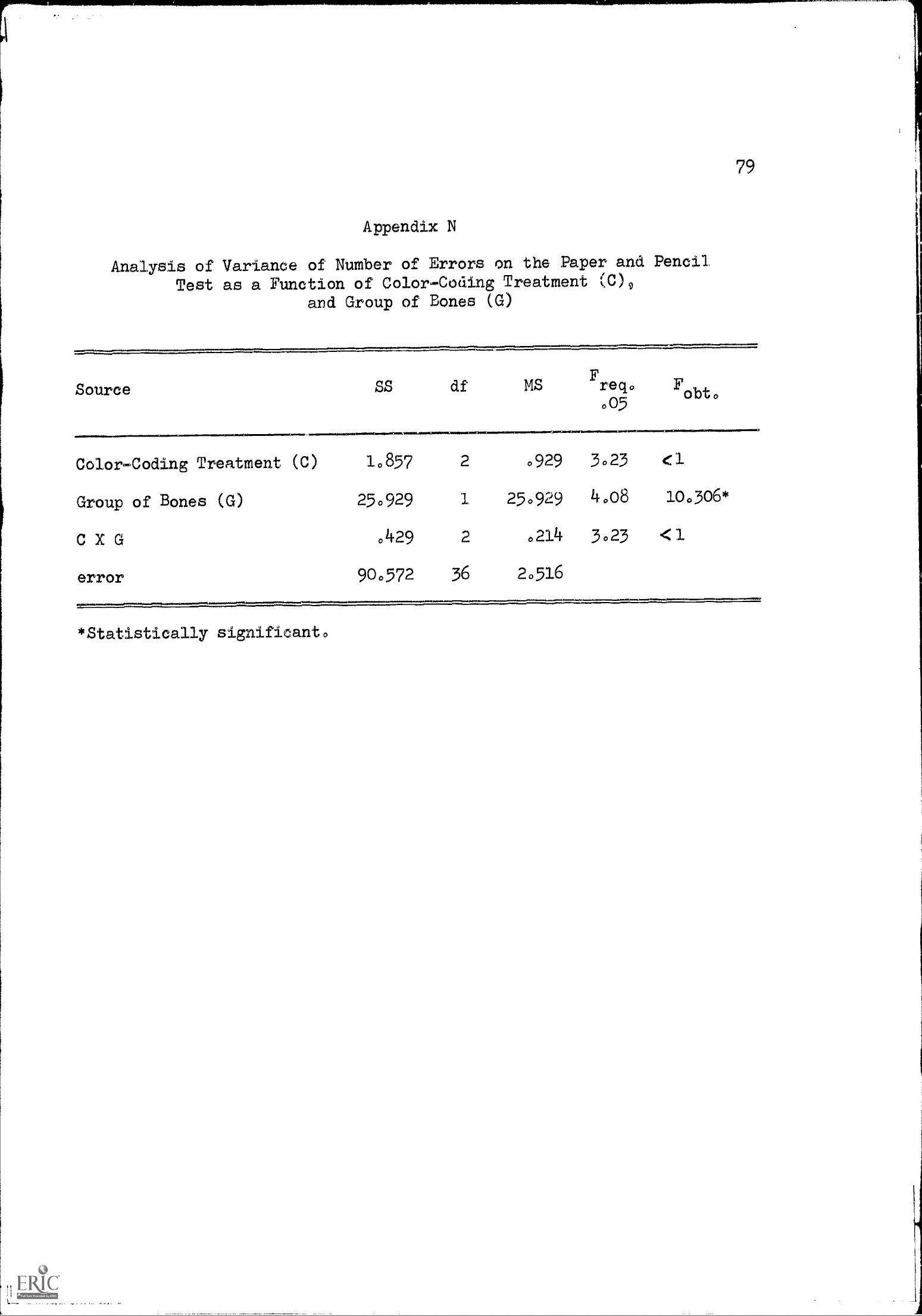
79
Appendix N
Analysis of Variance of Number of Errors on
the Paper and Pencil
Test as a Function of Color-Coding
Treatment (0)9
and Group of Bones (G)
Source
SS
df
MS
F
req.
F
obt.
005
Color-Coding Treatment (C)
Group of Bones (G)
C X G
error
1.857
25.929
.429
90.572
36
2.516
2 0929
3.23
<1
1
25.929
4.o8
1o0306*
2
0214
3023
4 1
* Statistically significant
paymea,......
OMMO!111..I.M1.01.
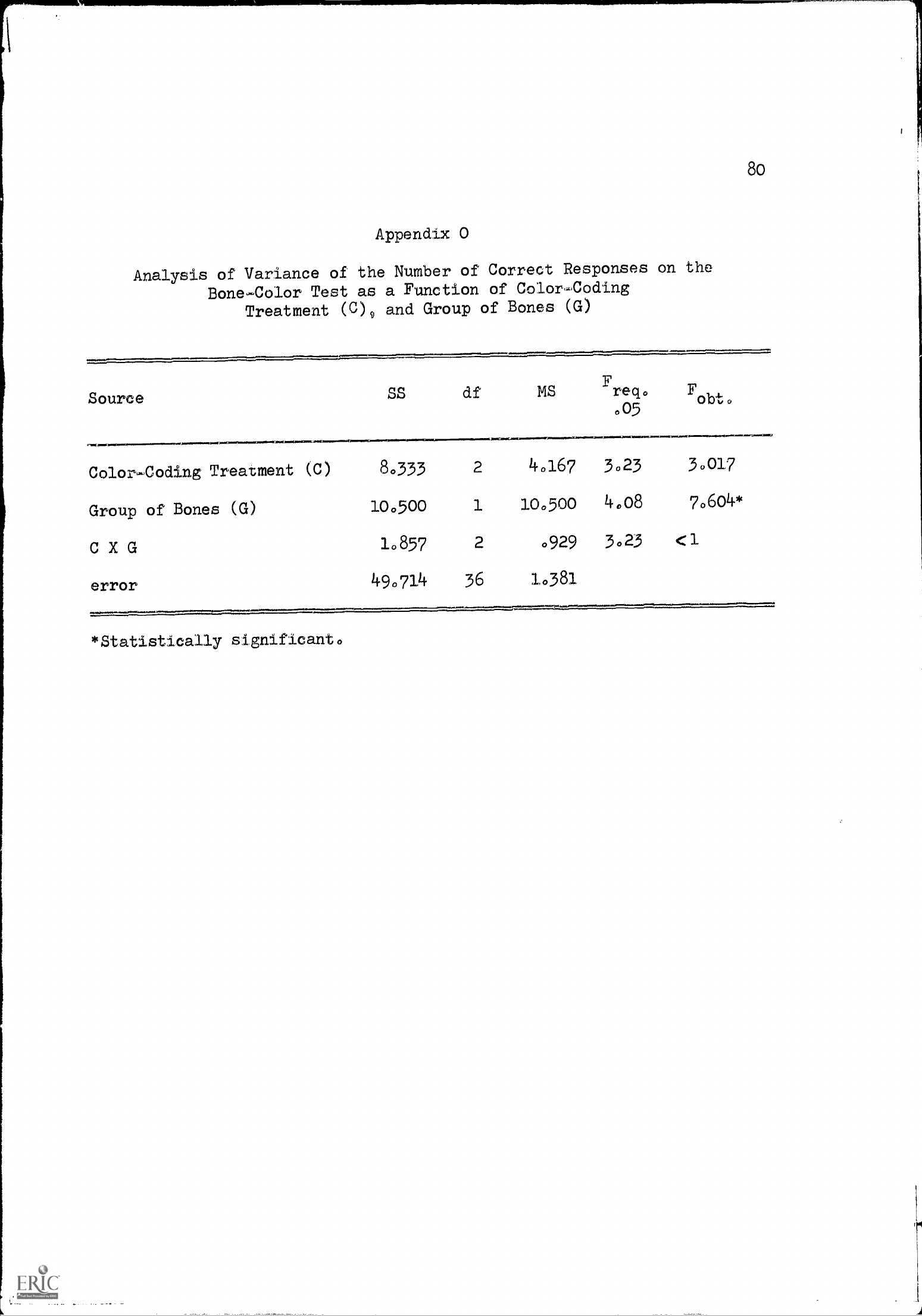
Appendix 0
Analysis of Variance of the
Number of Correct Responses on
the
Bone-Color Test as a
Function of Color-Coding
Treatment (C)9 and Group of
Bones (G)
Source
8o
SS
df
MS
F
req.
F
o.
.05
bt
Color-Coding Treatment
(C)
Group of Bones (G)
C X G
error
80333
2
40167
3423
3.017
100500
1
100500
4.08
70604*
1.857
2
0929
3023
<1
490714
36
10381
*Statistically significant.
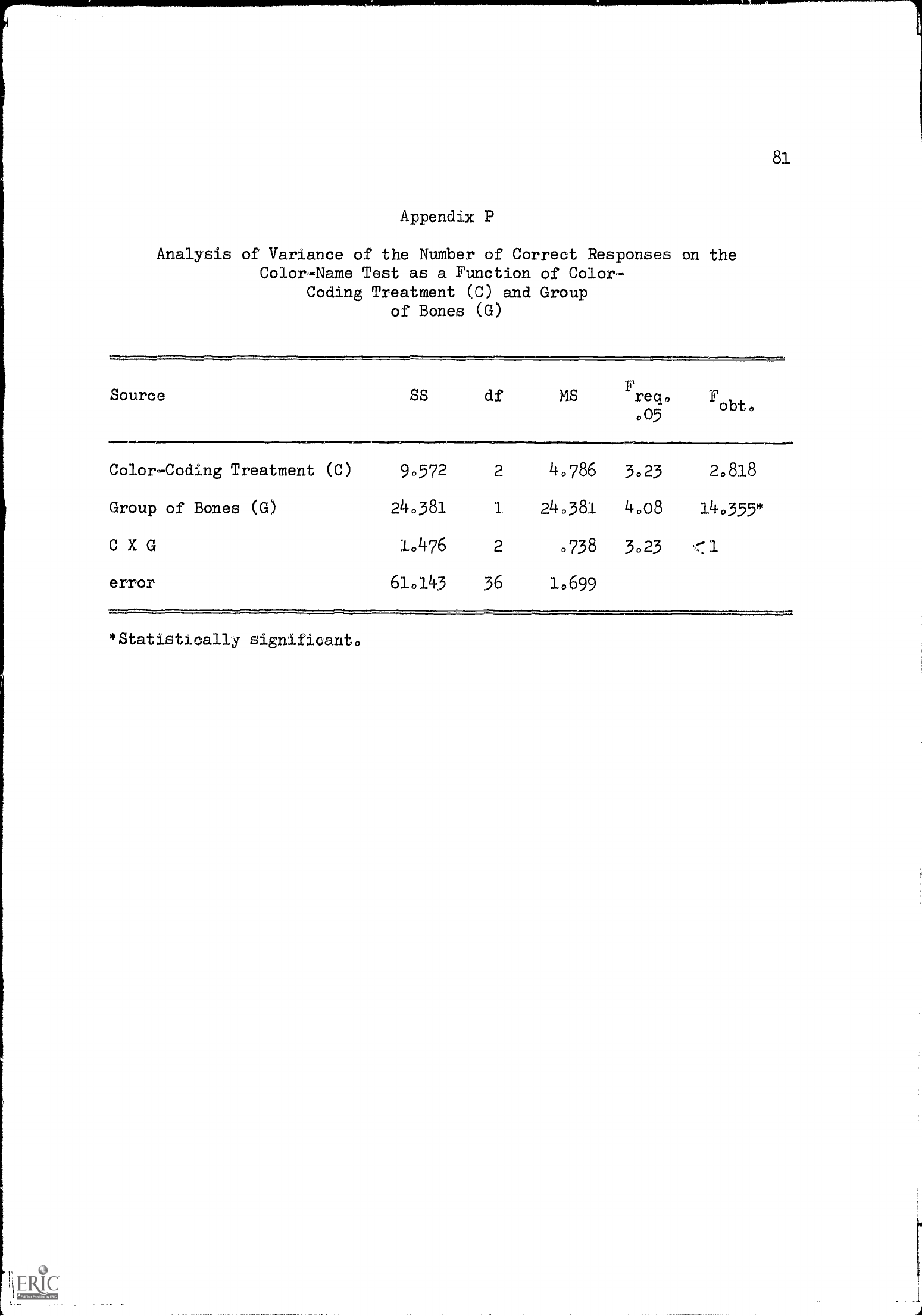
Appendix P
Analysis of Variance of the Number of Correct Responses on the
Color-Name Test as a Function of Color-
Coding Treatment (C) and Group
of Bones (G)
81
Source
SS df
MS
F
req. F
obt,
005
Color-Coding Treatment (C)
90572
2 40786
3023
20818
Group of Bones (G)
240381 1
240381
4008
140355*
C X G
10476 2
0738
3023 1
error
610143
36
10699
*Statistically significant0
